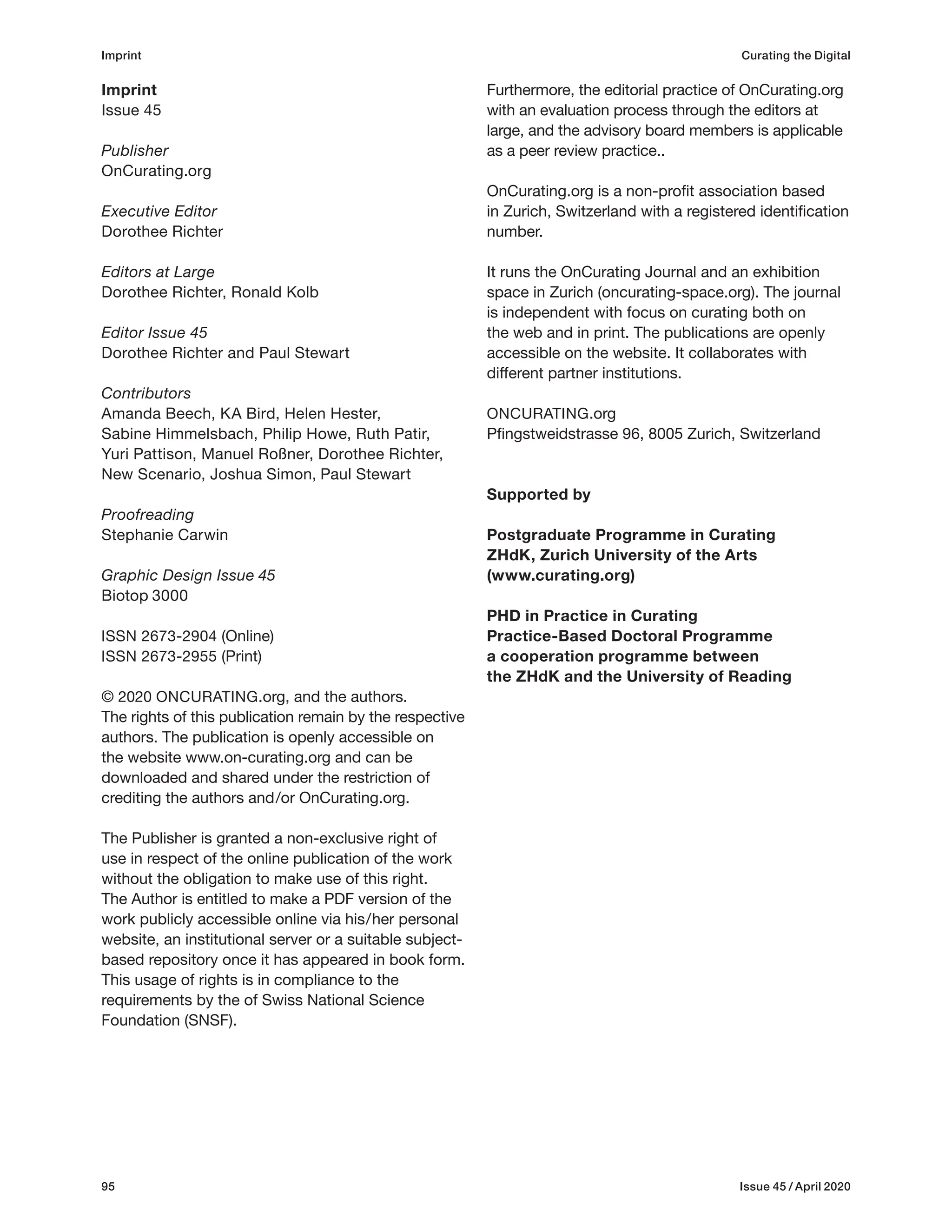This article provides a historical perspective on curating and art practices related to digital technologies. It acknowledges that early exhibitions and discussions of digital art were often male-dominated and excluded feminist approaches. The author aims to weave in more neglected perspectives to present a more complete narrative. Some early milestones discussed include the development of numerical computers in the 1950s for code-breaking, the founding of user groups like SHARE for IBM mainframes in 1955, and Marshall McLuhan's influential book Understanding Media. While highlighting influential exhibitions, the author urges awareness of "hidden parts" that are harder to uncover regarding feminist and marginalized voices in the history of digital art.
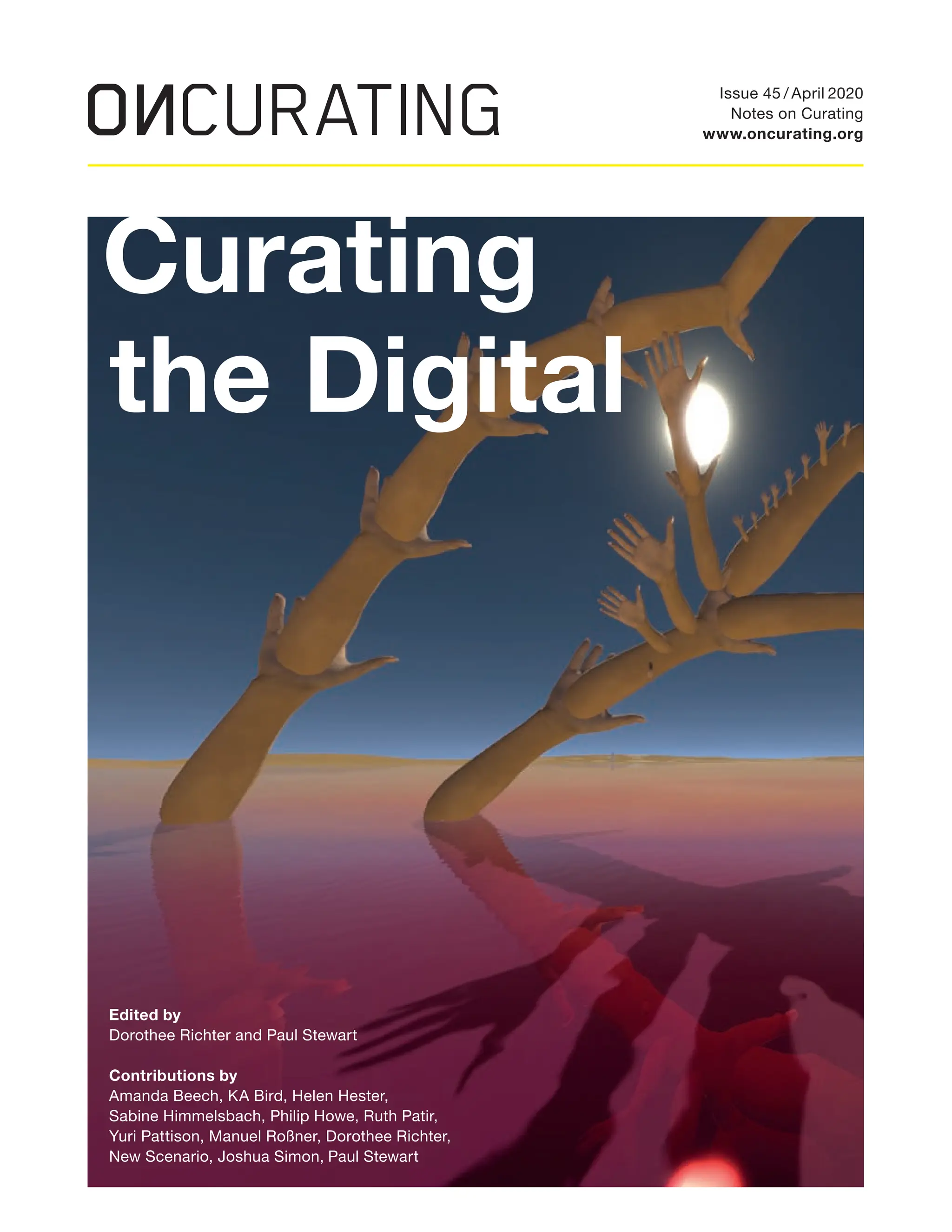

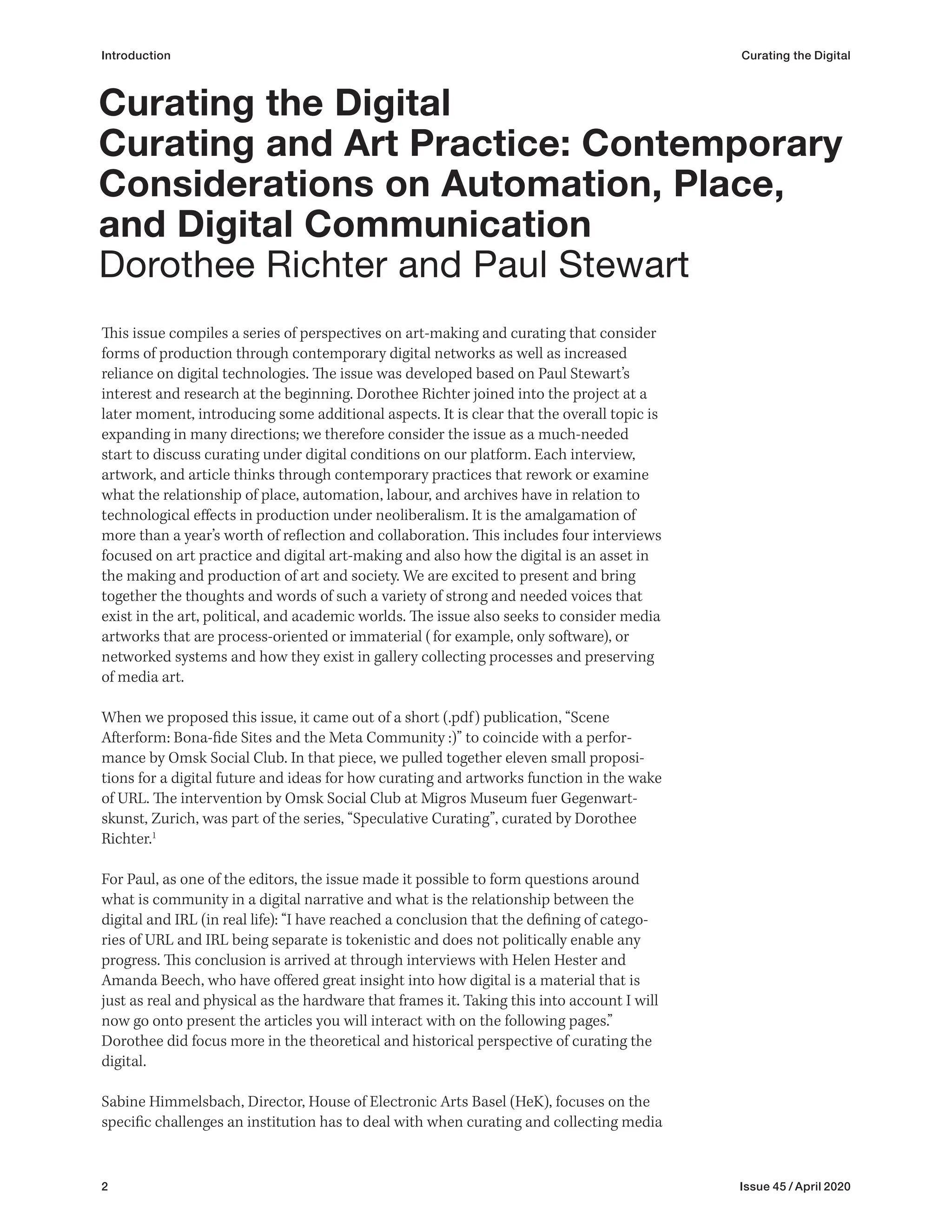
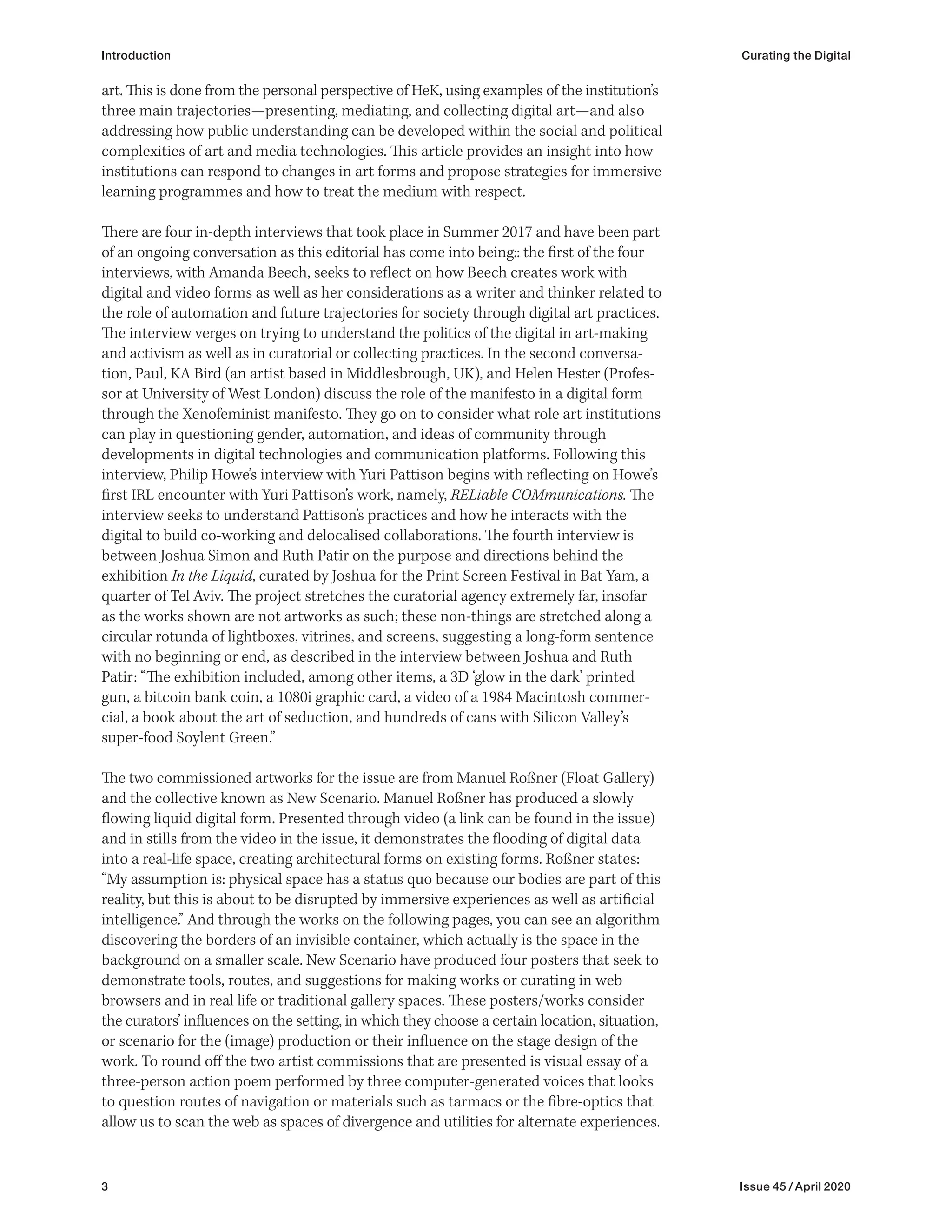

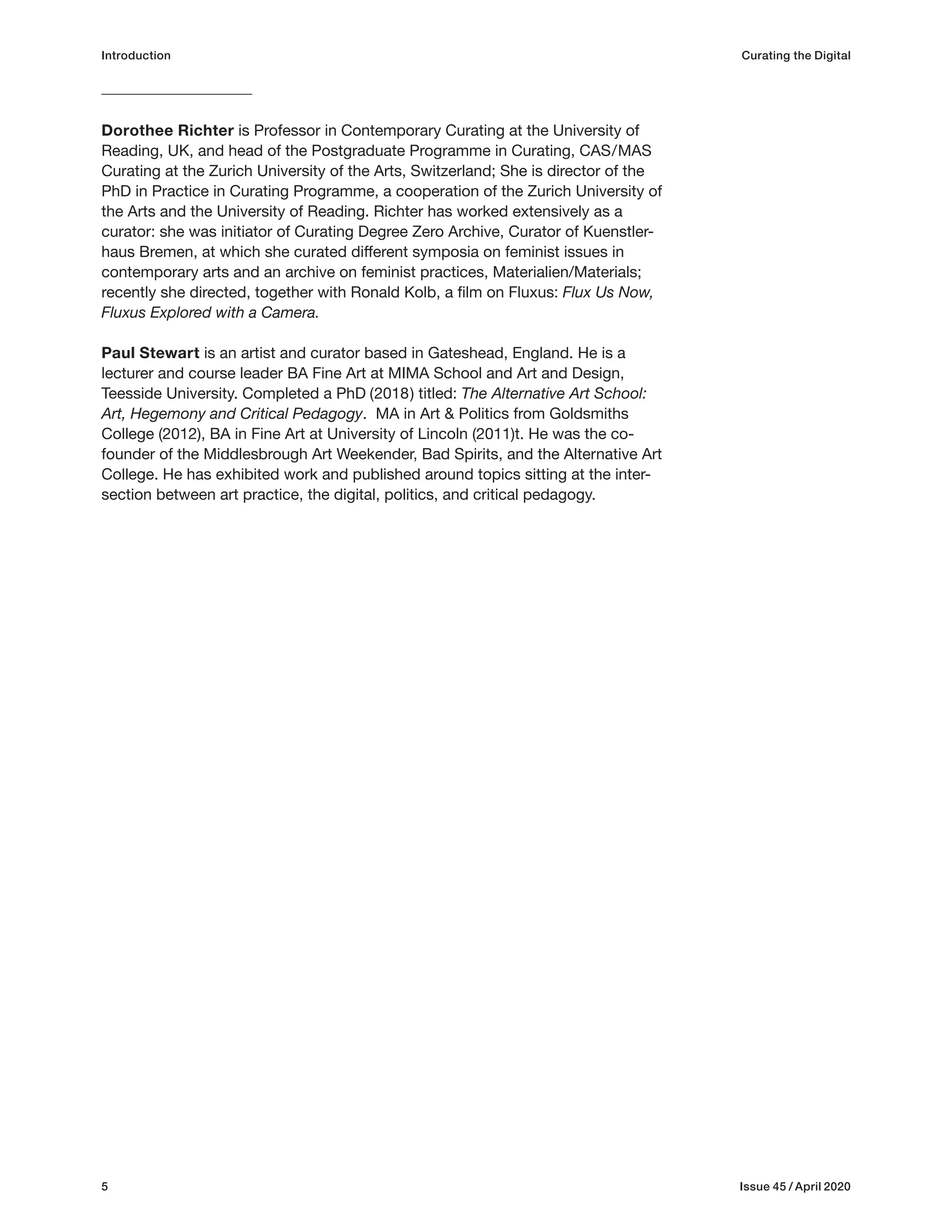


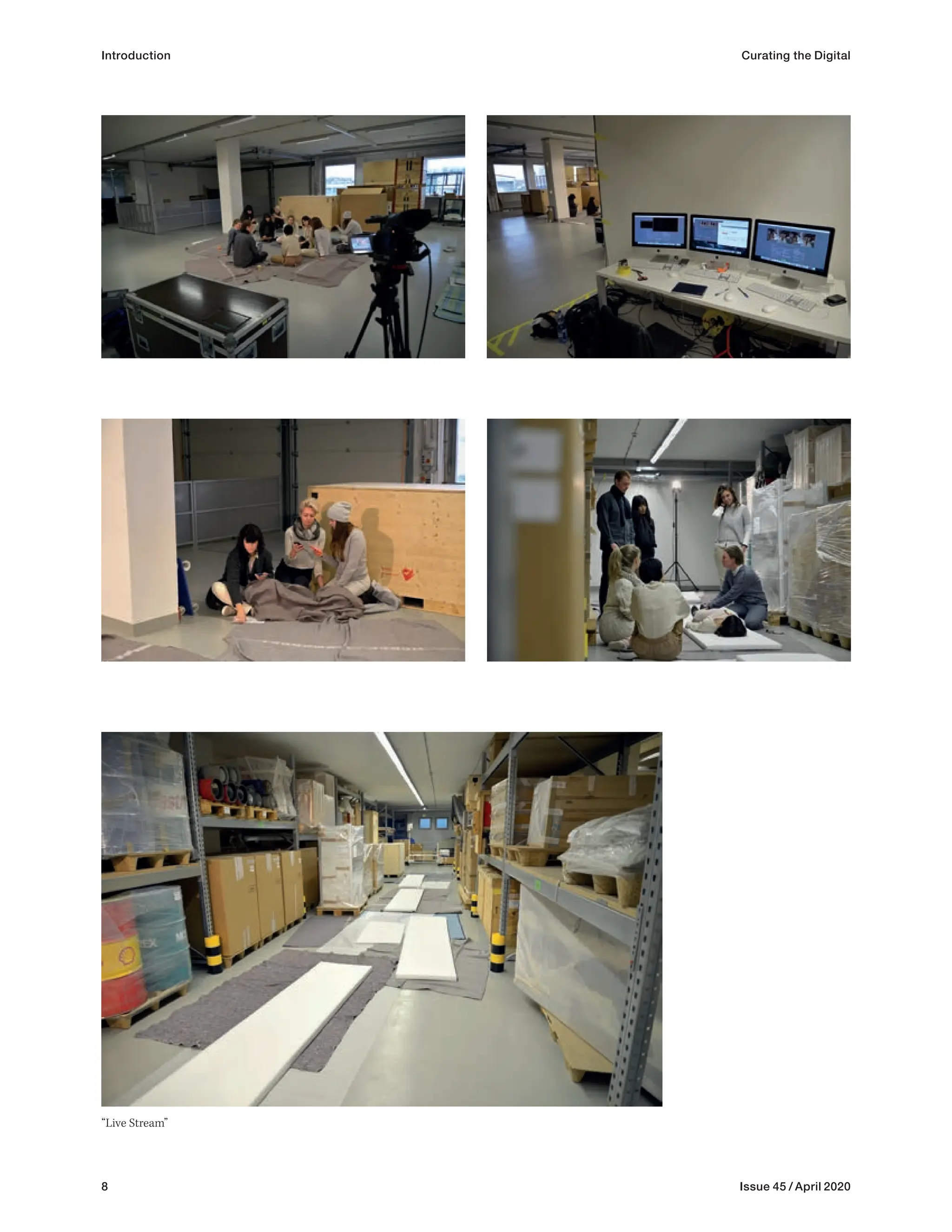
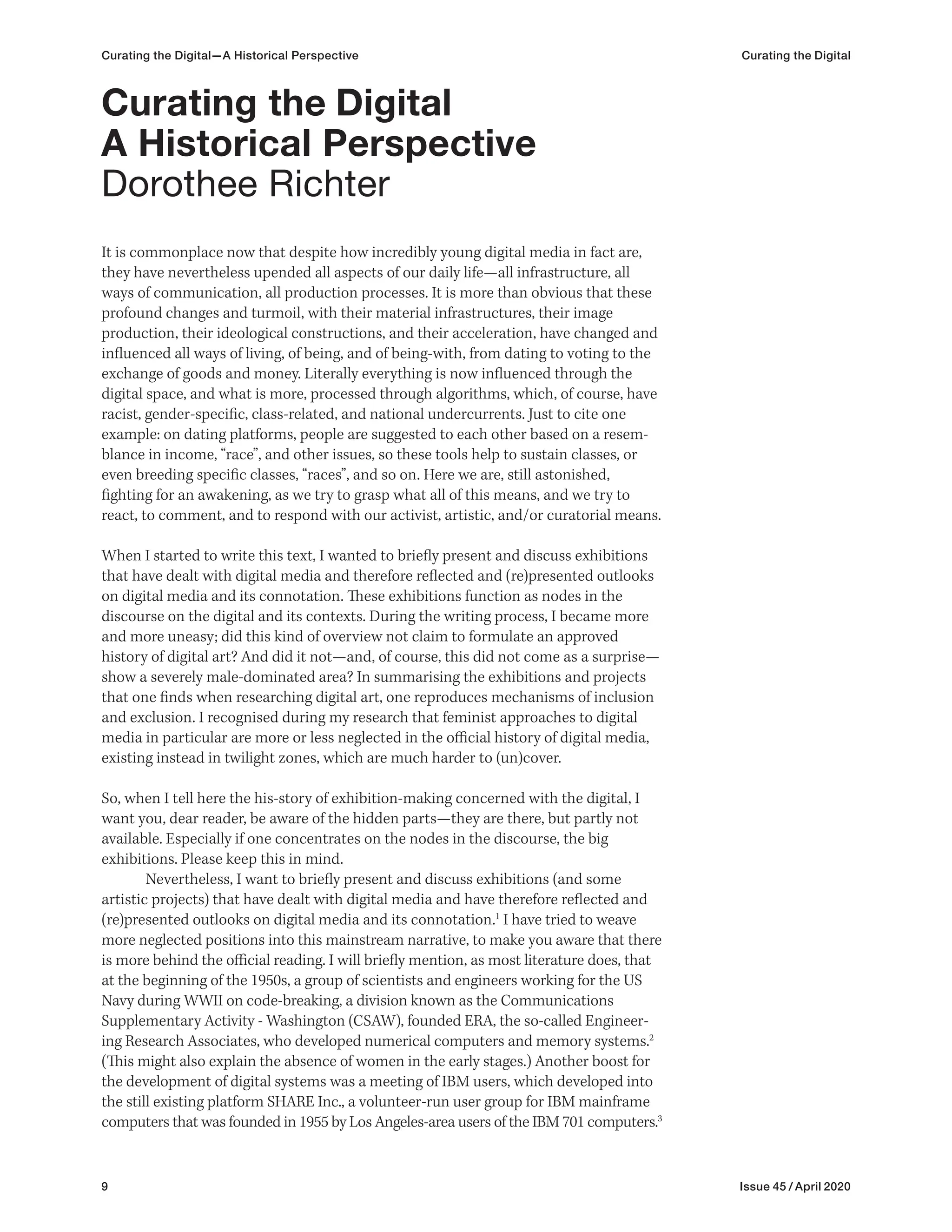
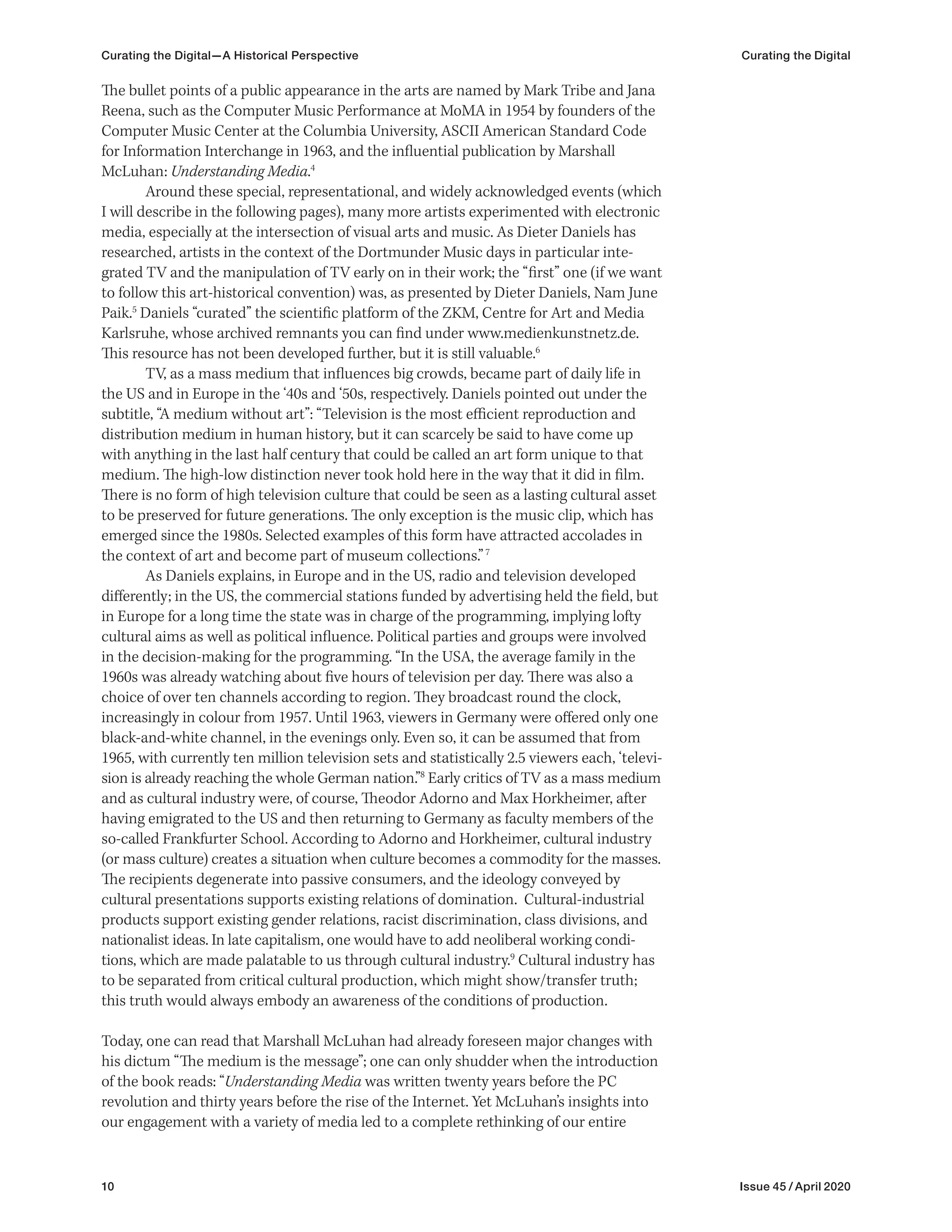
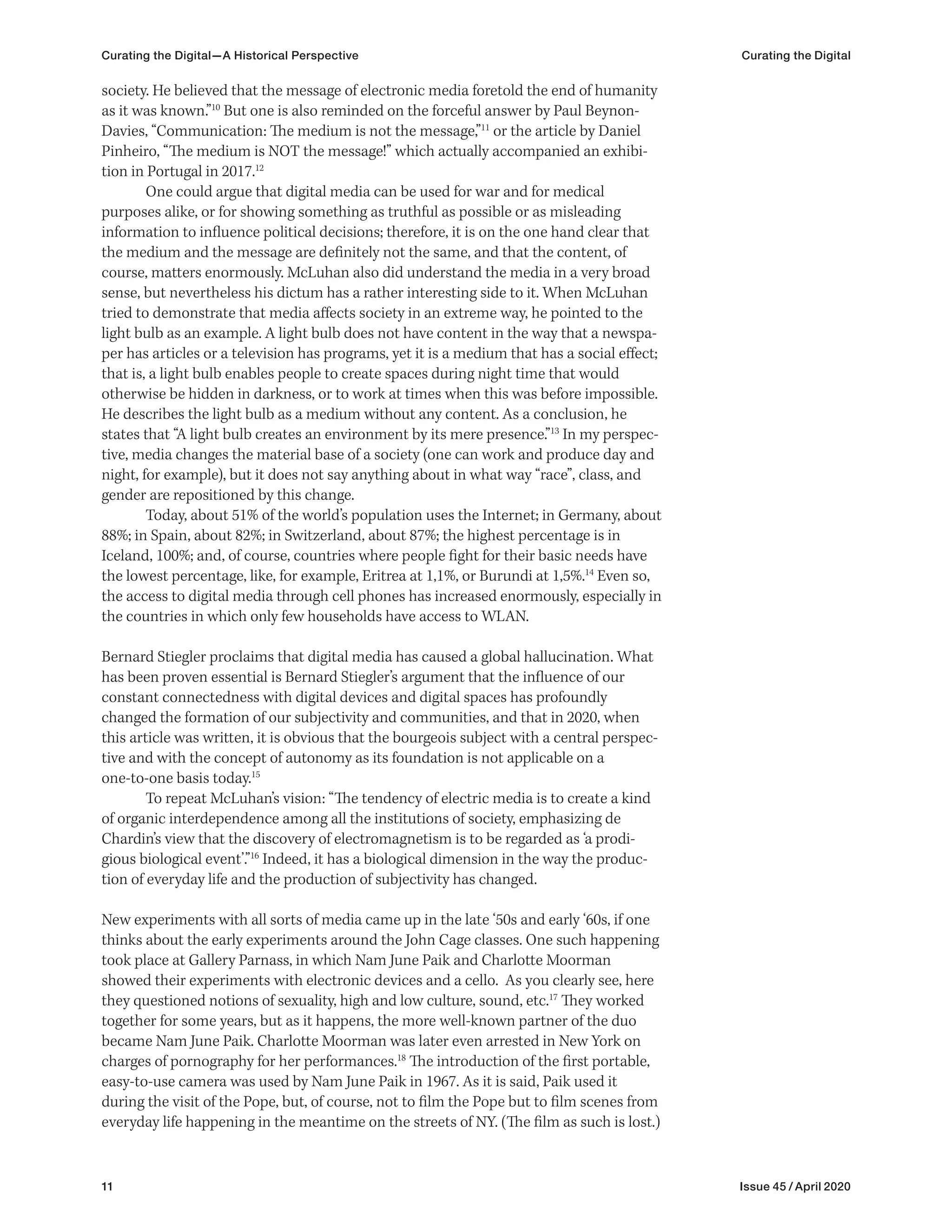
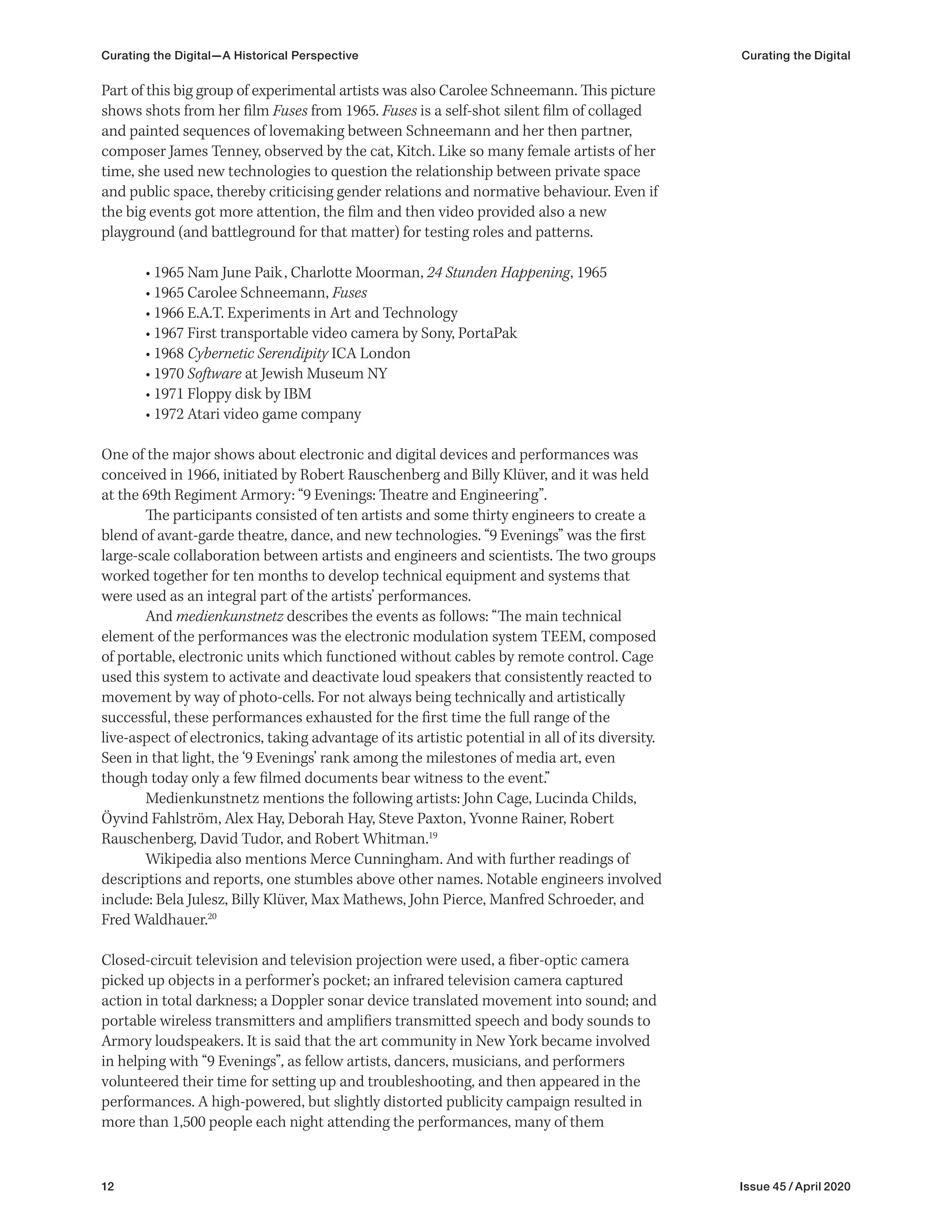
![13 Issue 45 / April 2020
Curating the Digital—A Historical Perspective Curating the Digital
astonished by the avant-garde performances they saw. It is clear that this event also
demonstrated a great enthusiastic reaction to all possibilities of digital media. The
underlying creativity concept combines a strong belief in technology with geniality.
The figure of the male white artist is enhanced with that of the almost all-powerful
engineer. The visitors were involved because they were moving in the middle of the
action, the framing of a traditional exhibition with immobilized objects and controlled
visitor-subjects was surpassed by this project, one could argue. This exhibition tried to
reflect the major changes in society that started at that time, in the ‘70s, and involved
all parts of daily life and all forms of culture. As Felix Stalder has put it: “It is more than
half a century since Marshall McLuhan announced the end of the Modern era, a cultural
epoch that he called the Gutenberg Galaxy in honor of the print medium by which it
was so influenced. What was once just an abstract speculation of media theory,
however, now describes the concrete reality of our everyday life. What’s more, we have
moved well past McLuhan’s diagnosis: the erosion of old cultural forms, institutions,
and certainties is not something we affirm but new ones have already formed whose
contours are easy to identify not only in niche sectors but in the mainstream. [...] This
enormous proliferation of cultural possibilities is an expression of what I will refer to
below as the digital condition.”21
In this sense, the exhibitions and projects represent a
rupture in the understanding of the human as the body in the hegemonic space of art
as a part of an electronic environment, an involuntary participant, and the digital
space could be seen as something interacting with the human body, where it became
difficult to decide what became the cause and what the effect.
Carolee Schneemann, Fuses, 1965
Nam June Paik, Charlotte Moorman, 24 Stunden Happening, 1965](https://image.slidesharecdn.com/curatingthedigital-231012212646-a91382ef/75/Curating_the_Digital-pdf-14-2048.jpg)
![14 Issue 45 / April 2020
Curating the Digital—A Historical Perspective Curating the Digital
The next appearance of E.A.T. – Experiments in Art and Technology (Billy Klüver and
Robert Rauschenberg), launched after having collaborated on many previous projects,
was a major exhibition in a museum: the 1968 Some More Beginnings at the Brooklyn
Museum presented a large number of innovative technical, electronic, and other media
projects, but looked quite tame in the photos, with wooden floors and white walls. The
ferocity and unfamiliarity of an old army hall was tamed by using the framework of
bourgeois museum.
In 1968, Cybernetic Serendipity at the ICA London was curated by Jasia Reichardt 22
,
and I quote here from the press release: “Cybernetics—derives from the Greek
‘kybernetes’ meaning ‘steersman’; our word ‘governor’ comes from the Latin version of
the same word. [...]
A cybernetic device responds to stimulus from outside and in turn affects
external environment, like a thermostat which responds to the coldness of a room by
switching on the heating and thereby altering the temperature. This process is called
Robert Whitman, Two Holes of Water, 1966 | Photography Robert Whitman,
at “9 Evenings: Theatre and Engineering”](https://image.slidesharecdn.com/curatingthedigital-231012212646-a91382ef/75/Curating_the_Digital-pdf-15-2048.jpg)
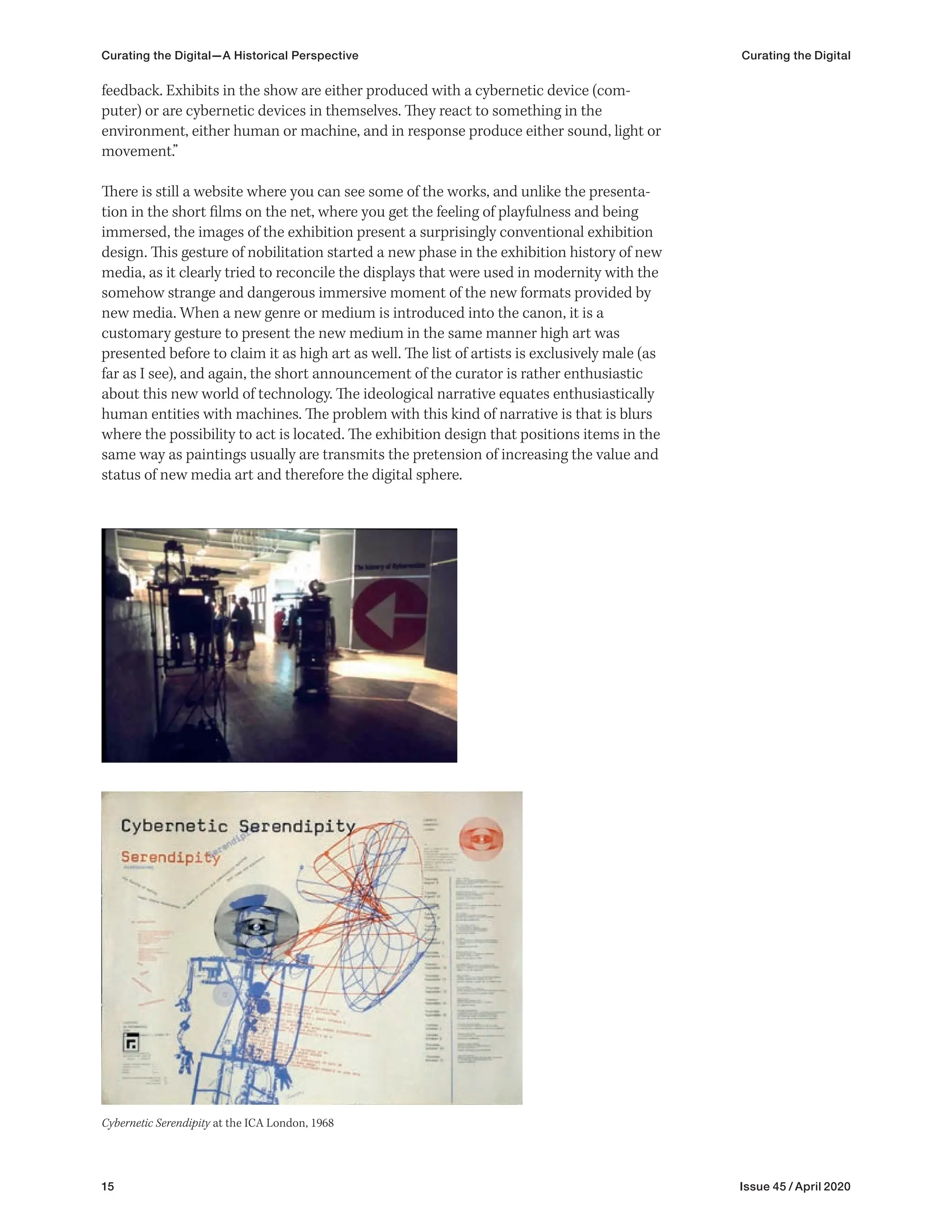
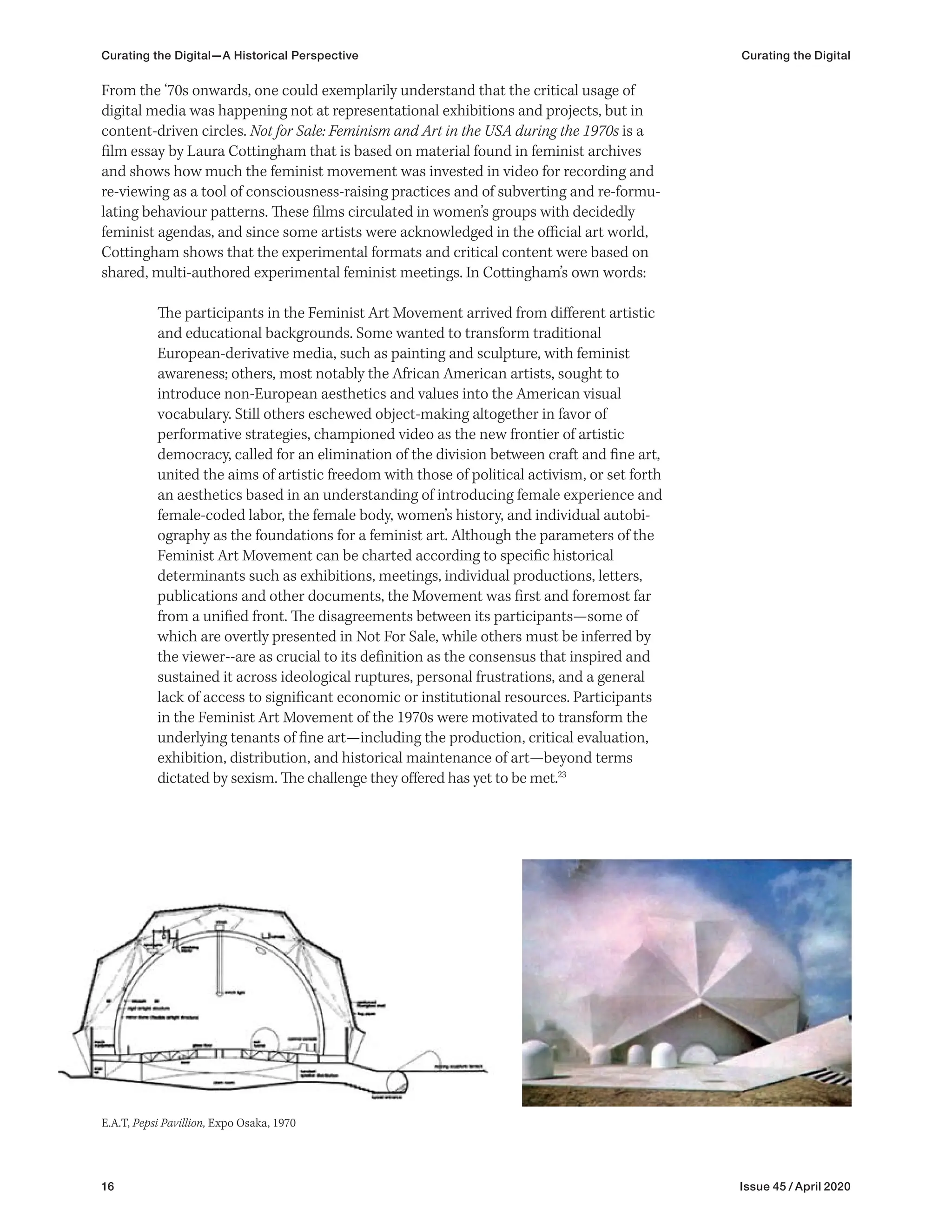
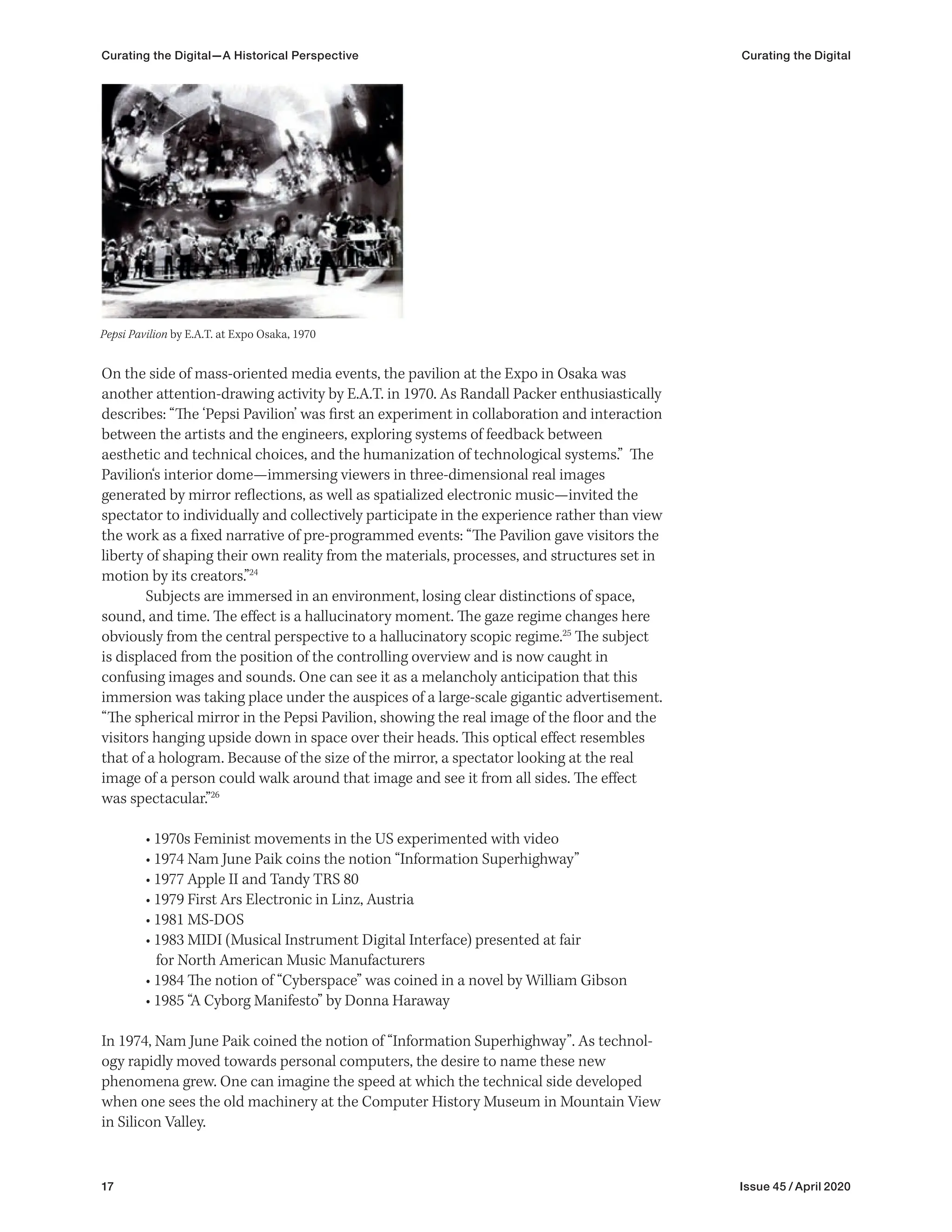
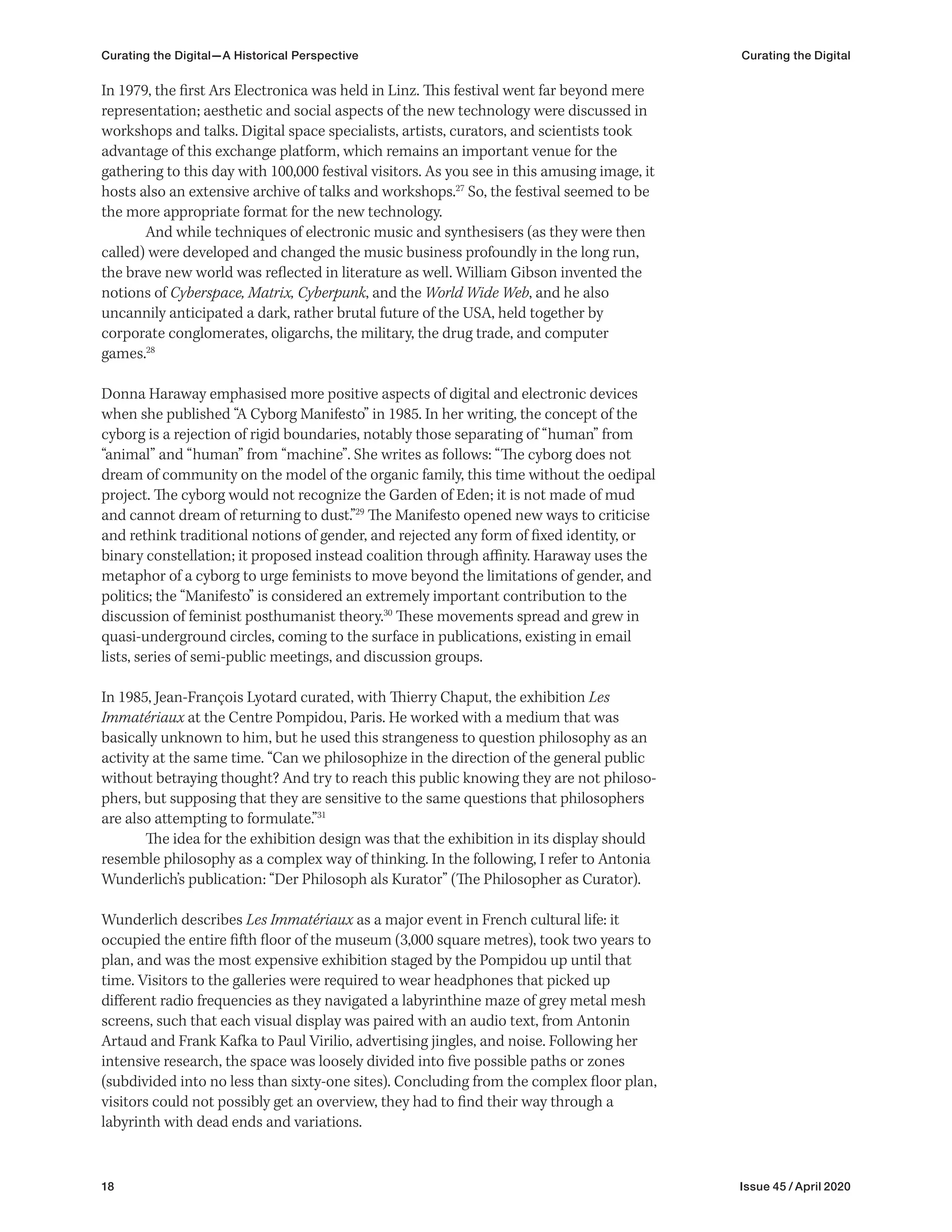
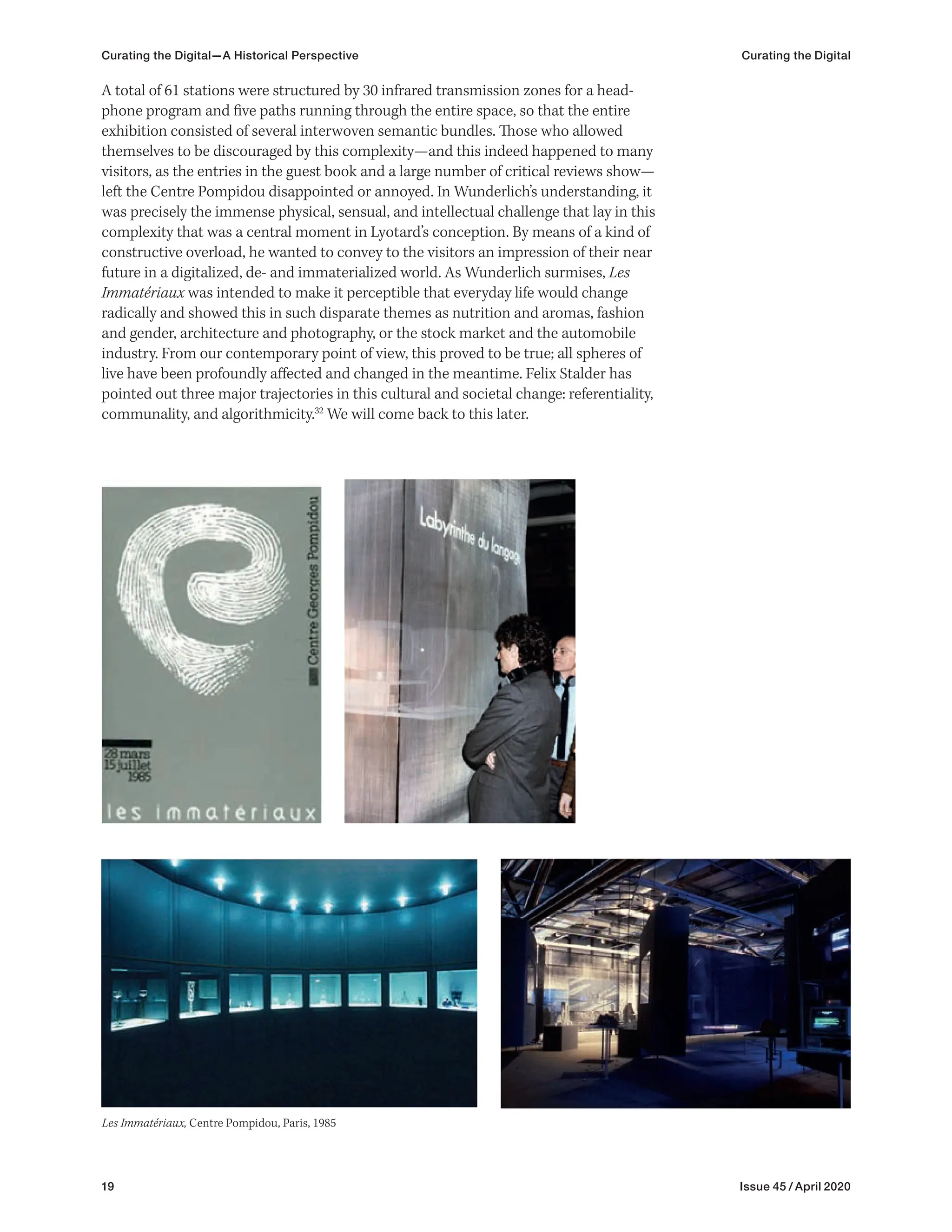
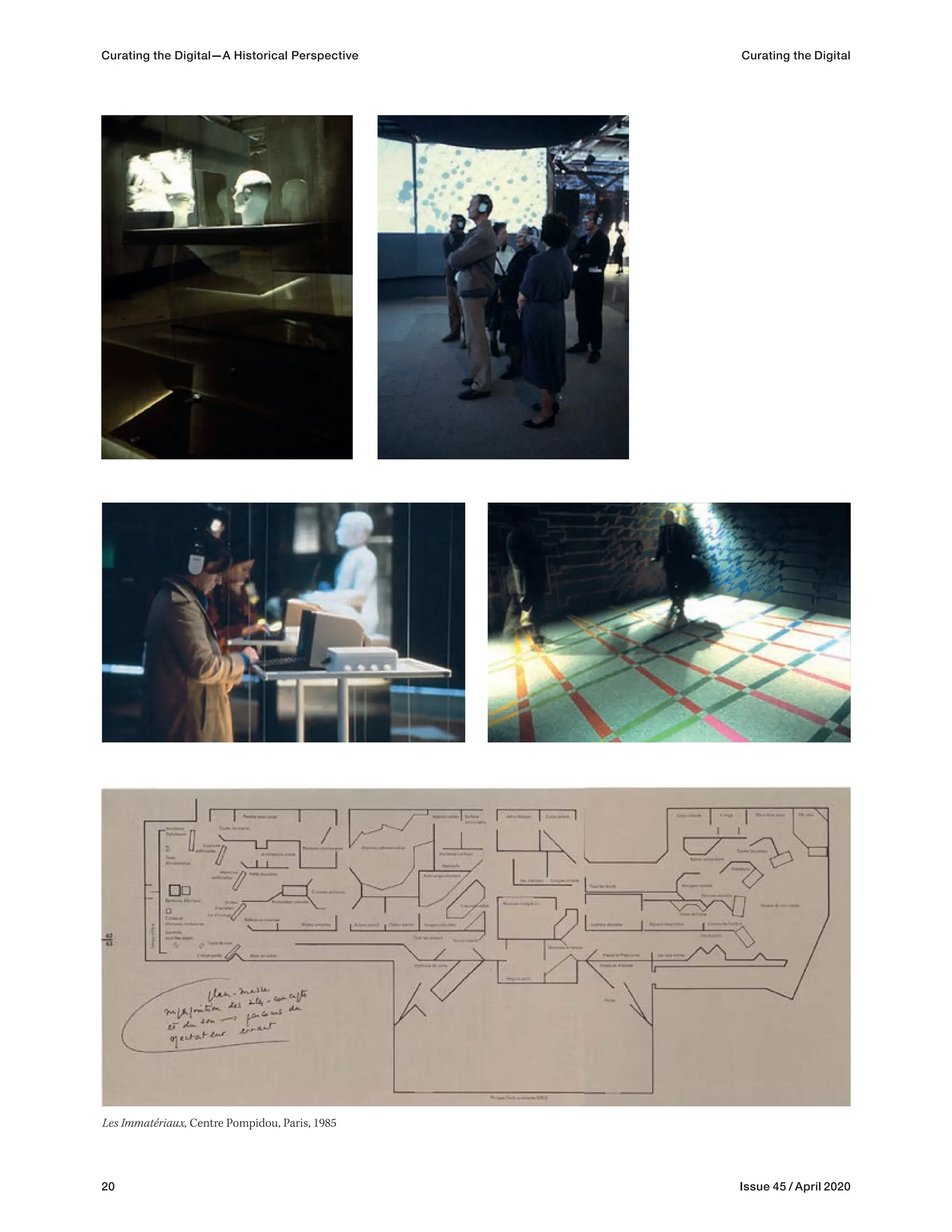
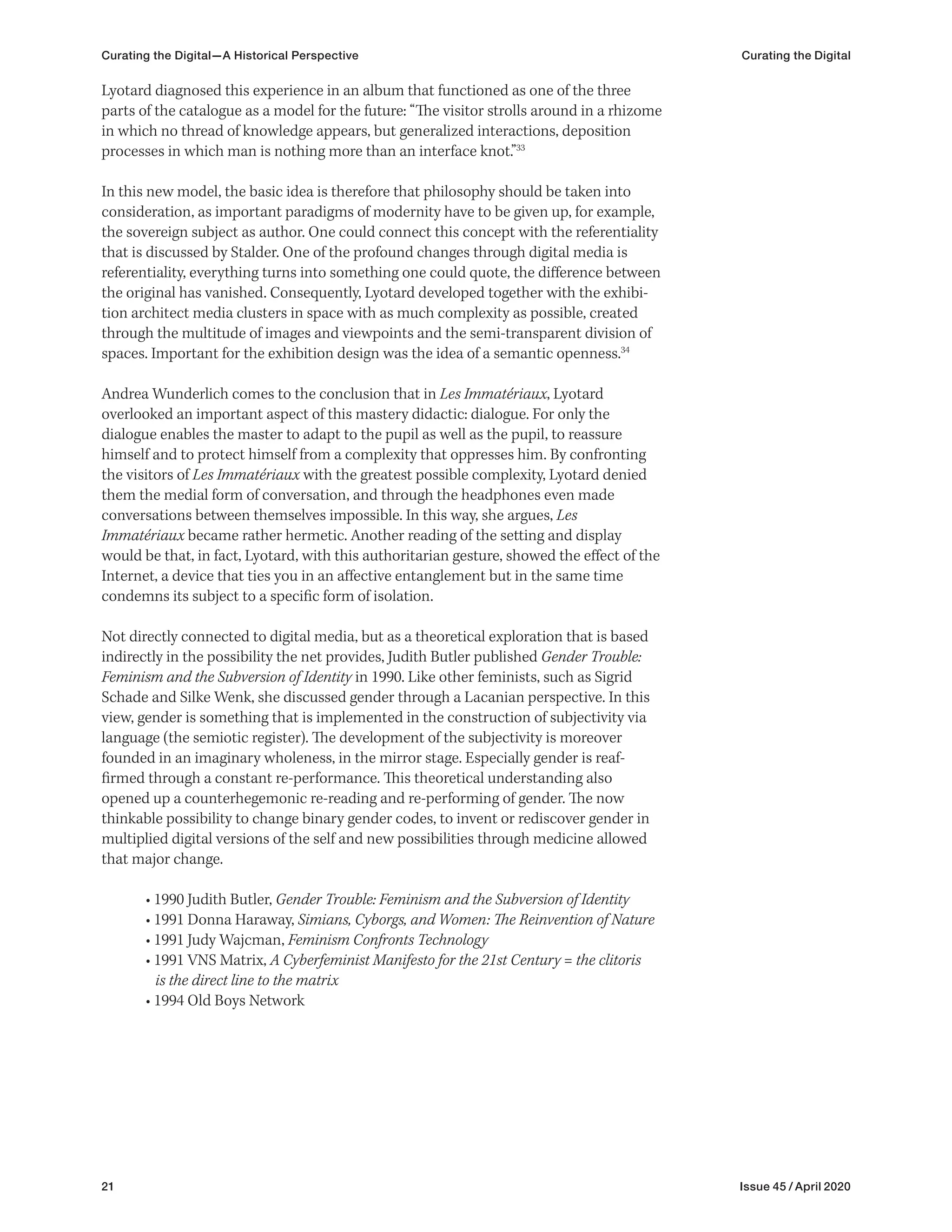
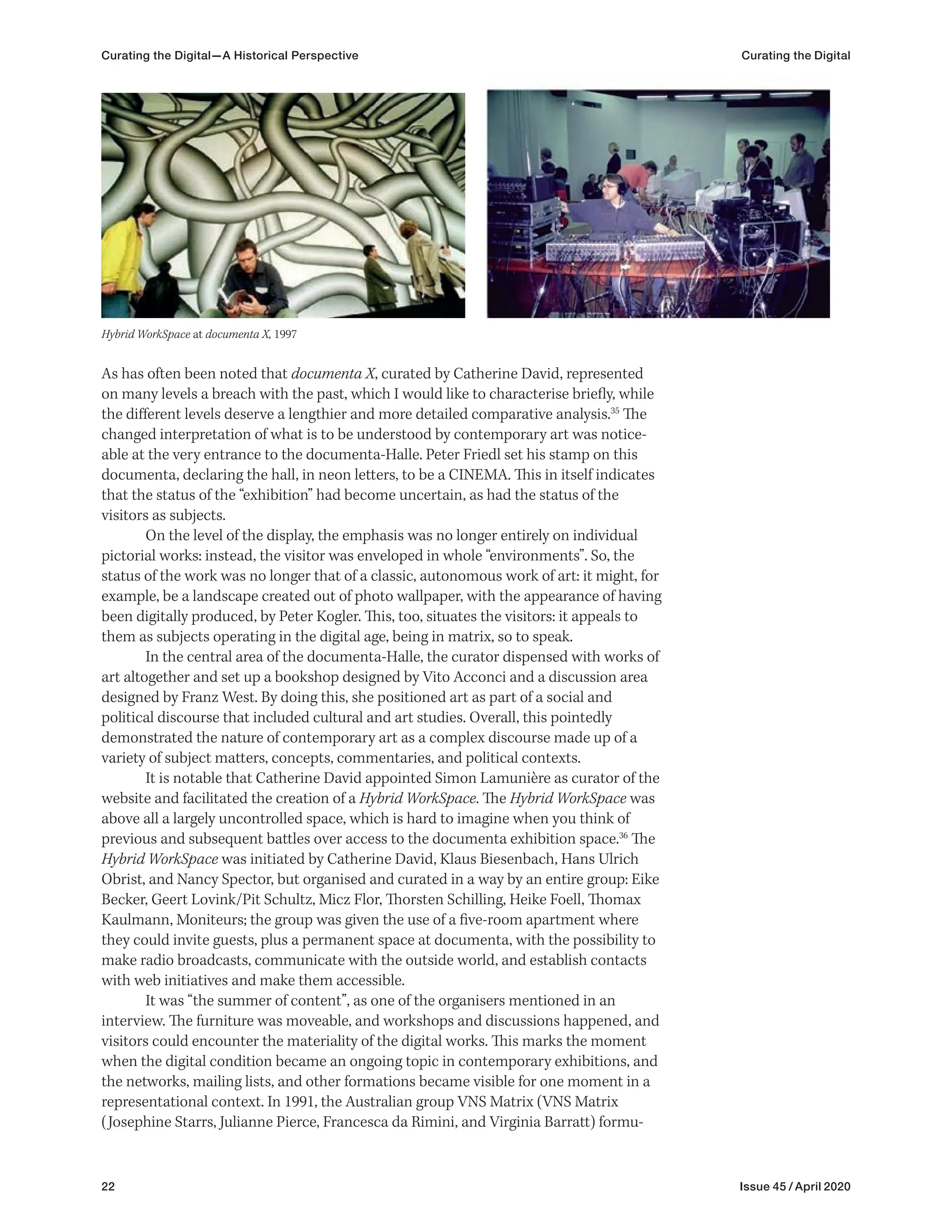
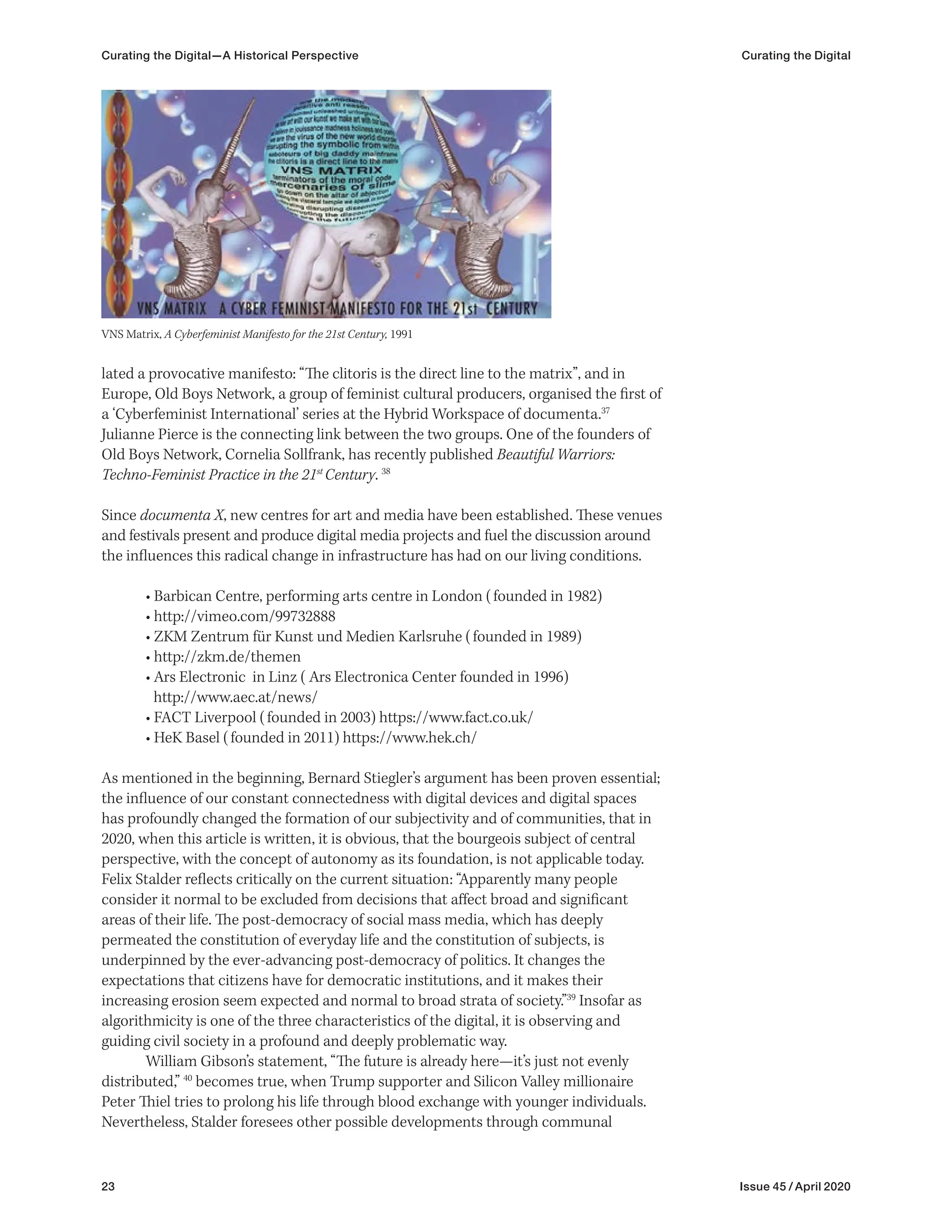
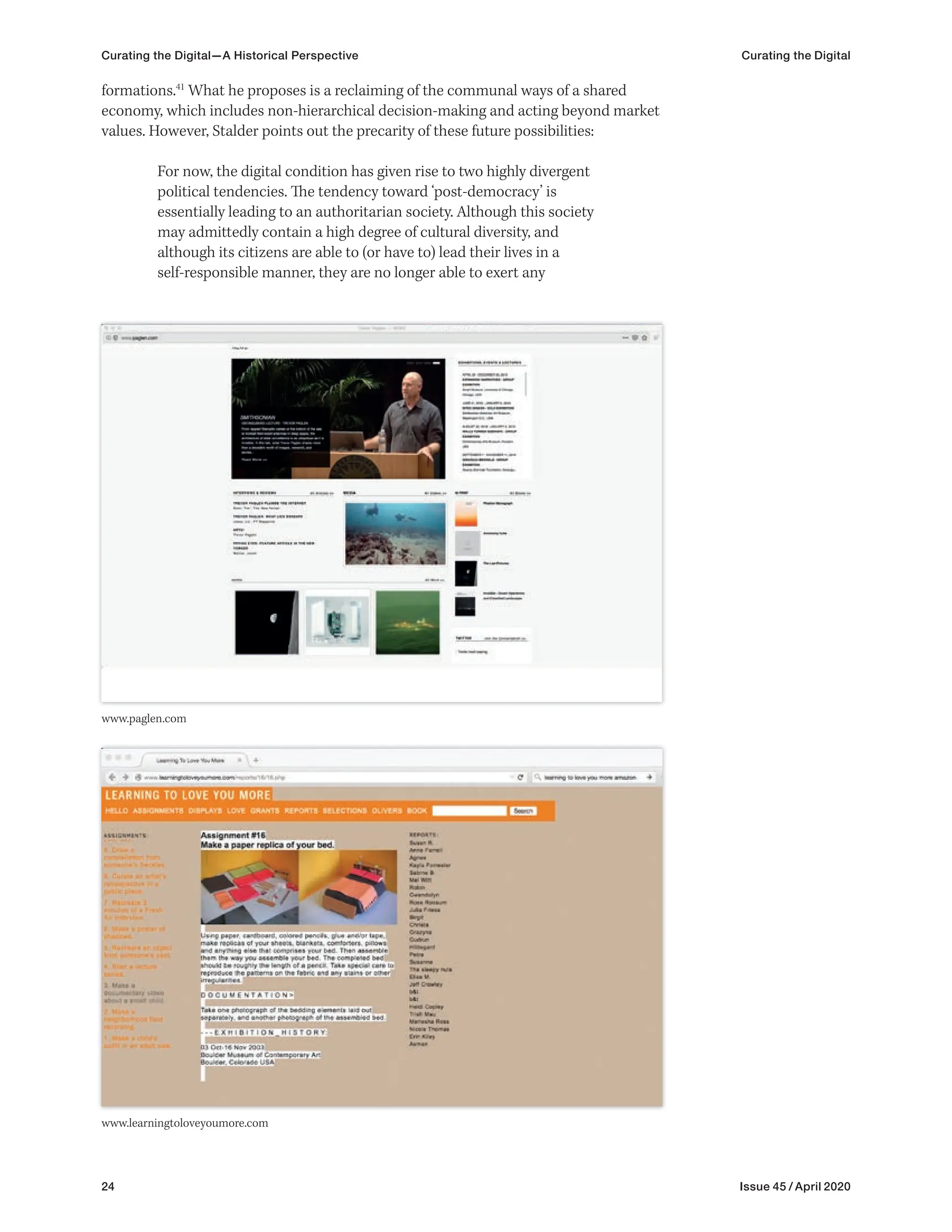
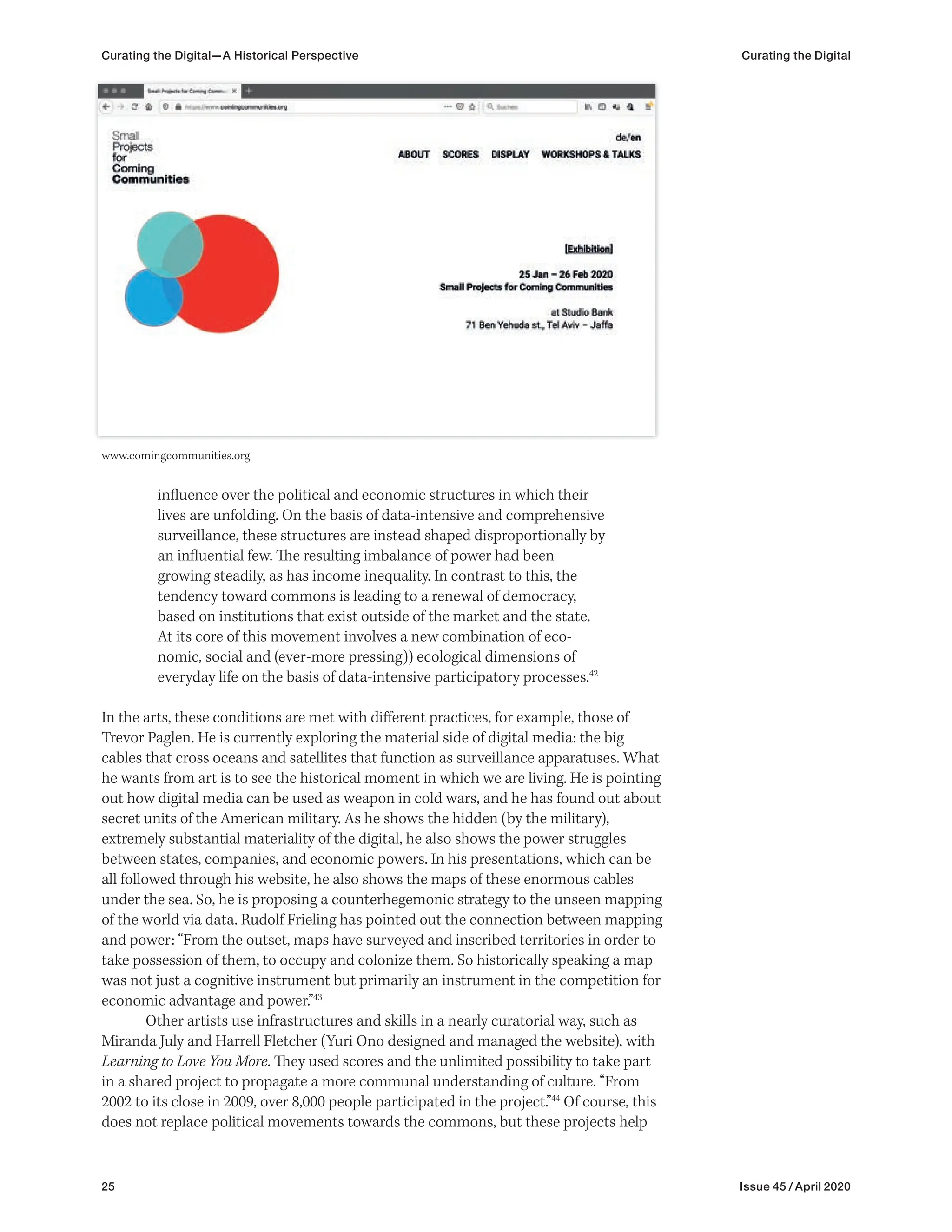
![26 Issue 45 / April 2020
to establish the idea of shared experiences, shared interests, a shared cultural space,
and shared politics across nations. One of our own curatorial projects also opens up to
participating and including new audiences and new ideas; see Small Projects for
Coming Communities.45
Even if these kind of projects are relatively small and do not at
the moment play a role in a political struggle, they might help to lay a foundation for
understanding new forms of communality, where the visual and the political will
become close. These kind of more complex structures or research projects on the
commons like “Creating Commons”46
might provide a background to political
struggles under the motto of FridaysForFuture47
or Extinction Rebellion.48
Notes
1 I have relied on some important sources that I would like to generally acknowledge:
Mark Tribe and Reena Jana, eds., “Art in the Age of Digital Distribution,” in New Media
Art (London: Taschen, 2006), 6–25;
Oliver Grau, “New Media Art - Art History,” Oxford Bibliographies (2016), accessed
13 February 2020, https://www.oxfordbibliographies.com/view/document/
obo-9780199920105/obo-9780199920105-0082.xml.
http://www.medienkunstnetz.de/ /ZKM)
2 Tribe and Jana, eds., “Art in the Age of Digital Distribution,” 6–25.
3 Ibid.
4 Marshall McLuhan, Understanding Media (Oxon: Routledge, 1964).
5 Dieter Daniels, “Television—Art or Anti-art? Conflict and cooperation between the
avant-garde and the mass media in the 1960s and 1970s,” accessed 21 May 2018,
http://www.medienkunstnetz.de/themes/overview_of_media_art/massmedia/.
6 Daniels practically manages to write this article without naming any female artists.
7 Daniels, “Television—Art or Anti-art?”
8 Ibid.
9 Max Horkheimer and Theodor Adorno, “Kulturindustrie. Aufklärung als Massenbe-
trug,” in Dialektik der Aufklärung (New York: Social Studies Association, 1944).
10 See https://www.amazon.de/Understanding-Media-Routledge-Classics-Paperback/
dp/0415253977/ref=sr_1_5?ie=UTF8&qid=1525189968&sr=8-5&keywords=marshall-
+mcluhan, accessed 1 May 2018.
11 Paul Beynon-Davies, Communication, the medium is not the message, in Signifi-
cance, Palgrave Macmillan, London, 2011, p.58-76. The abstract of the paper states the
following:
“In the 1960s, Marshall McLuhan famously coined the phrase, the medium is the
message (McLuhan, 1994). By this he meant that communication media rather than
the content of messages conveyed should be the focus of study. This influential
statement has acquired something of the status of an aphorism: a universal statement
of truth. But in our terms it makes a fundamental mistake: that of treating knowledge
of communication media as equivalent to a complete understanding of communica-
tion. This chapter begins the process of explaining why communication is much more
than media or channels of communication.”
12 Daniel Pinheiro, The medium is NOT the message, 2017, see https://www.academia.
edu/35264801/The_Medium_is_NOT_the_Message_Daniel_Pinheiro_2017_?auto-
=download, “This text was presented in the context of the exhibition The Medium is
Not the Message (Maus Hábitos, Porto, Portugal); The exhibition took place between
18 November and 10 December 2017. […] Curated by José Alberto Gomes and André
Covas.”
13 McLuhan, Understanding Media.
Curating the Digital—A Historical Perspective Curating the Digital](https://image.slidesharecdn.com/curatingthedigital-231012212646-a91382ef/75/Curating_the_Digital-pdf-27-2048.jpg)
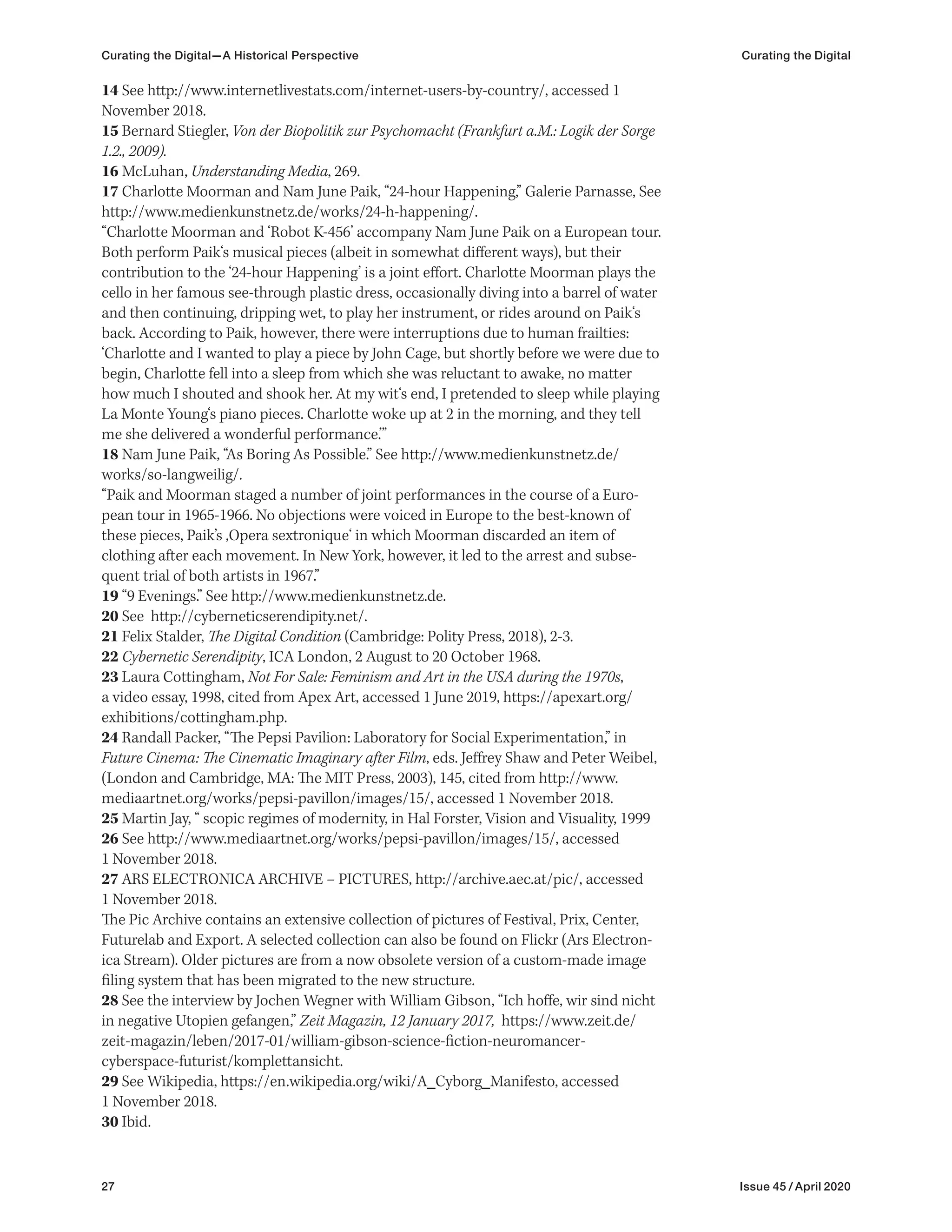
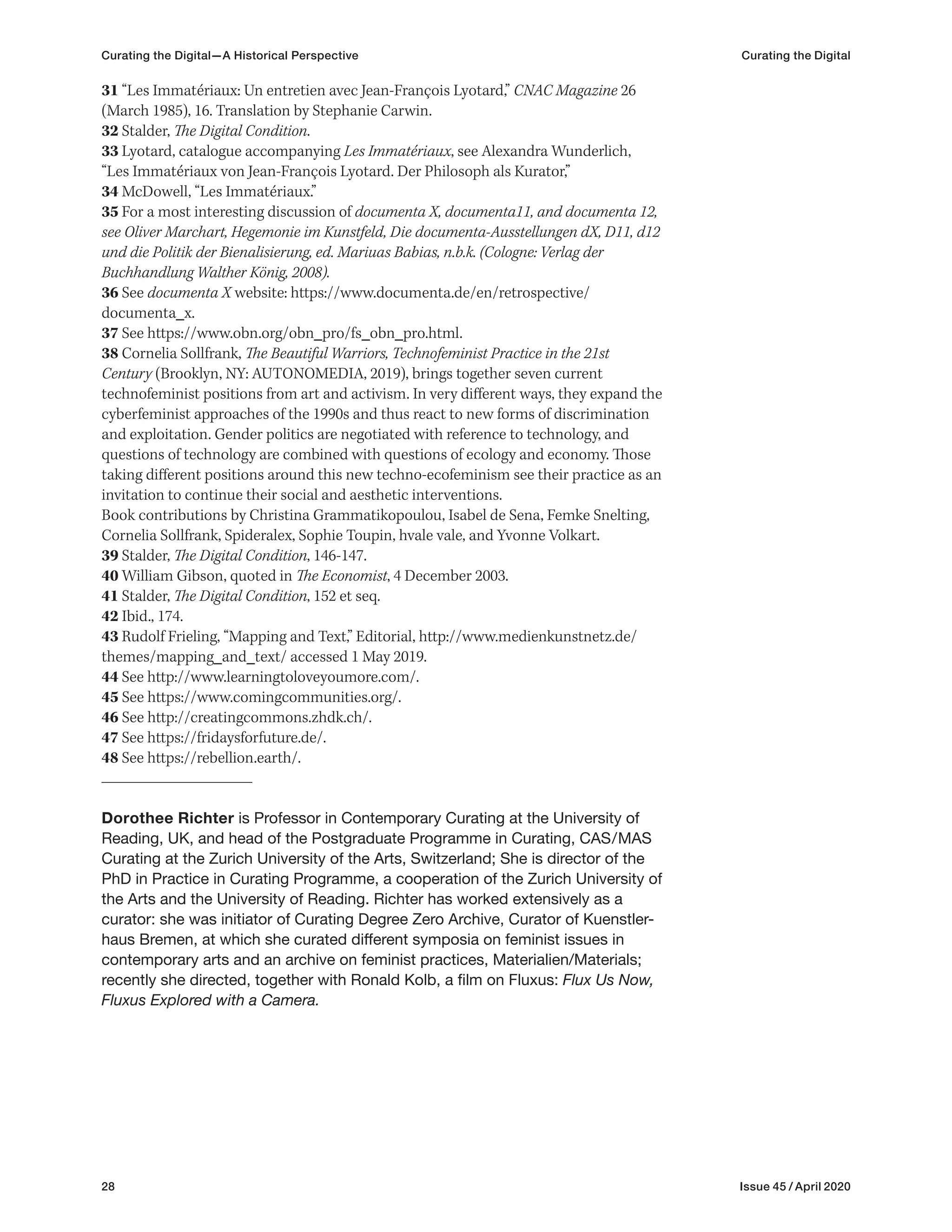

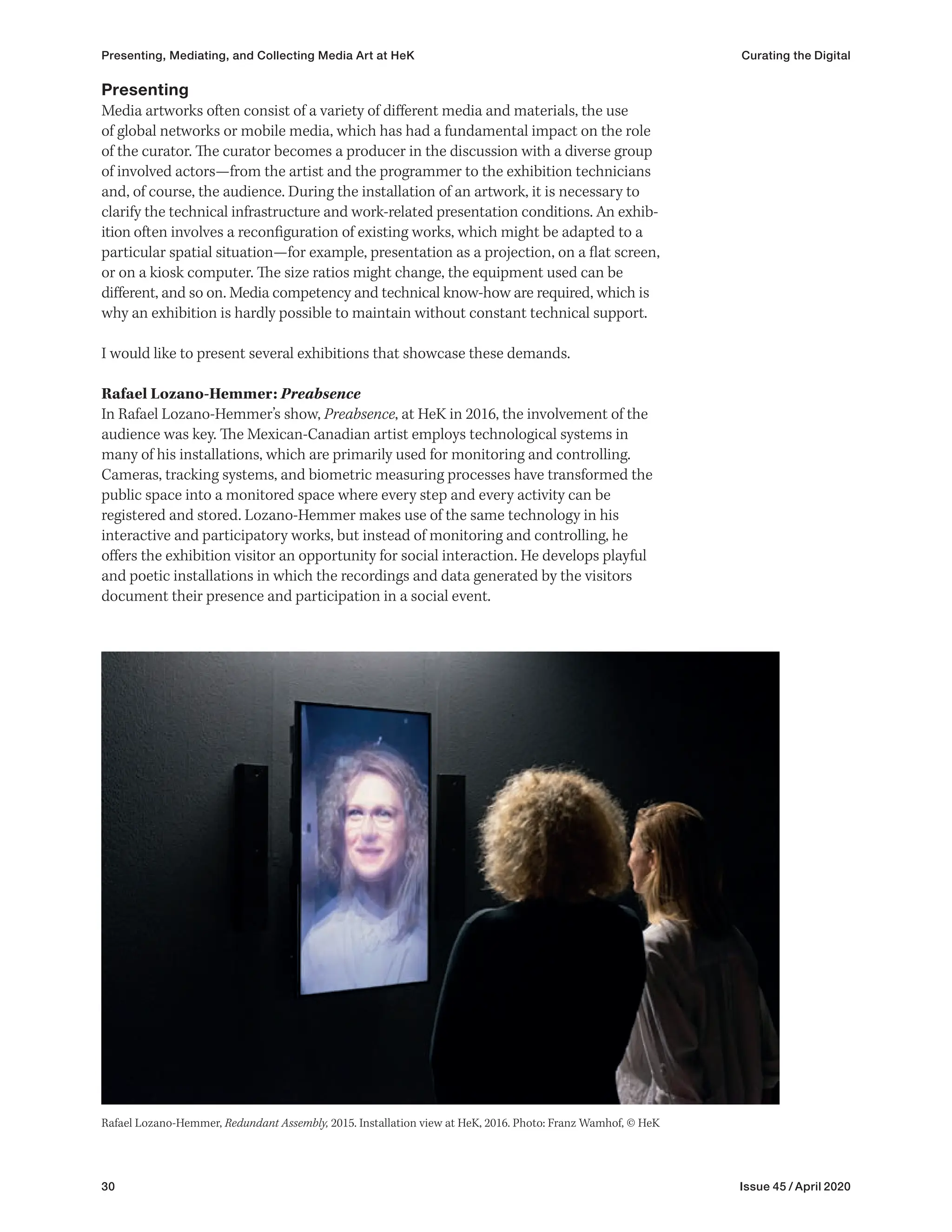
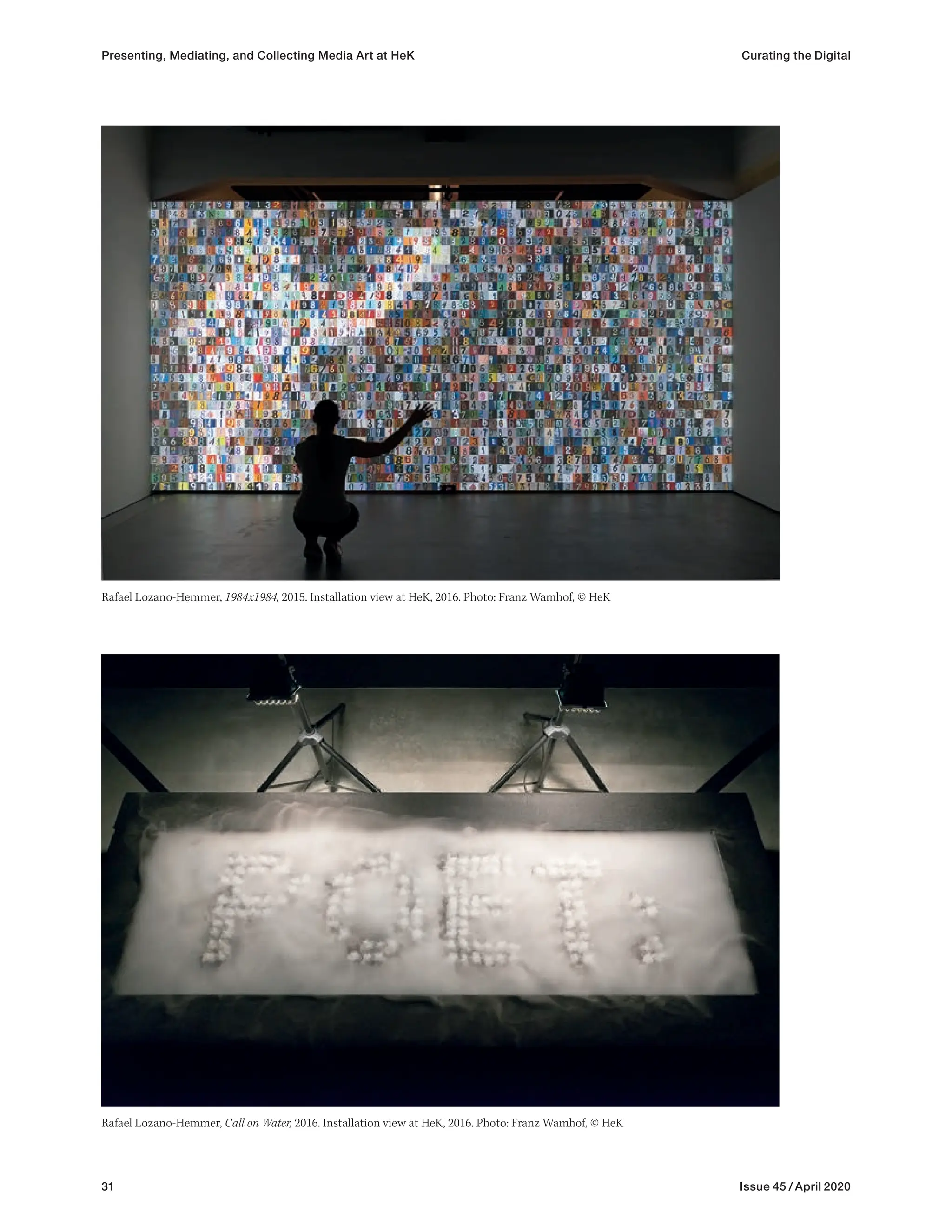

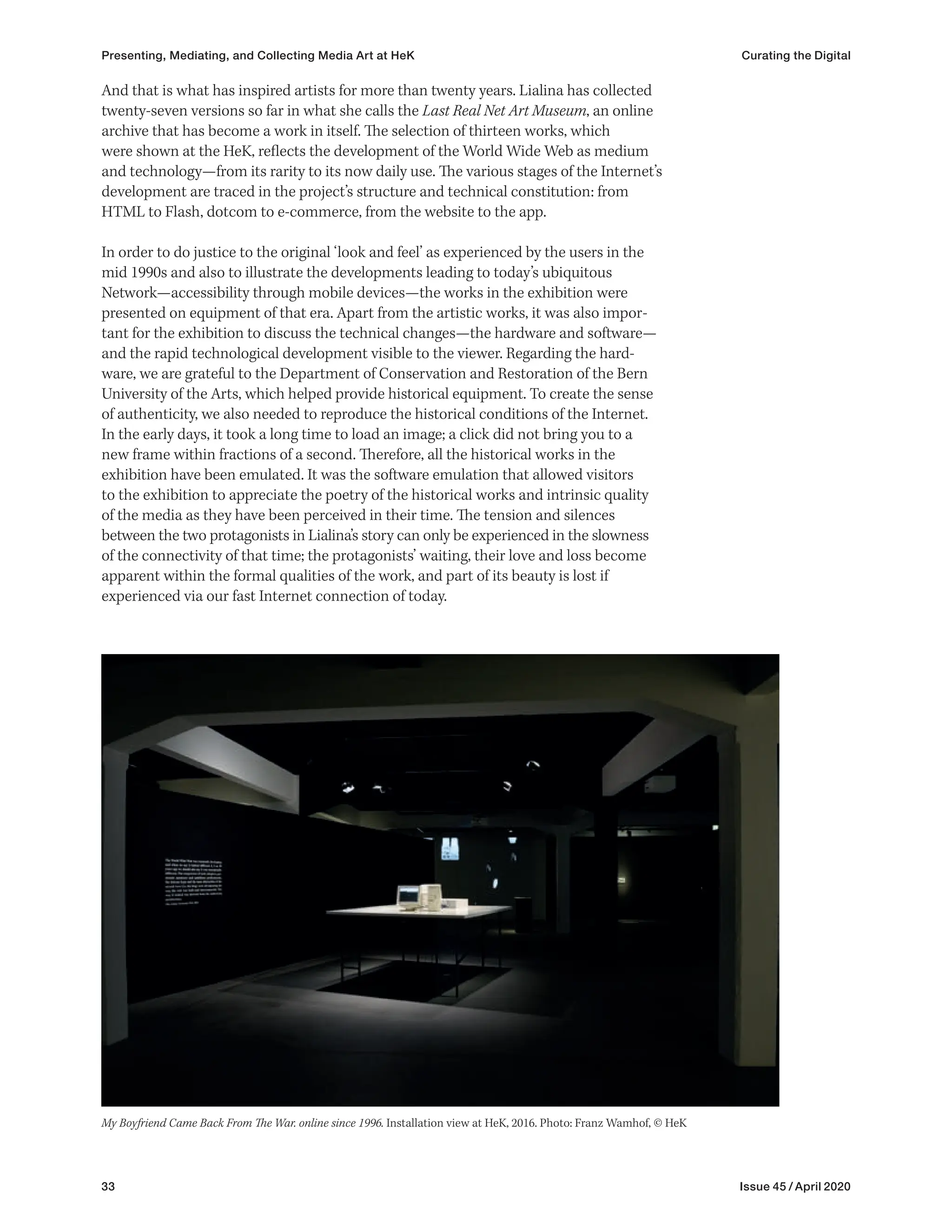
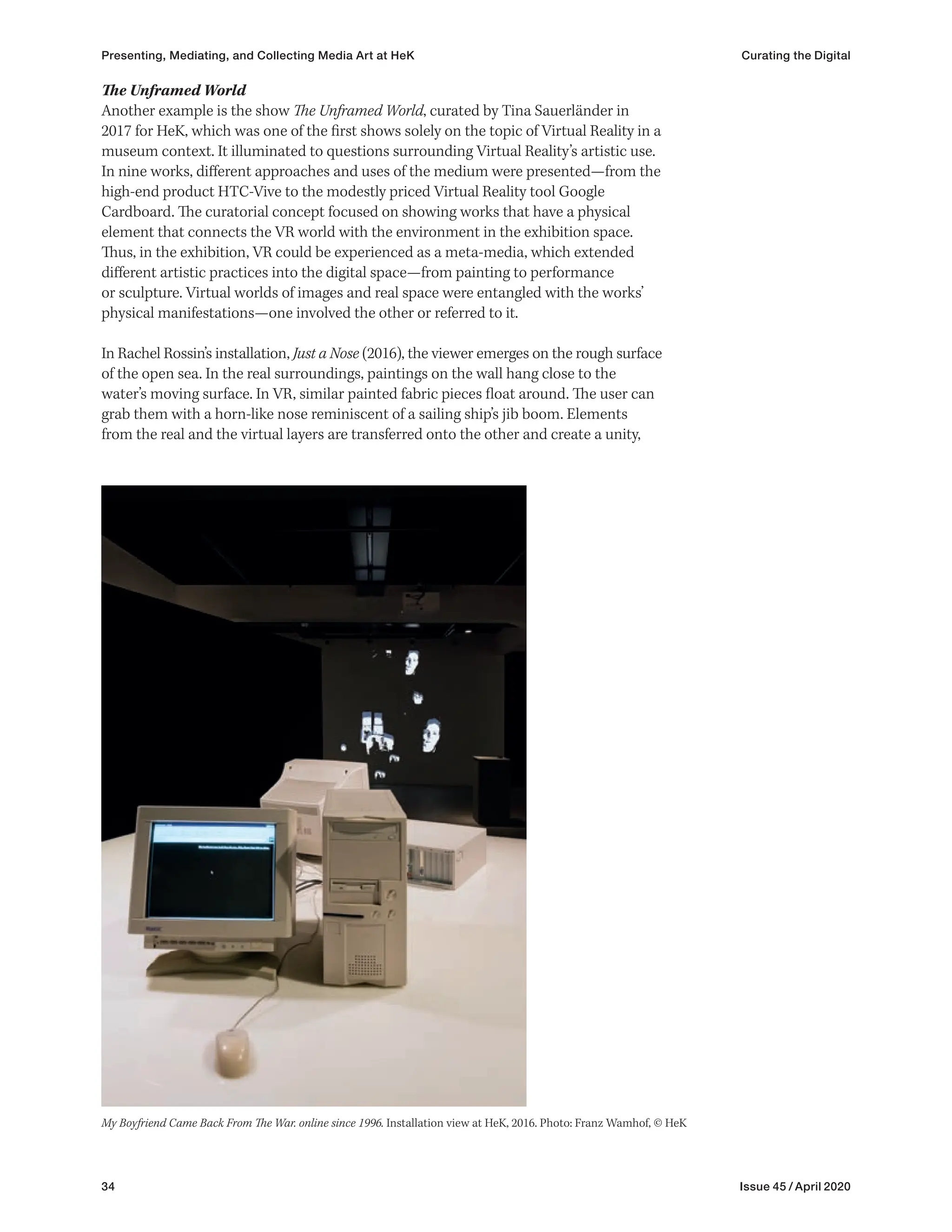
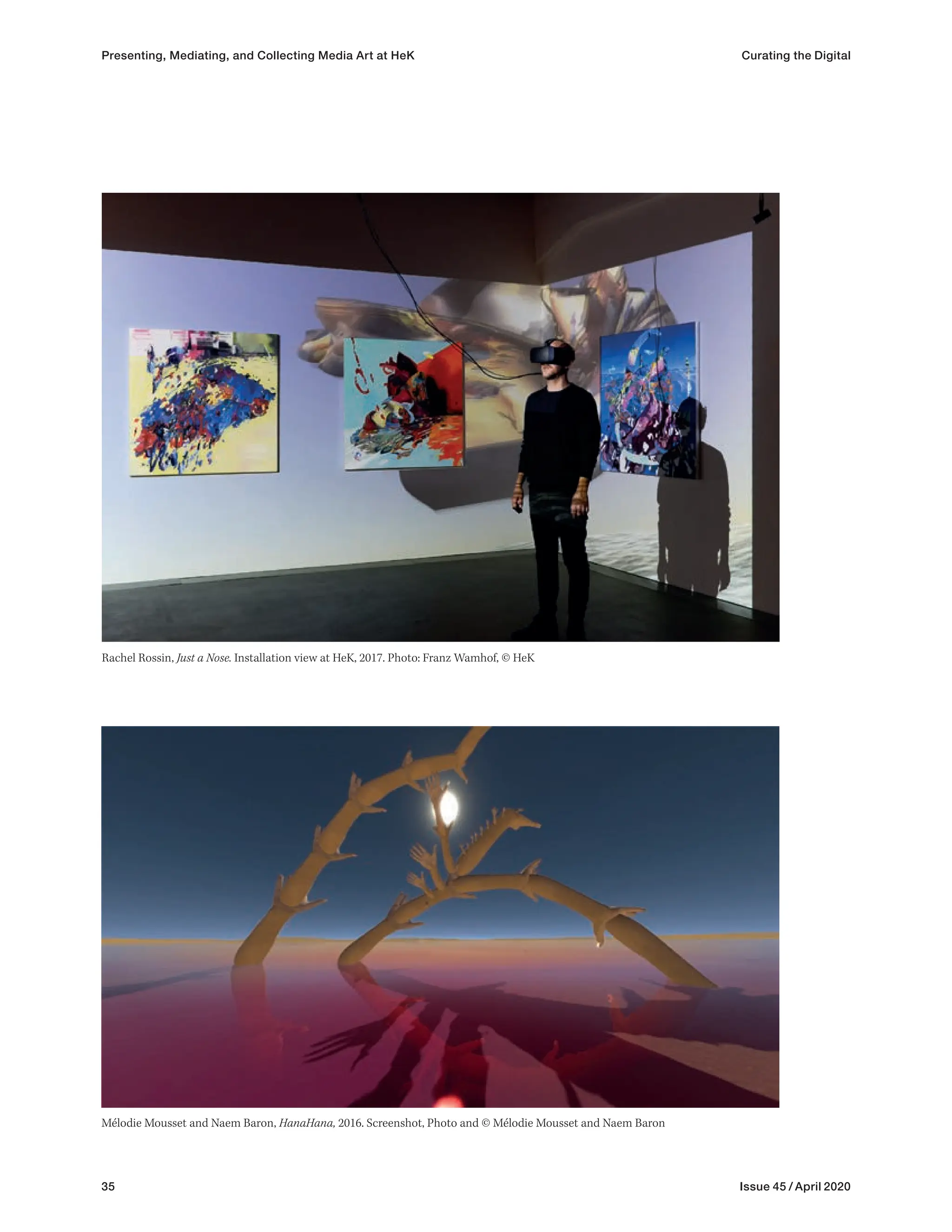
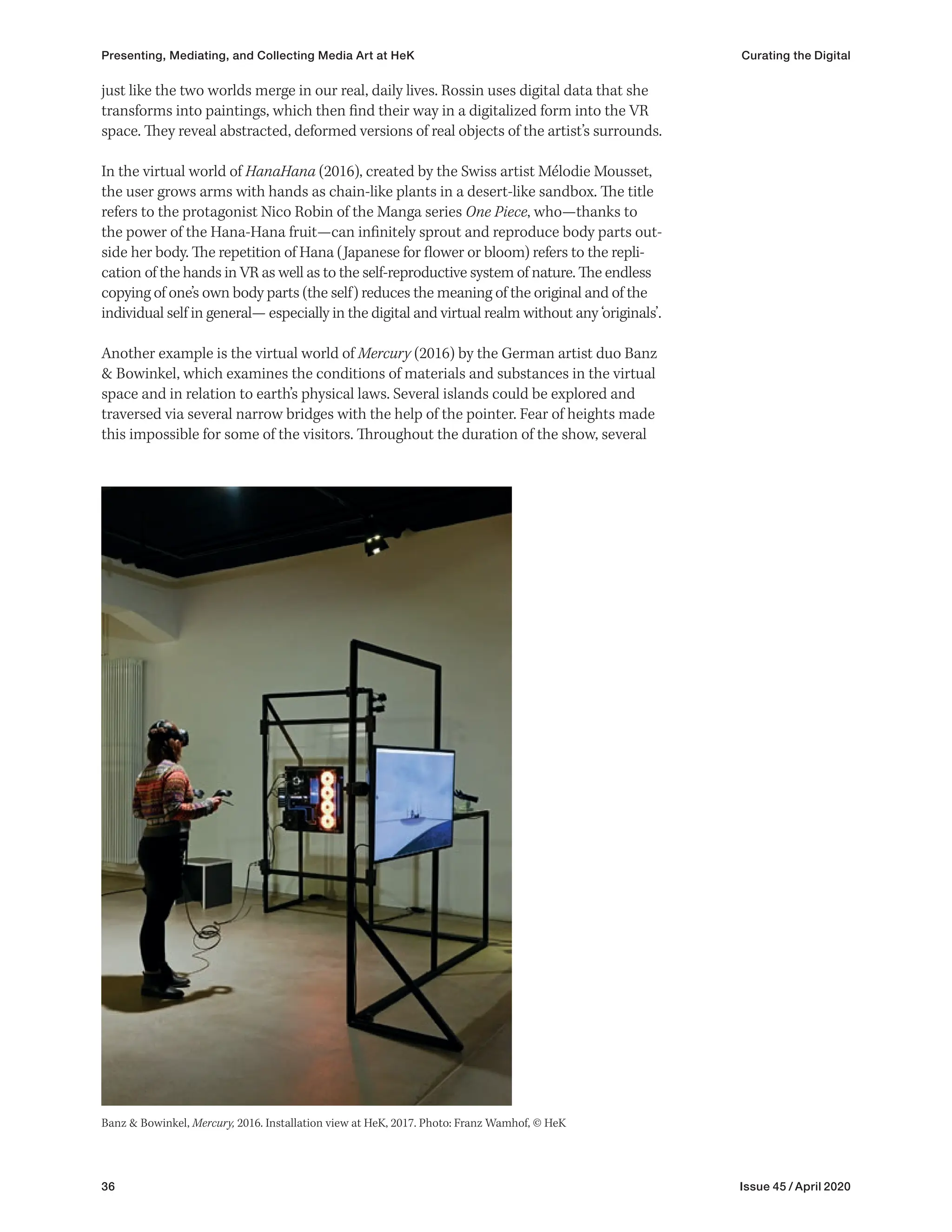
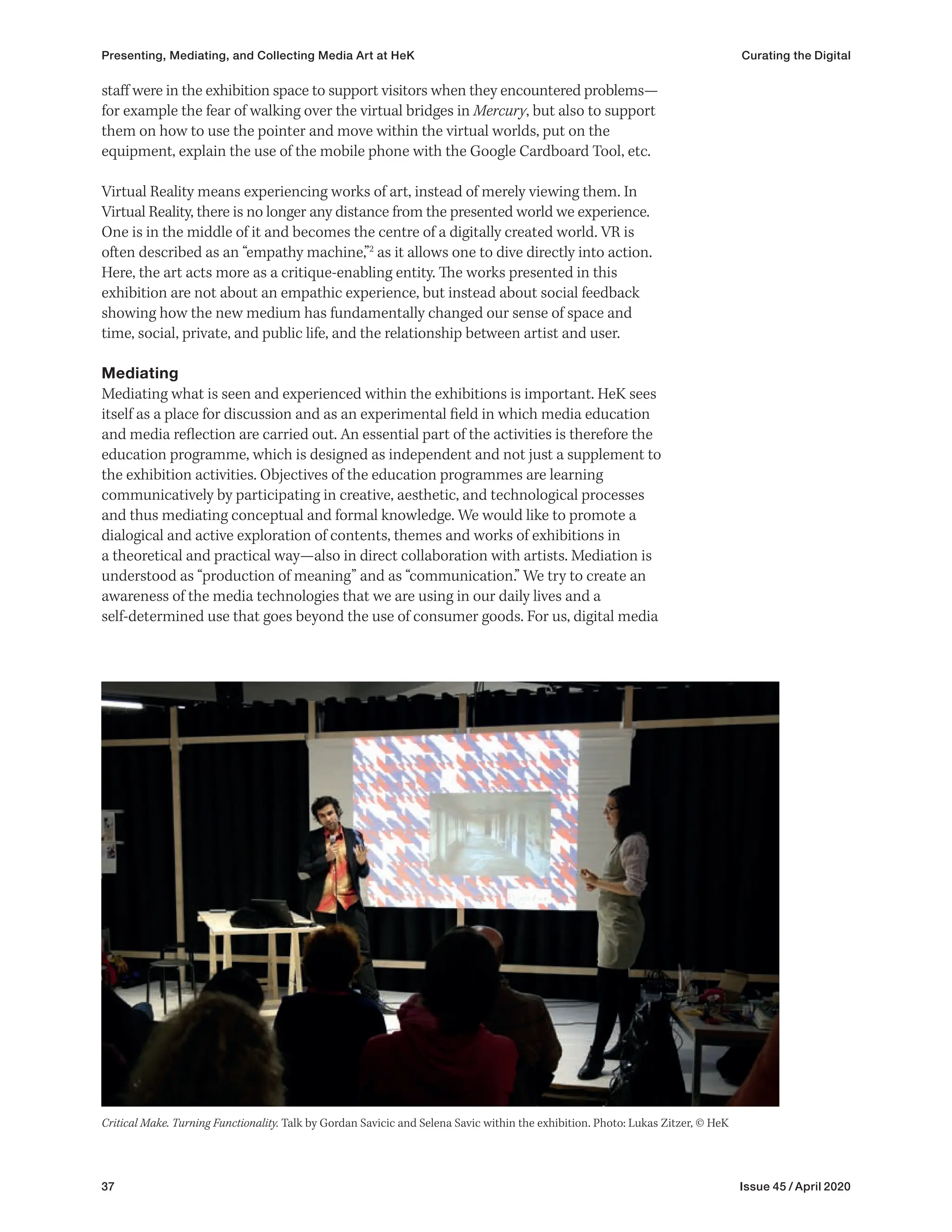
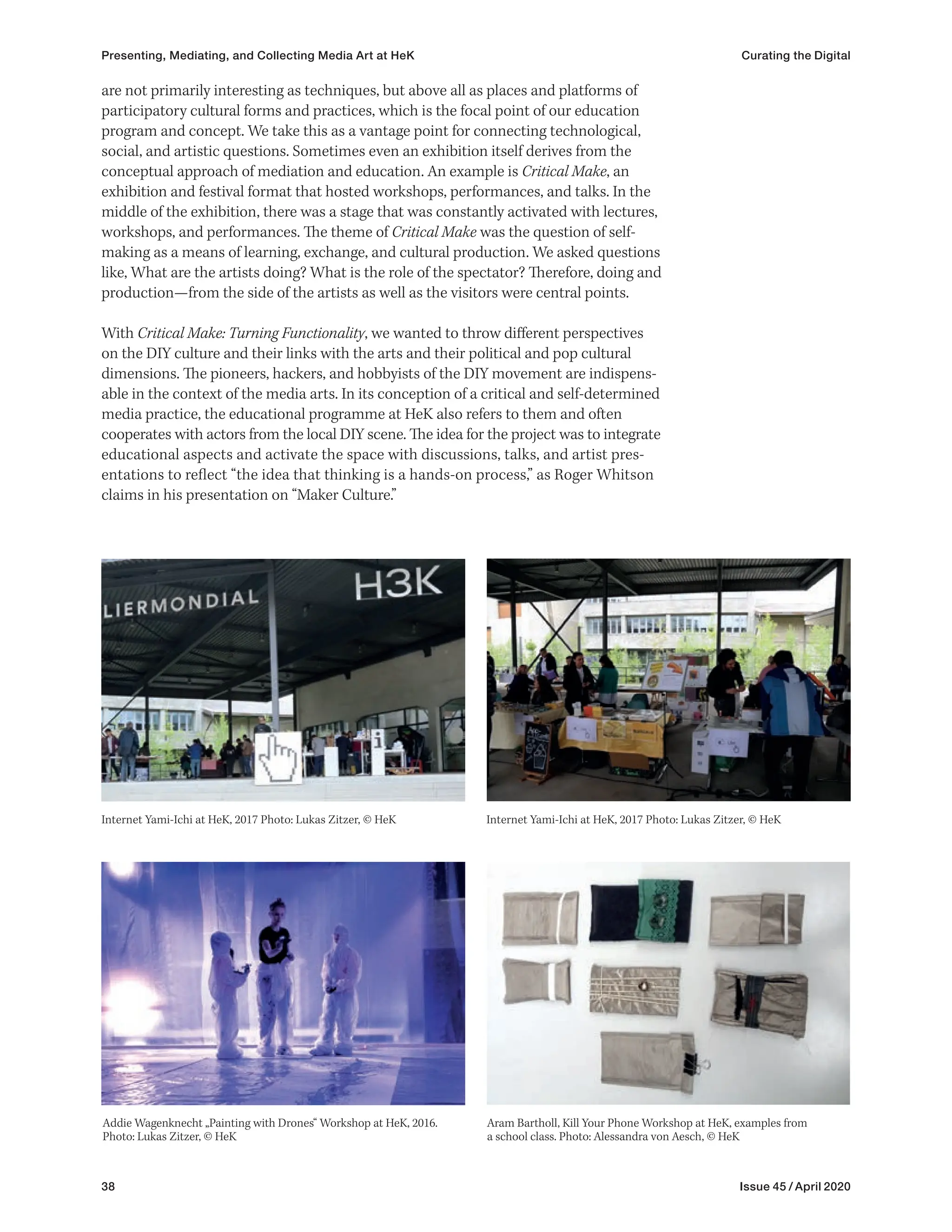
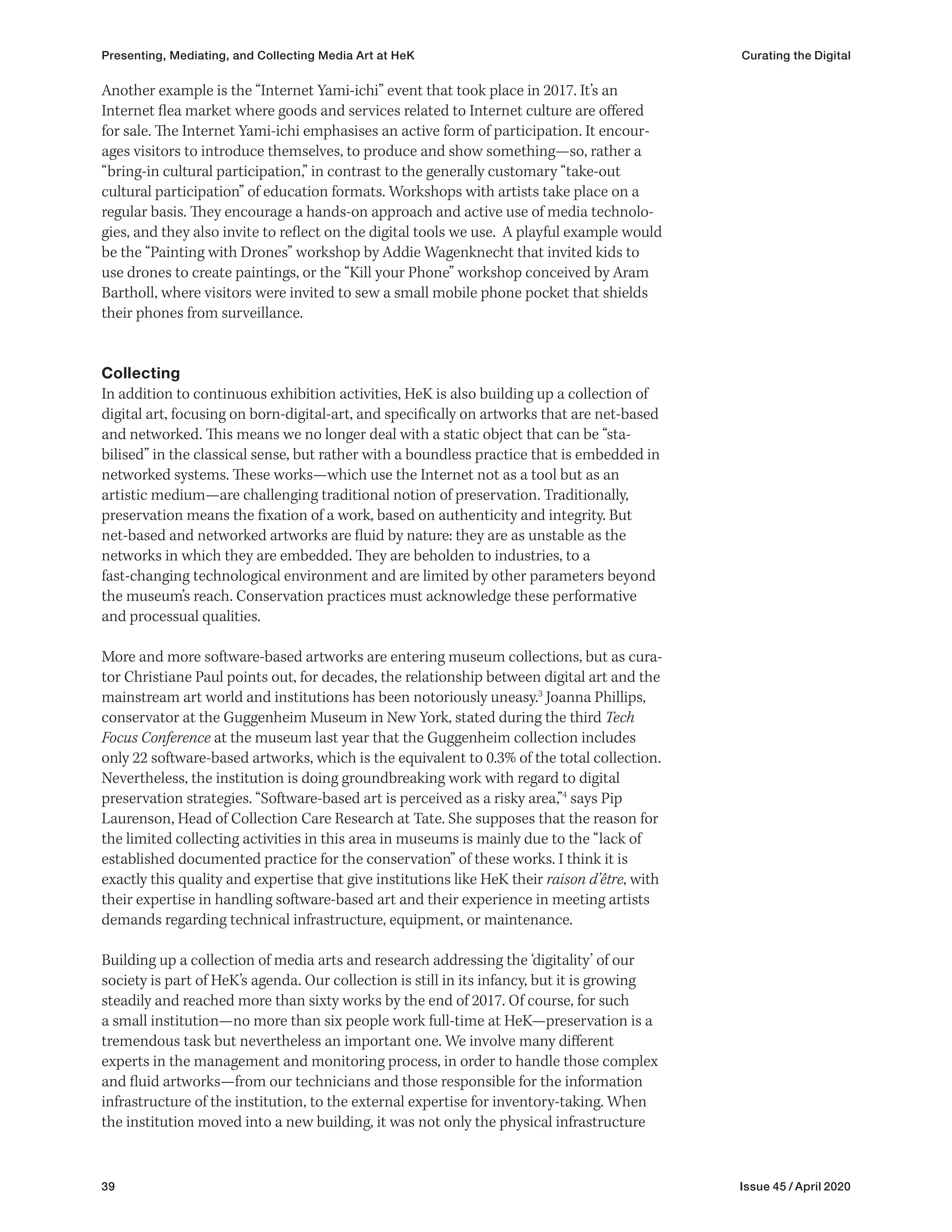
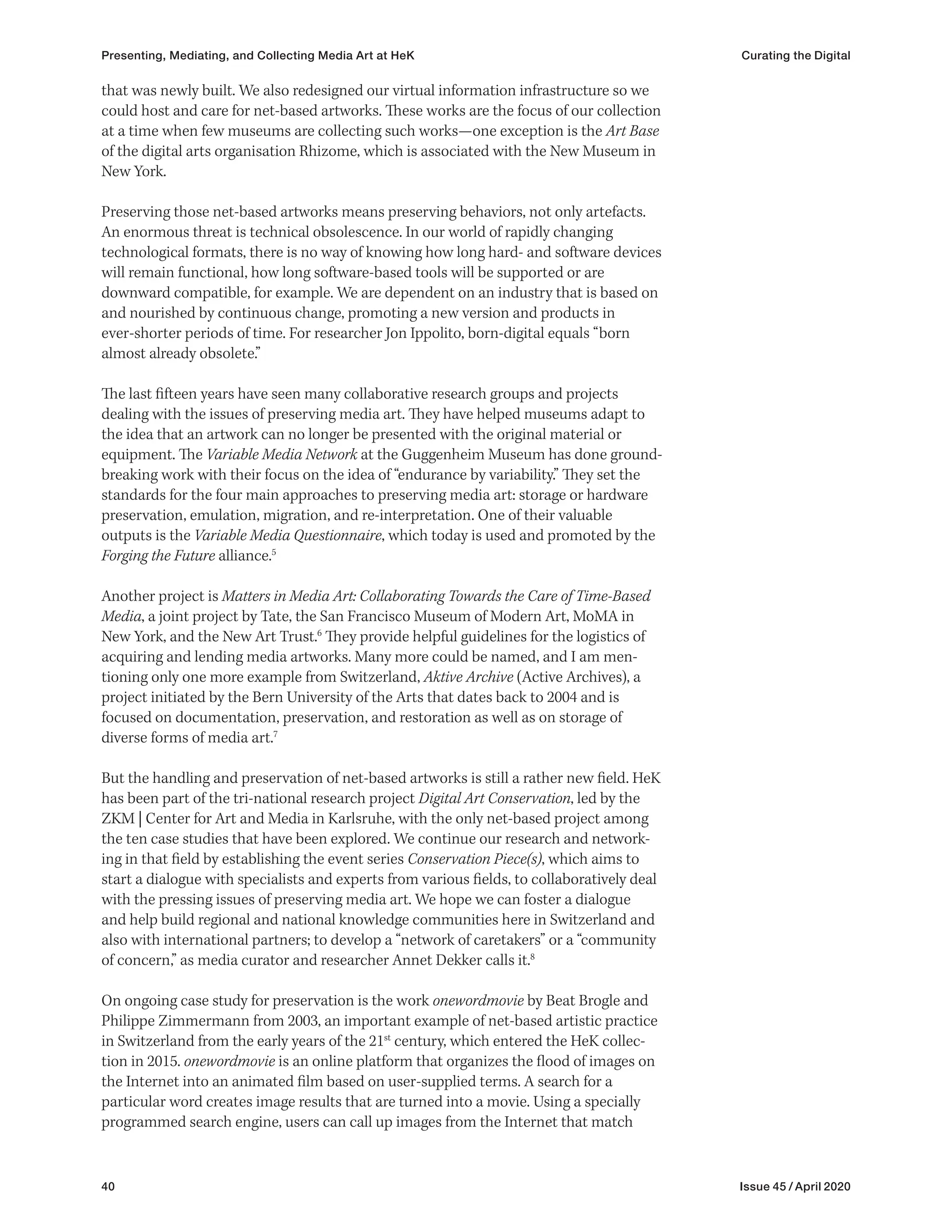
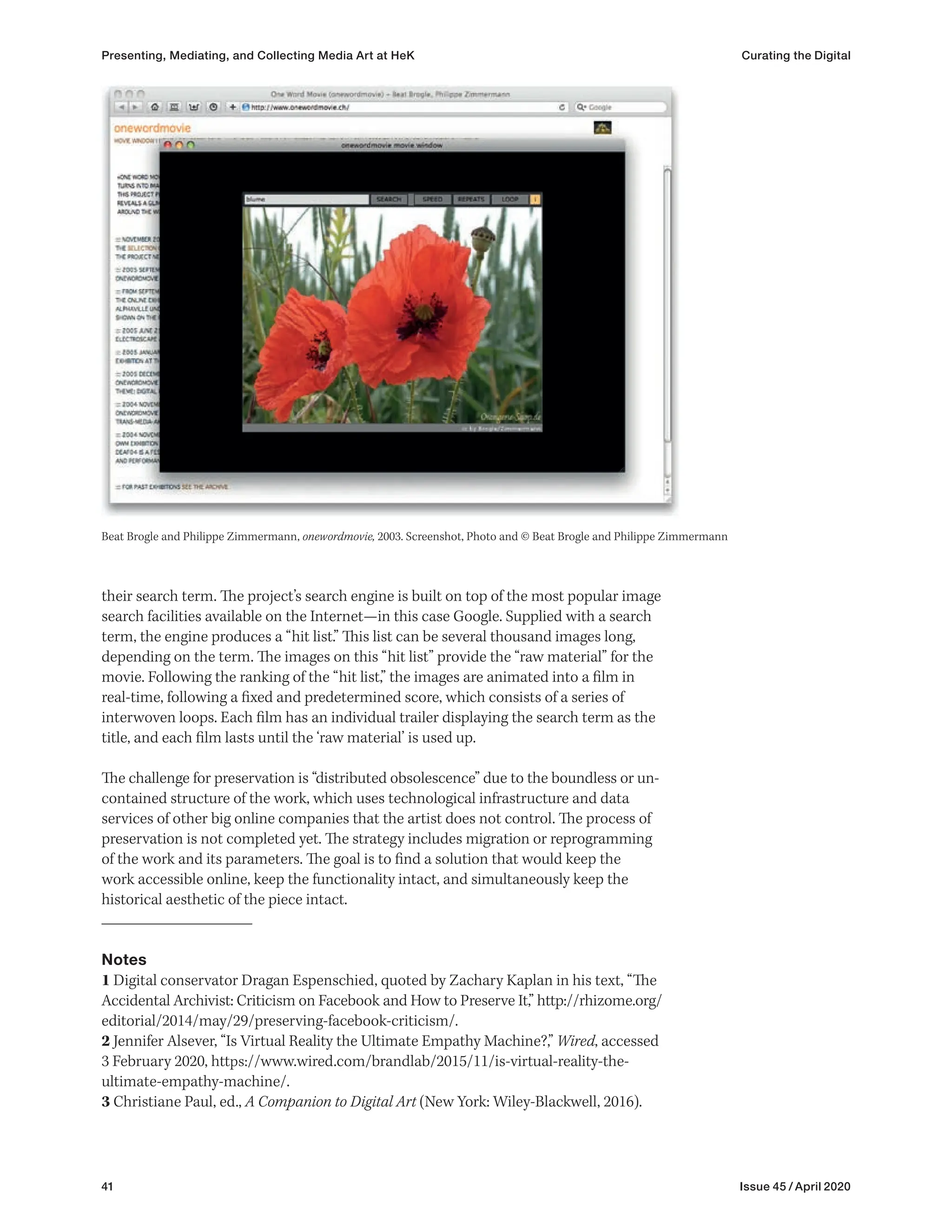
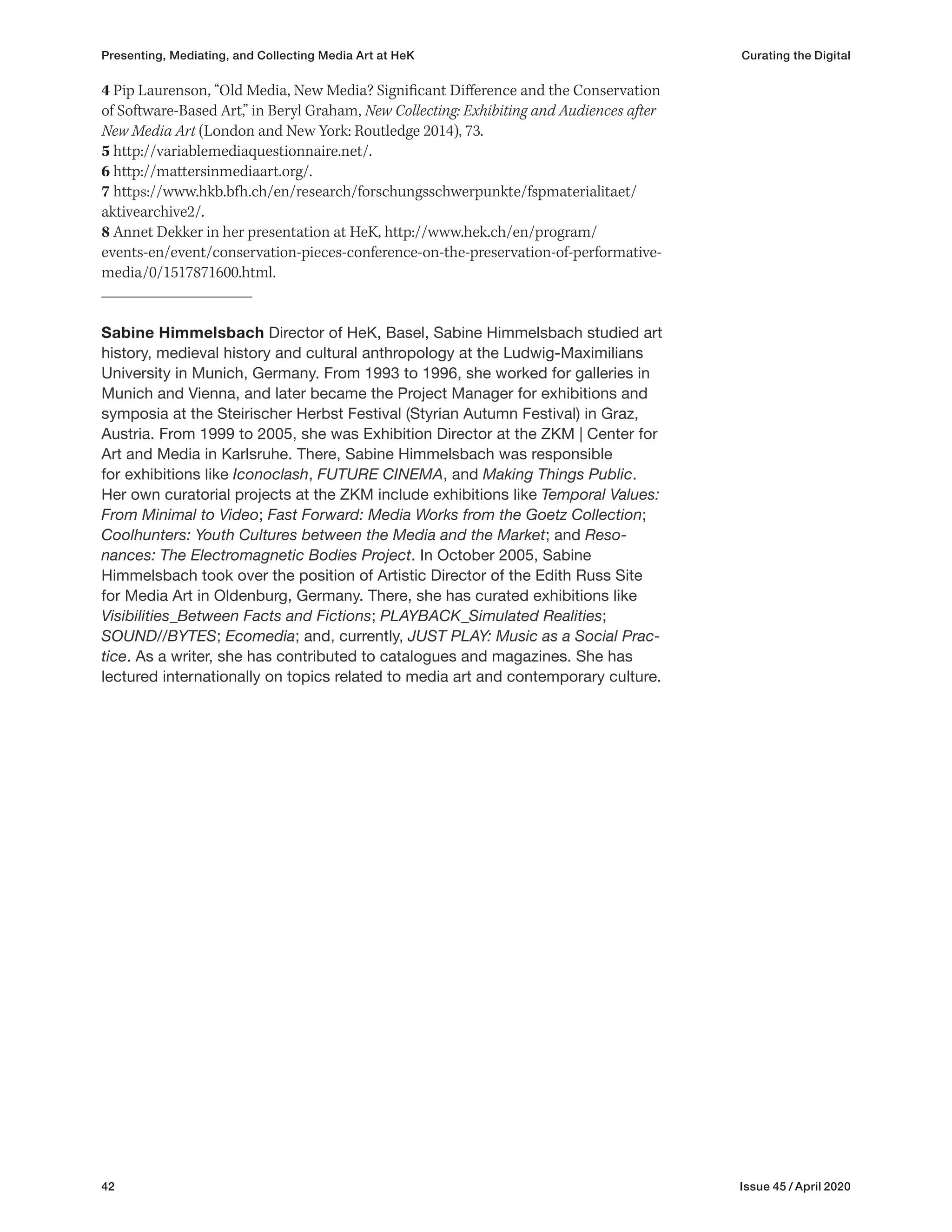
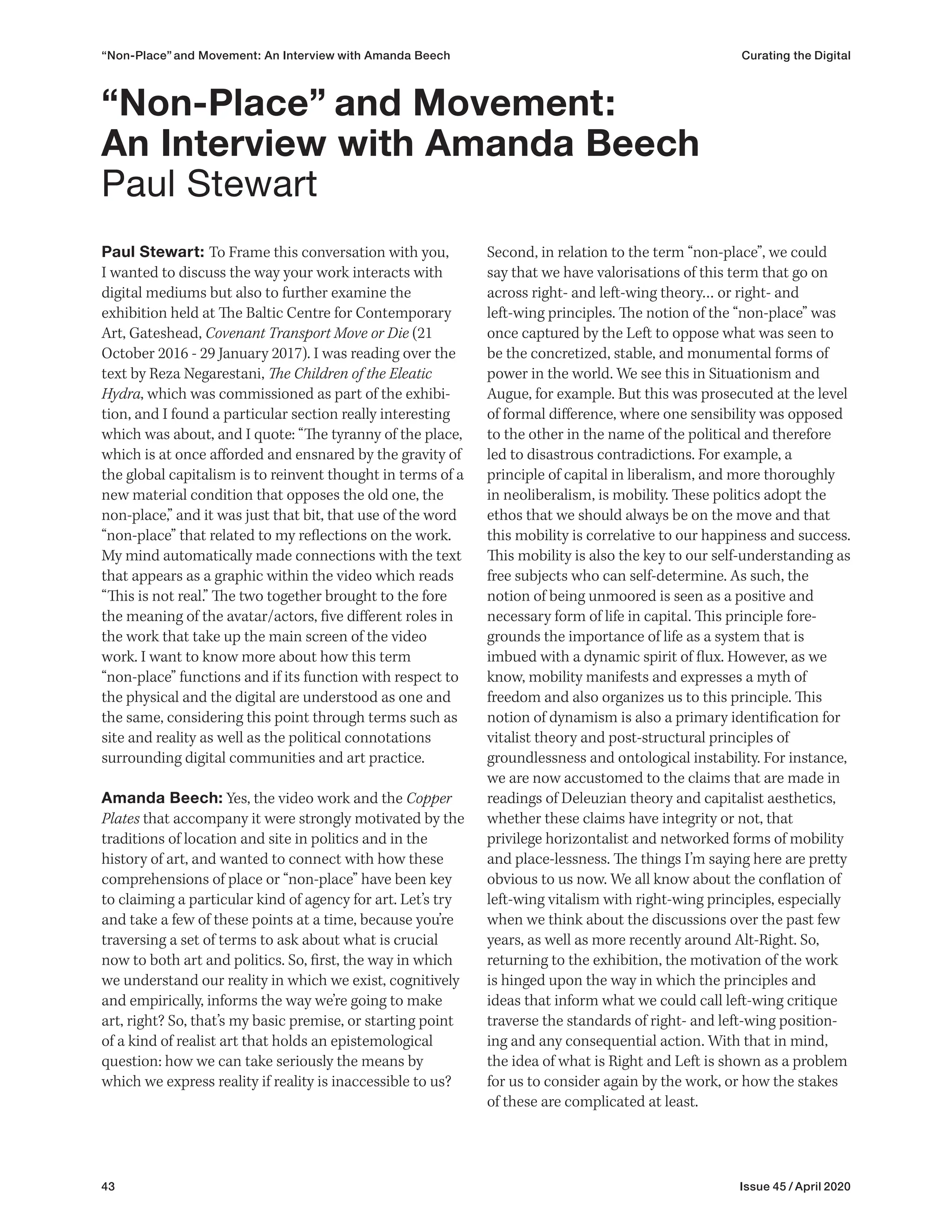
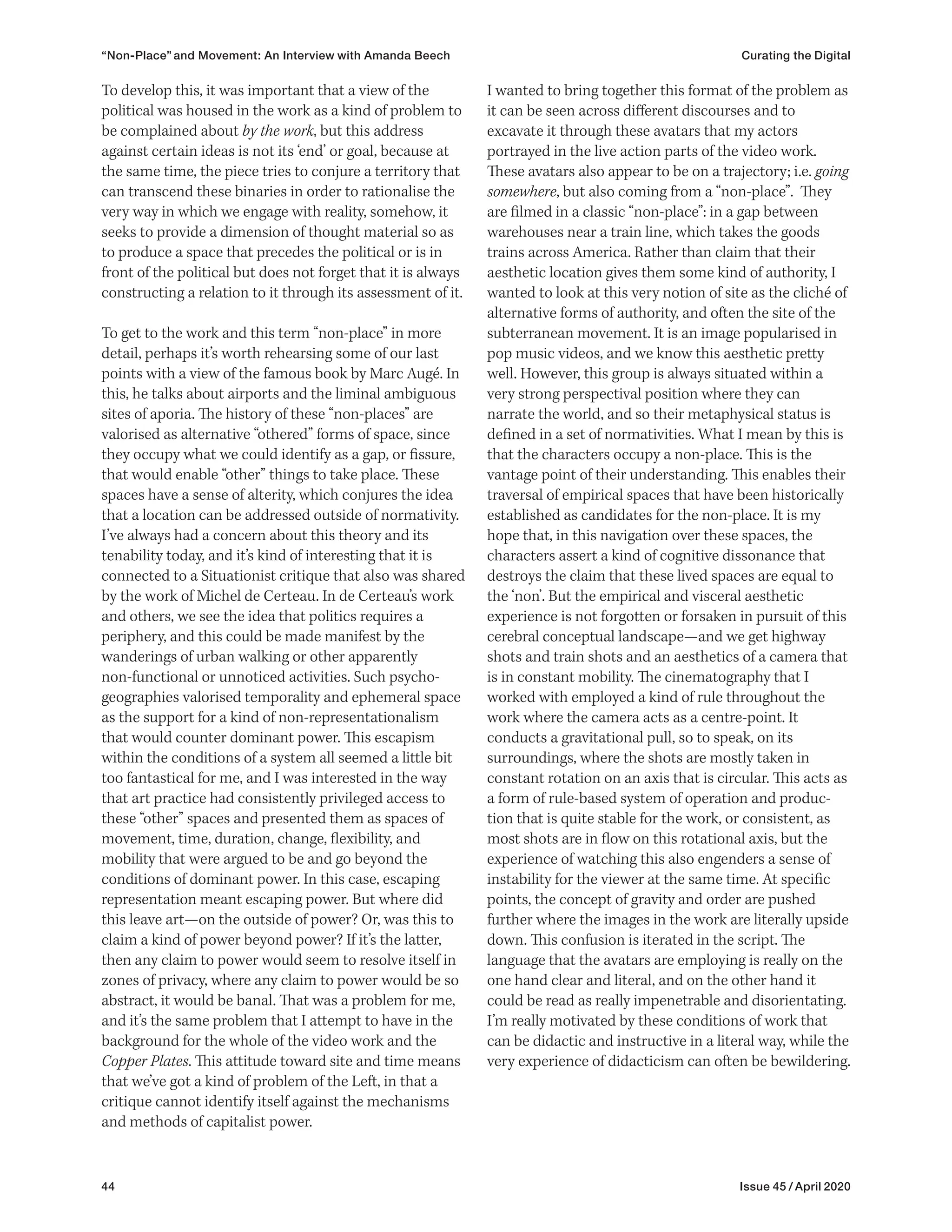


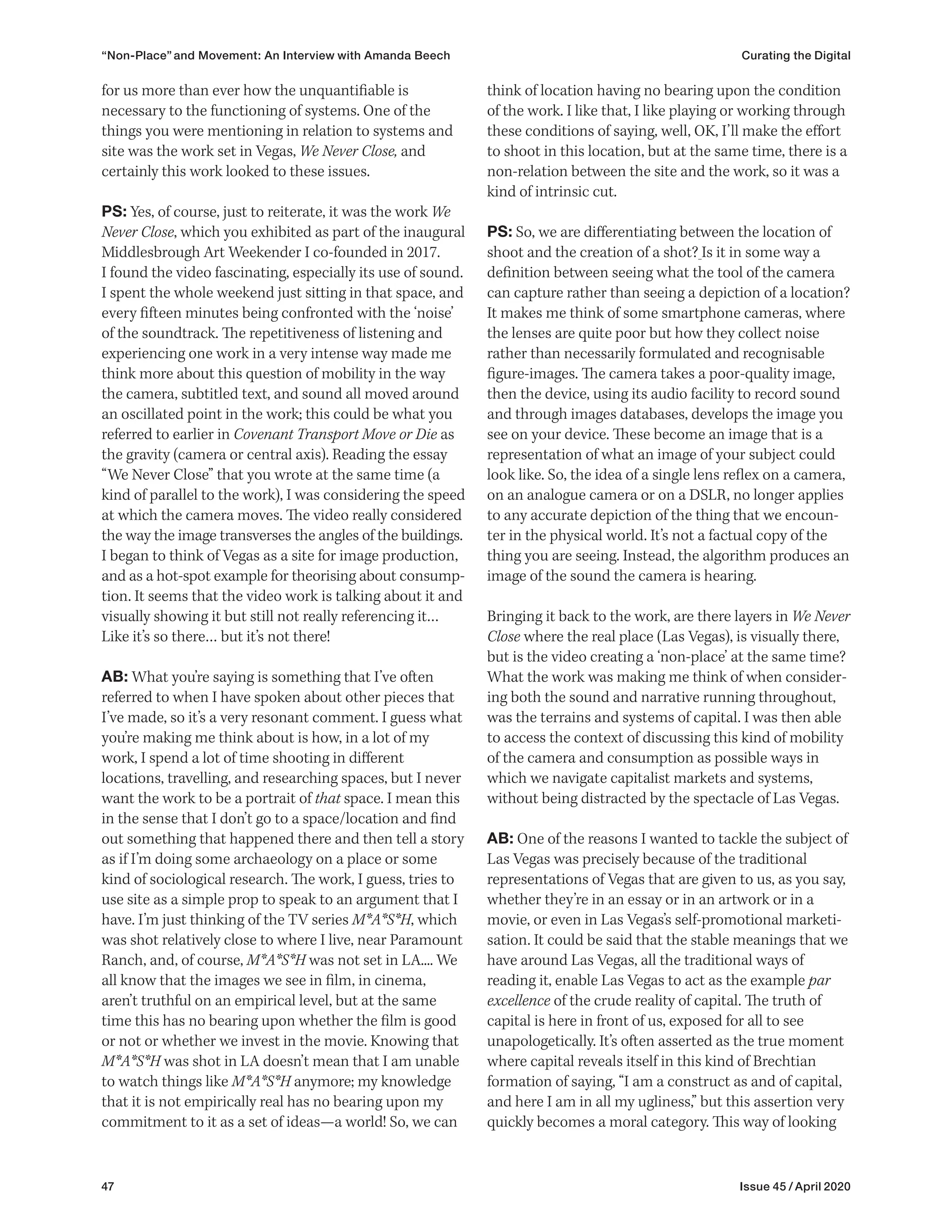
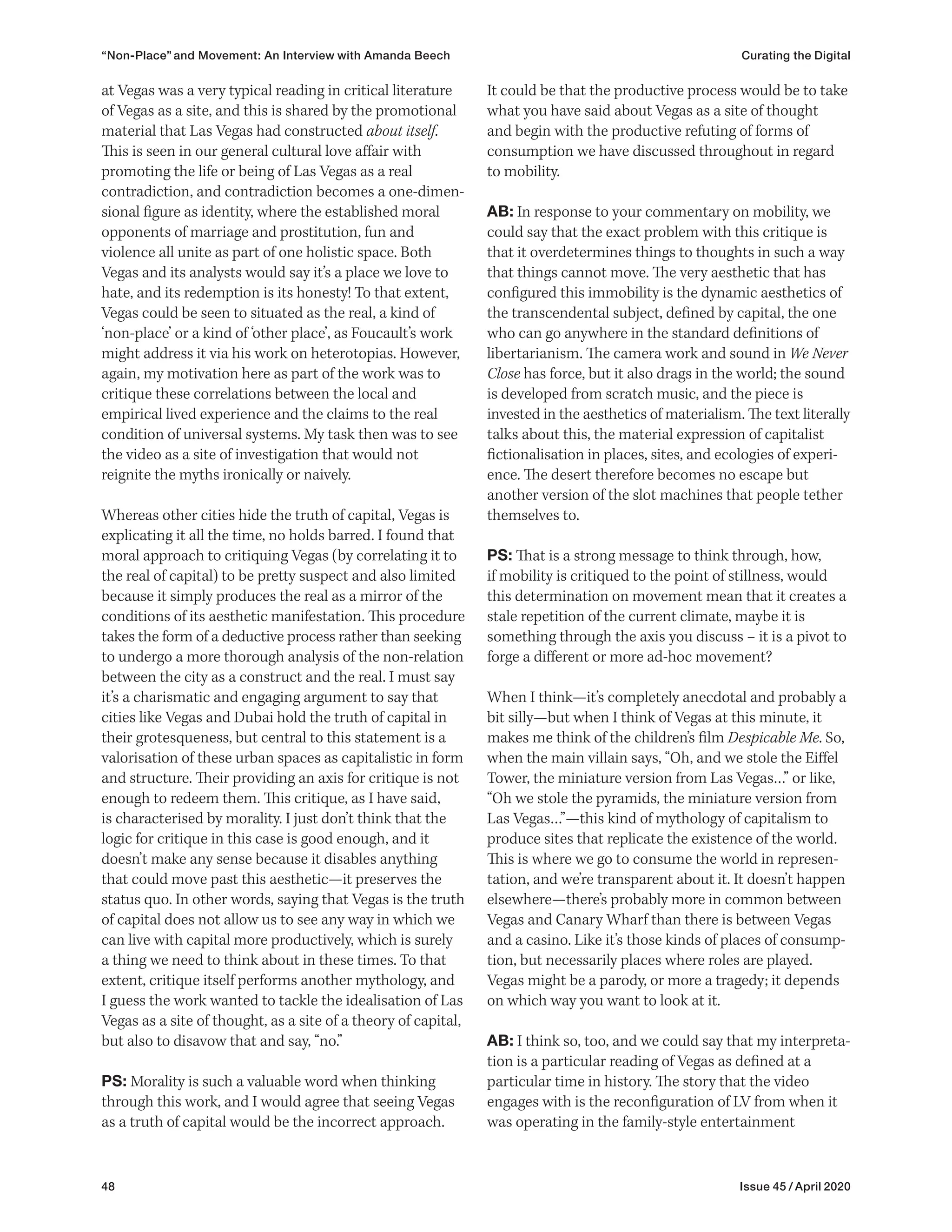
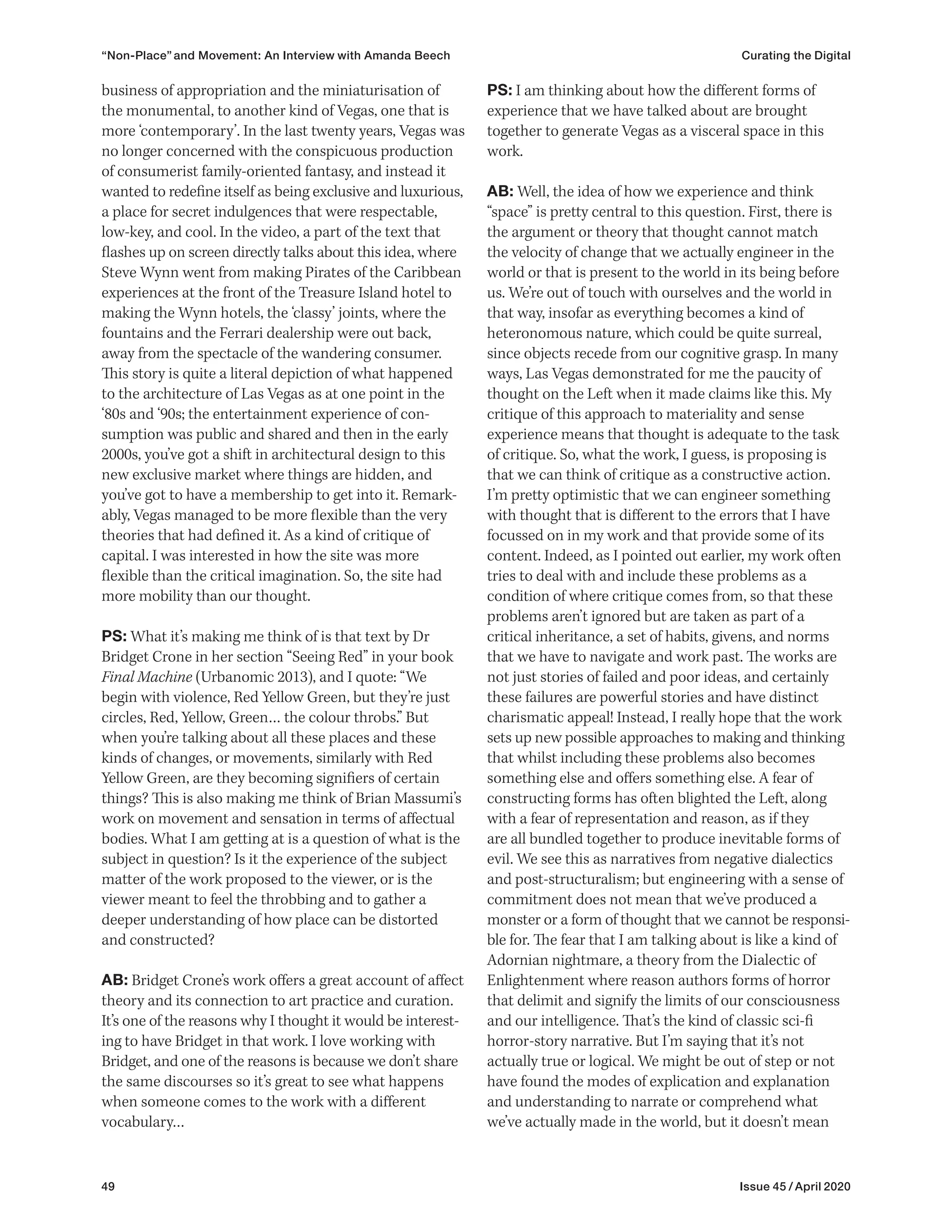

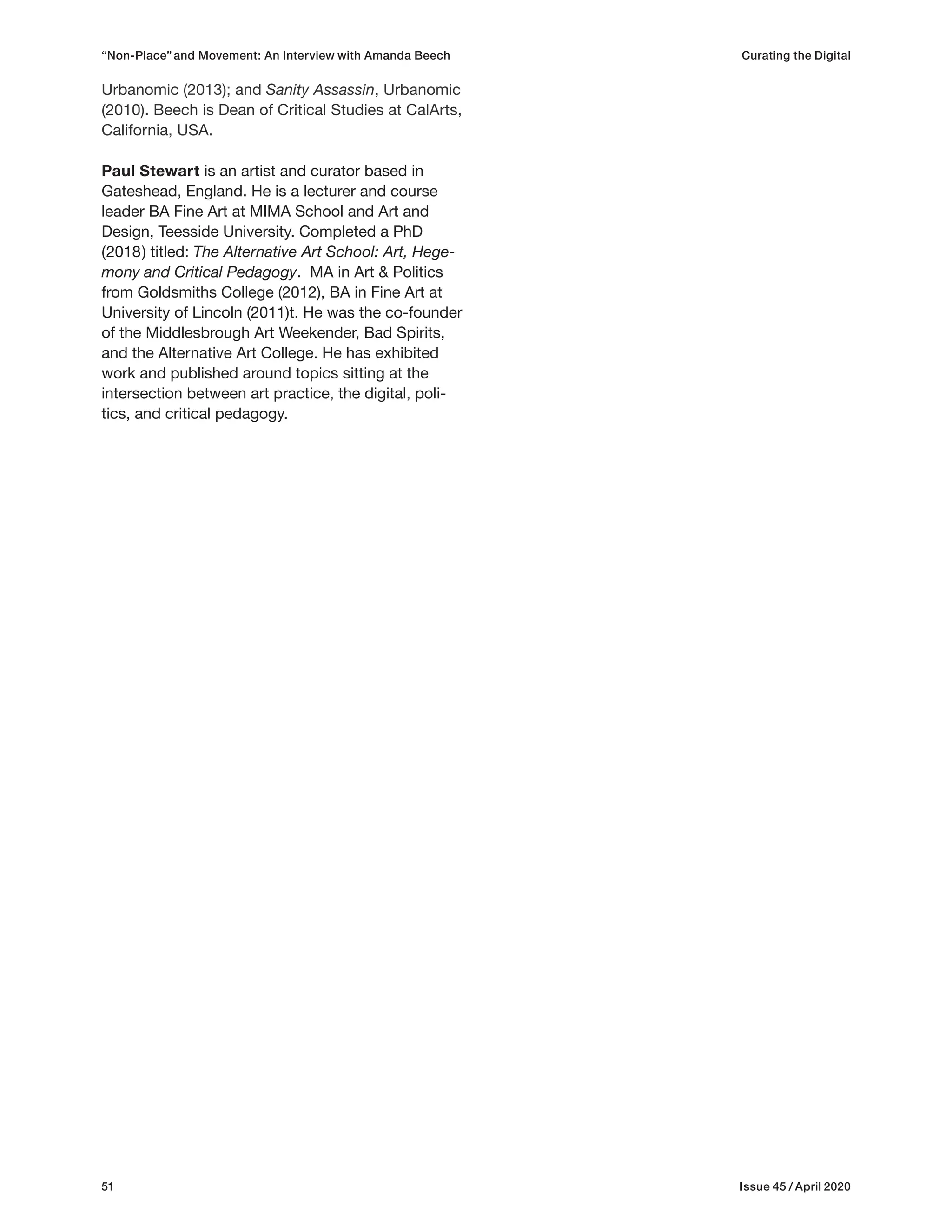
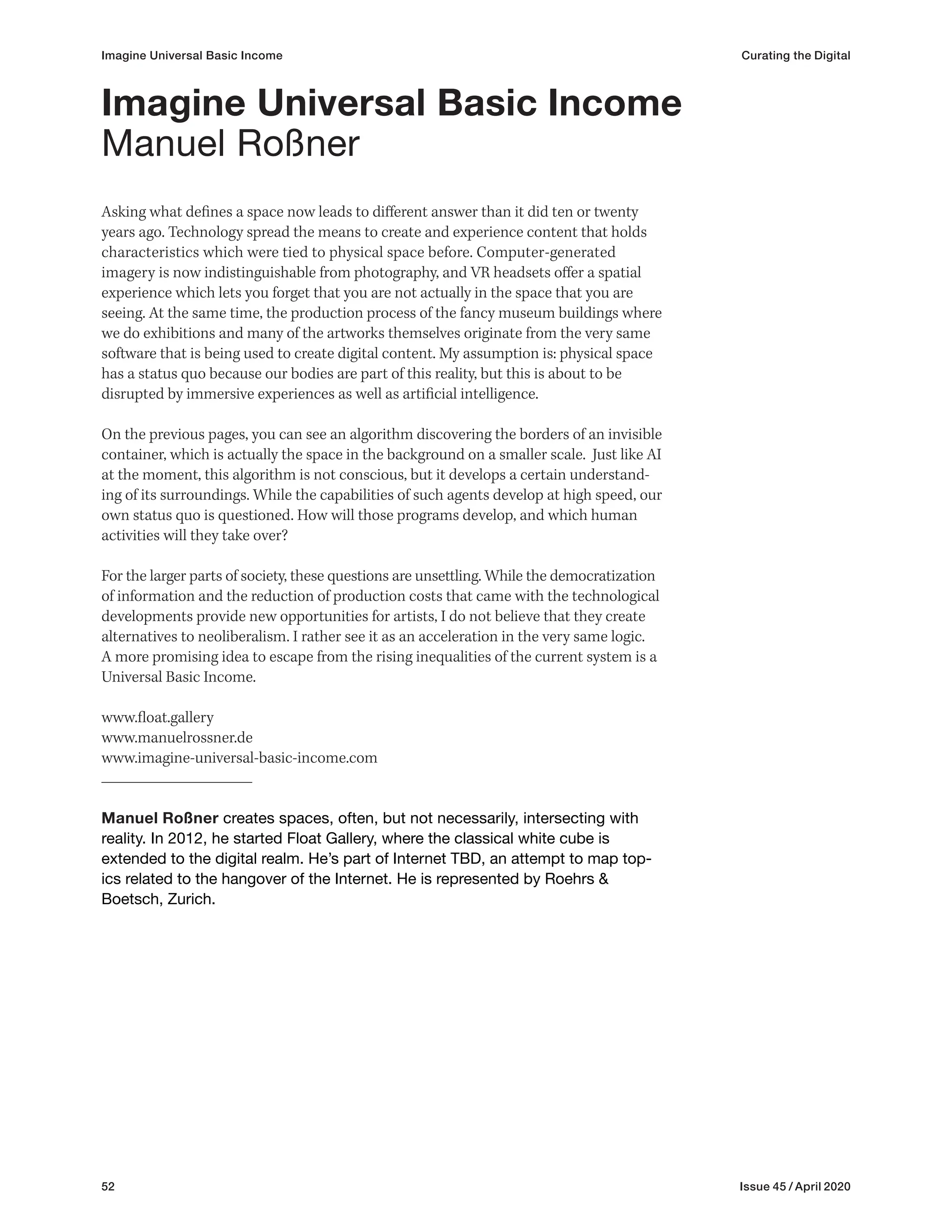
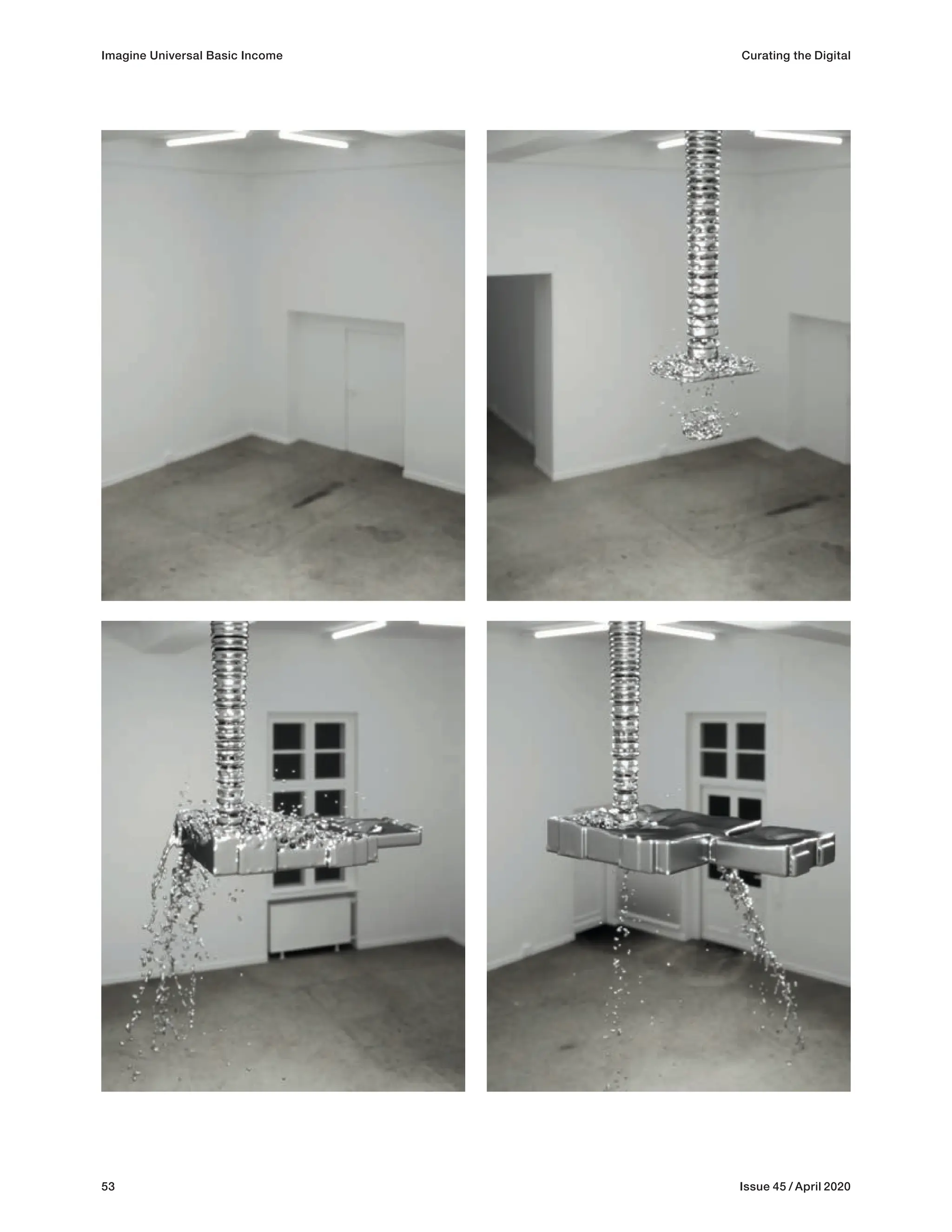
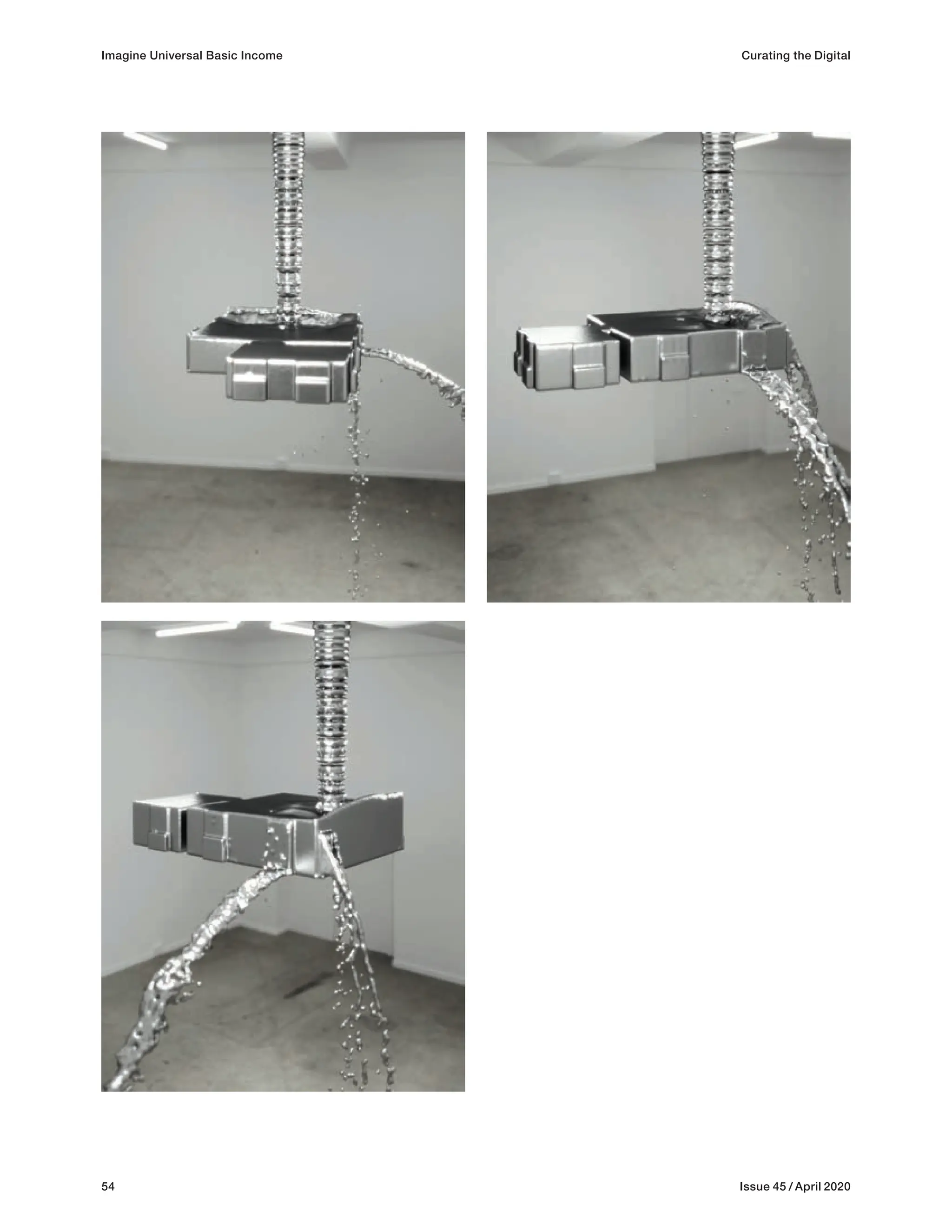
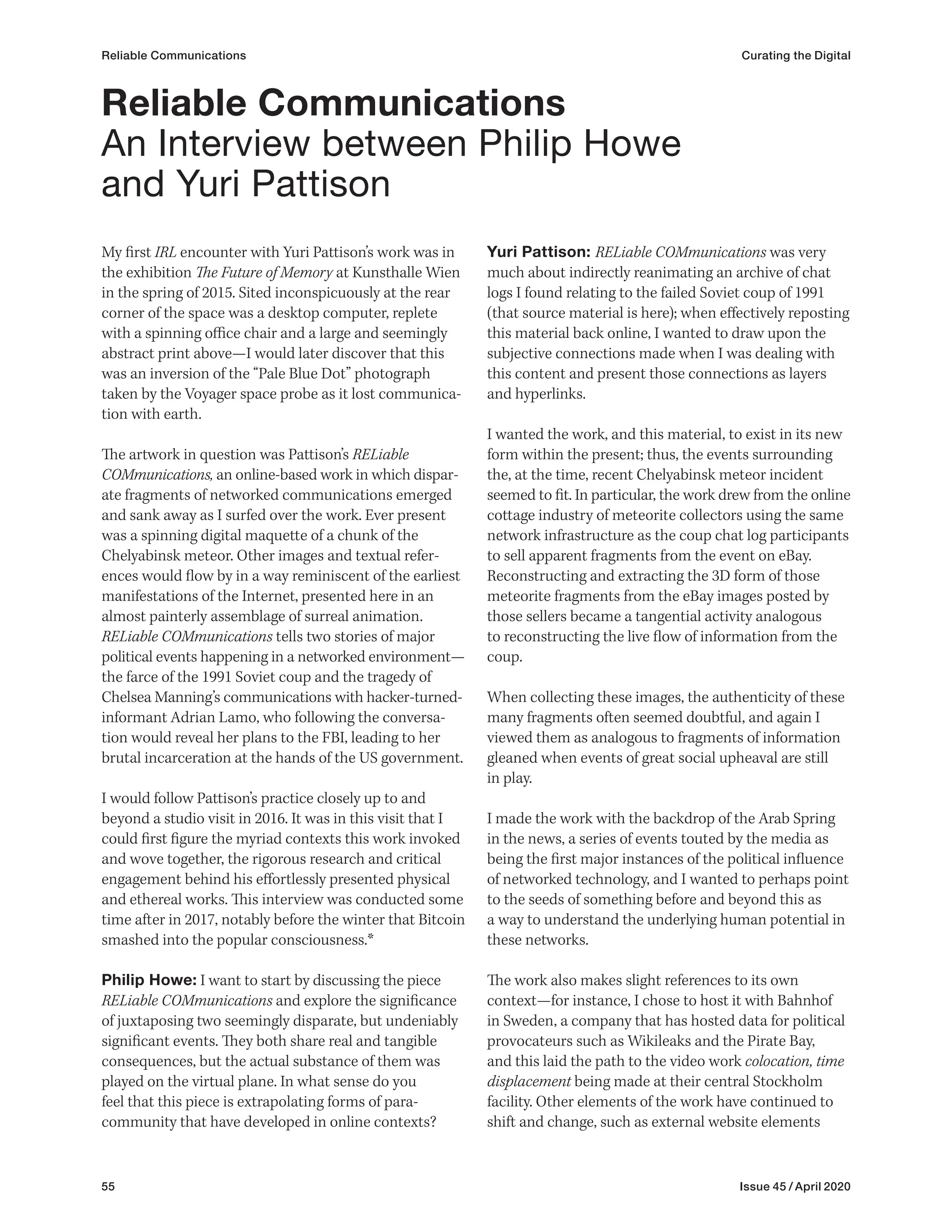
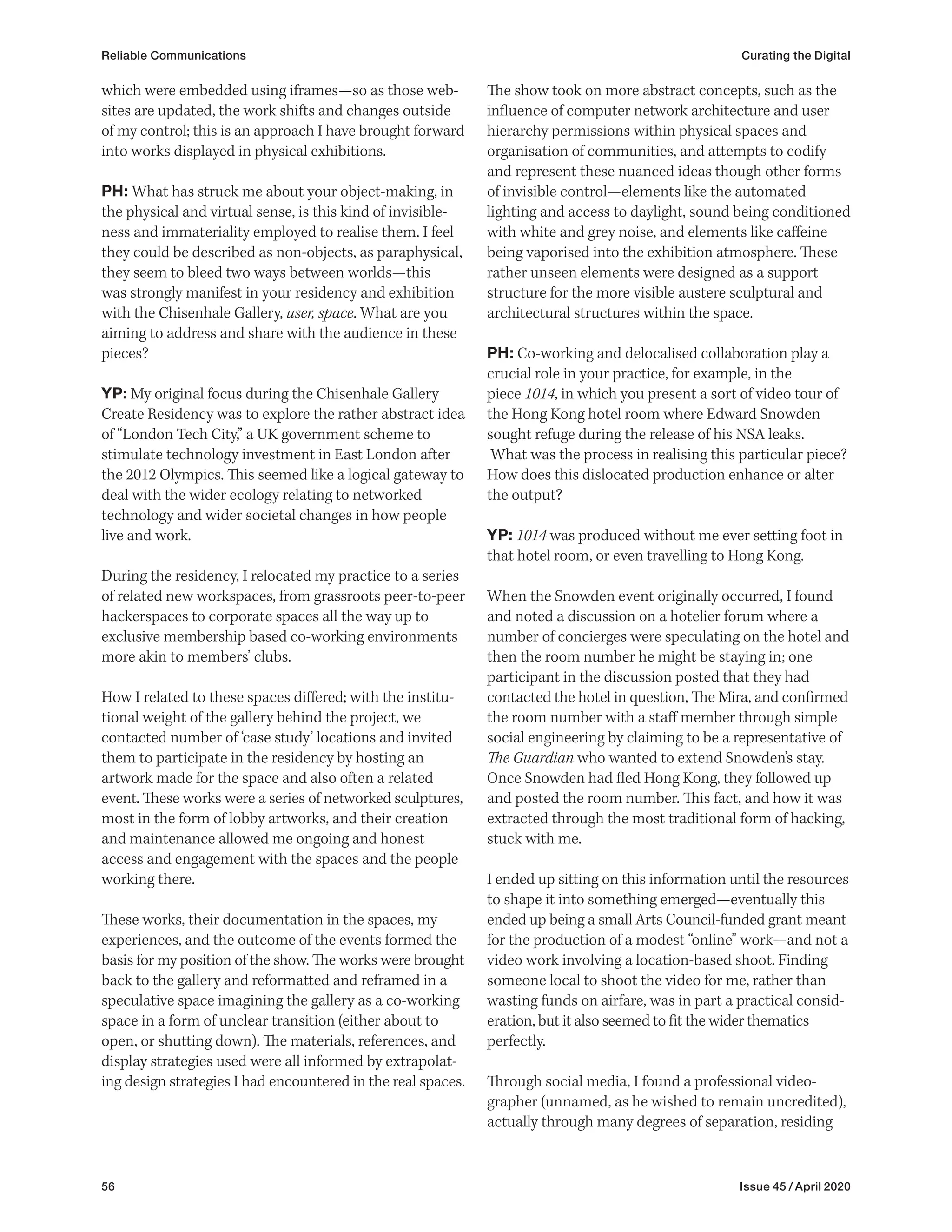
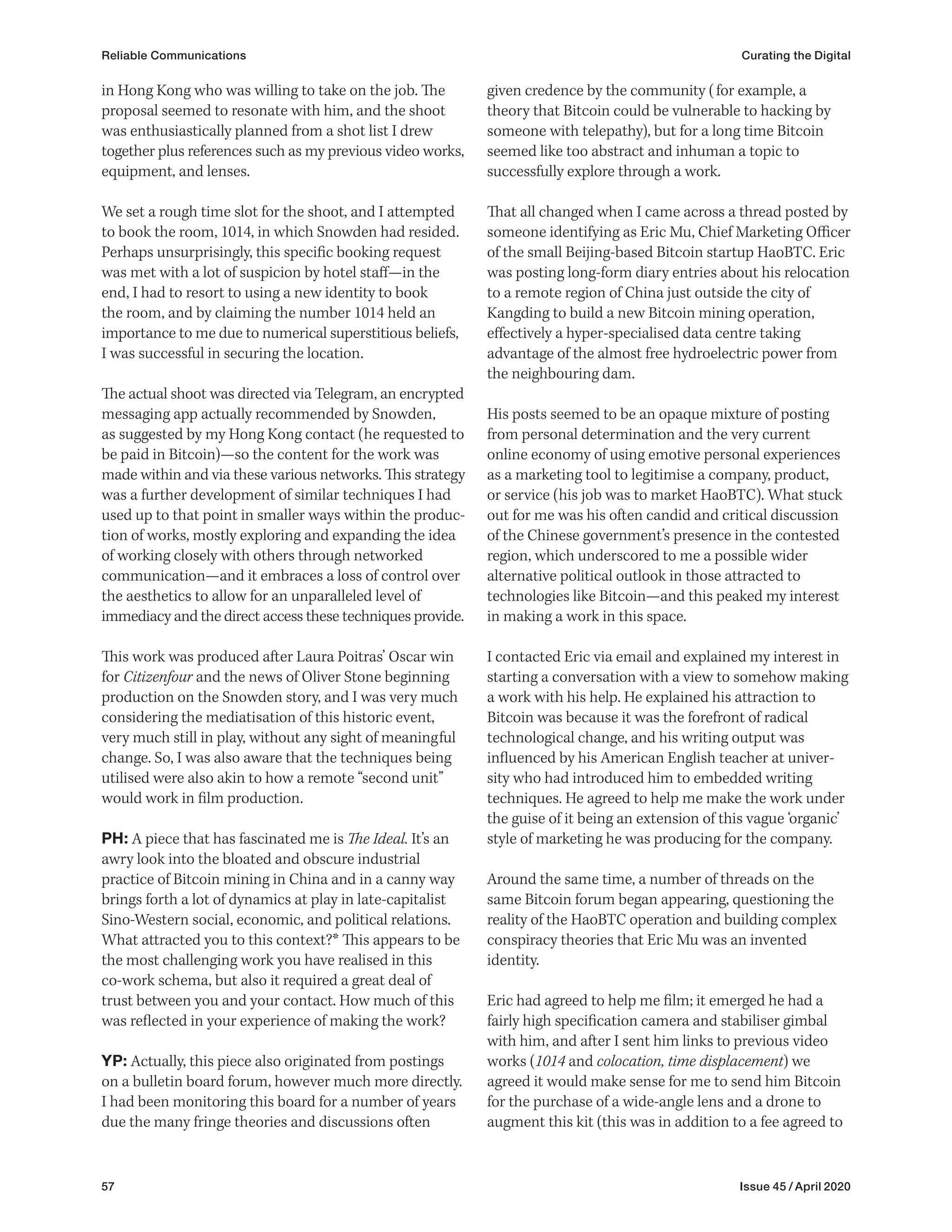
![58 Issue 45 / April 2020
Yuri Pattison is a tireless, natural thinker at the
forefront of a group of emerging artists/intellectuals
whose practices, in an inherently 21st
-century man-
ner, are informed by a seamless merger of hard and
soft realities. He works in sculpture and digital
media, exploring the visual culture of digital econo-
mies and the natures of online/offline skill sharing.
Typical, recent examples of his artworks thought-
fully list medium and/or displayed interior contents,
as if listed by border security agents: “custom
made perspex 1U format box, server PSU & switch,
server case fans, AI: The Tumultuous History of the
Search for Artificial Intelligence, by Daniel Crevier
(book), PDLC switchable privacy film, cables,
generic unpainted architectural 1:100 scale model
figures, dust, sebum [an oily secretion of the seba-
ceous glands], digital timers, travel power adapter…”
In October 2017, mother’s tankstation opened its
London gallery with context, collapse, a second
solo exhibition by Yuri Pattison. The artist’s first
solo exhibition with mother’s tankstation, sunset
provision, opened in November 2016. Pattison’s
recent solo exhibitions include Trusted Traveller,
Kunsthalle Sankt Gallen, Switzerland, and citizens
of nowhere, Kevin Space, Vienna, Austria (both
2017). He was one of four artists commissioned to
make new work for the inaugural exhibition at ICA
Miami, in December 2017. Earlier in 2017, an indic-
ative installation was acquired by the Irish Museum
of Modern Art. Yuri Pattison also holds consider-
able UK curatorial updraft, with a major work, the
ideal (v. 0.1), presented as part of British Art Show
8, 2015-2017, and he was the recipient of the 2016
Frieze Artist Award, culminating in a major new
commission, Insights (crisis trolley). The Tate Britain
exhibition, The Weight of Data, curated by Lizzie
Carey Thomas in 2015, also included a break-
through video sculpture, colocation, time displace-
ment. His practice was the focus of the prestigious
two-year CREATE residency at Chisenhale Gallery,
London, which concluded with a major solo show,
user, space, curated by Polly Staple in 2016.
cover his time). I used the majority of the funds given to
me for the production of a work for the British Art Show
and transferred these to Eric’s Bitcoin wallet—and then
waited.
Over a number of weeks, Eric began sending me first-
person POV explorations of the facility, living quarters,
and the day-to-day physical work in constructing this
digital currency production centre. We traded observa-
tions, questions, and ideas around the representation
of the facility but also ideas around currency and its longer
history—and some of these experiences and references
were codified into the physical sculptural elements I
used to house the video works.
The preview clips Eric was sending me were of lower
resolution, and on his return to Beijing he physically
sent me SD cards of the raw full-resolution footage—
this needed to be mailed due to the “Great Chinese
Firewall” preventing us from exchanging large files.
I requested Eric mail me stones he had collected from
the riverbed below the dam as a way to make visible
this physical exchange within the sculptural works.
The final video work is a combination of footage Eric
Mu shot for me and my own footage exploring micro-
scopic views of Bitcoin mining computer circuit boards,
and presents this in a sculptural form incorporating
an active water-cooled Bitcoin mining rig—producing
currency on the same network as referenced in the
video.
Ultimately, although this work is about the apparently
invisible and intangible Bitcoin technology, it more
closely looks at a wider story of the accelerated complex
physical developments, often not for the best, happen-
ing though advancements in networked technology and
the very human stories that happen within this.
Philip Howe is a London-based artworker, curator,
producer, and writer whose research and practice
focus on the intersections of contemporary art and
radical politics. Having graduated with an MA in Art
& Politics at Goldsmiths College in 2013, with a
particular focus on anarchism, conflict, and emerg-
ing technologies, Philip now produces expansive
projects and exhibitions with a/political, a non-profit
organisation dedicated to collaborations with
socio-political artists that tour institutions globally.
Reliable Communications Curating the Digital](https://image.slidesharecdn.com/curatingthedigital-231012212646-a91382ef/75/Curating_the_Digital-pdf-59-2048.jpg)
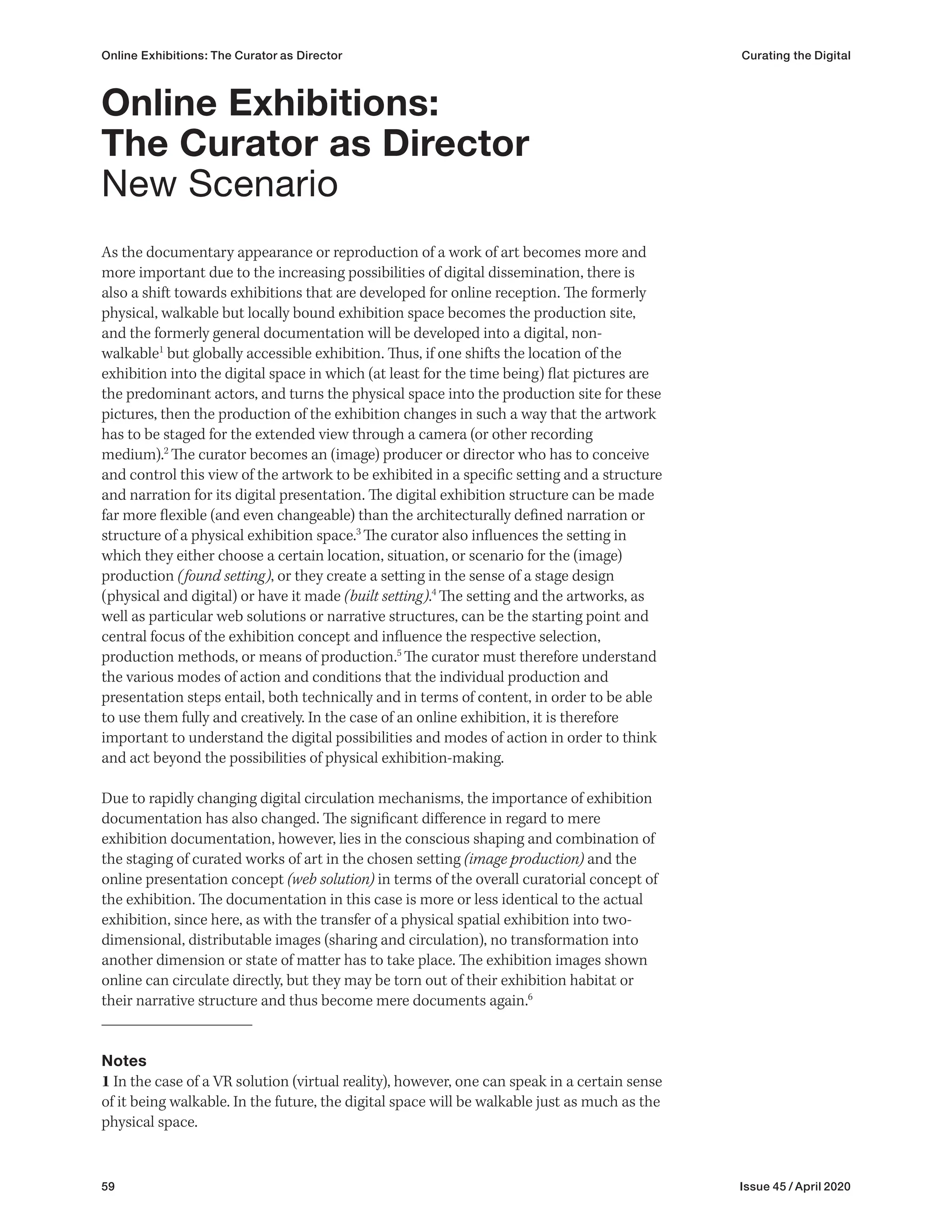
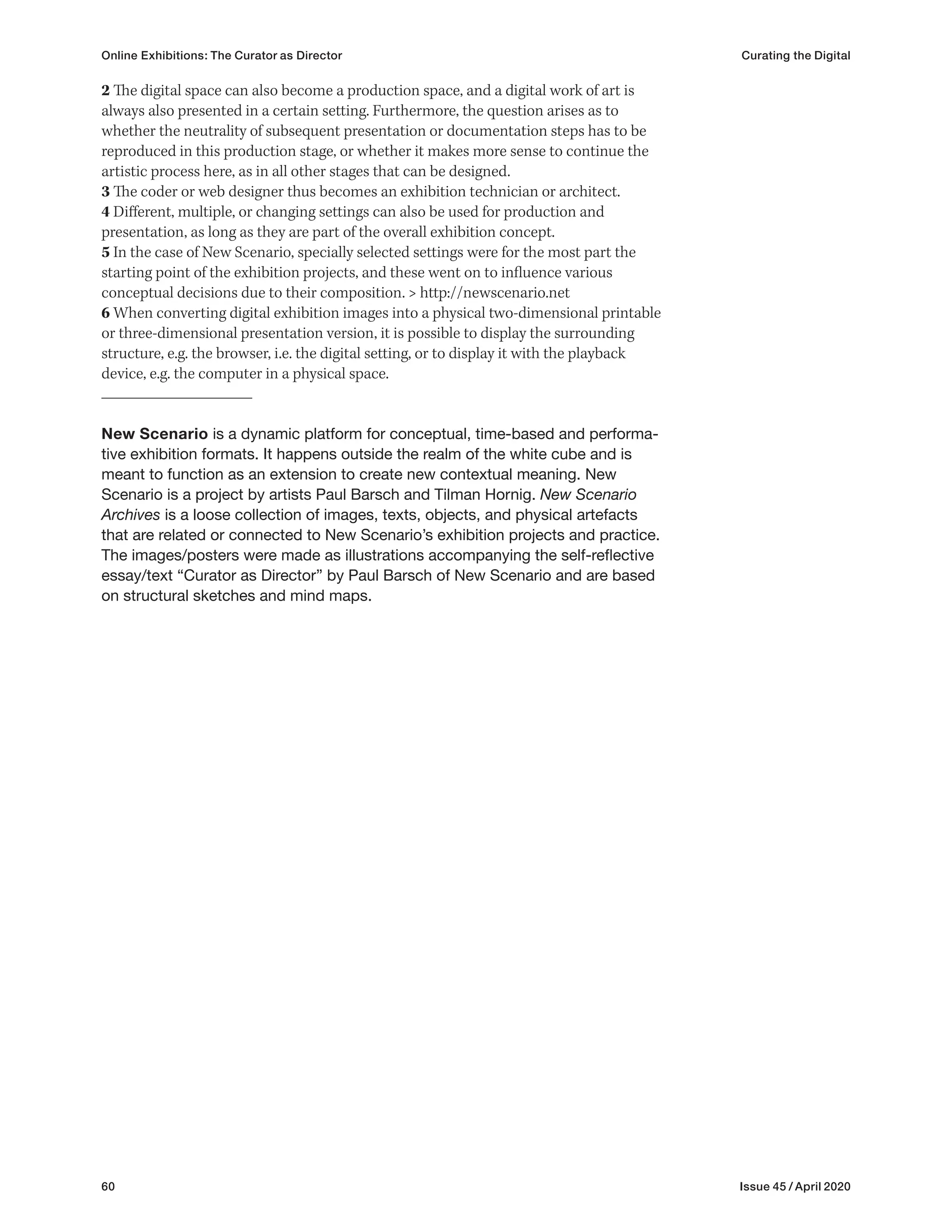
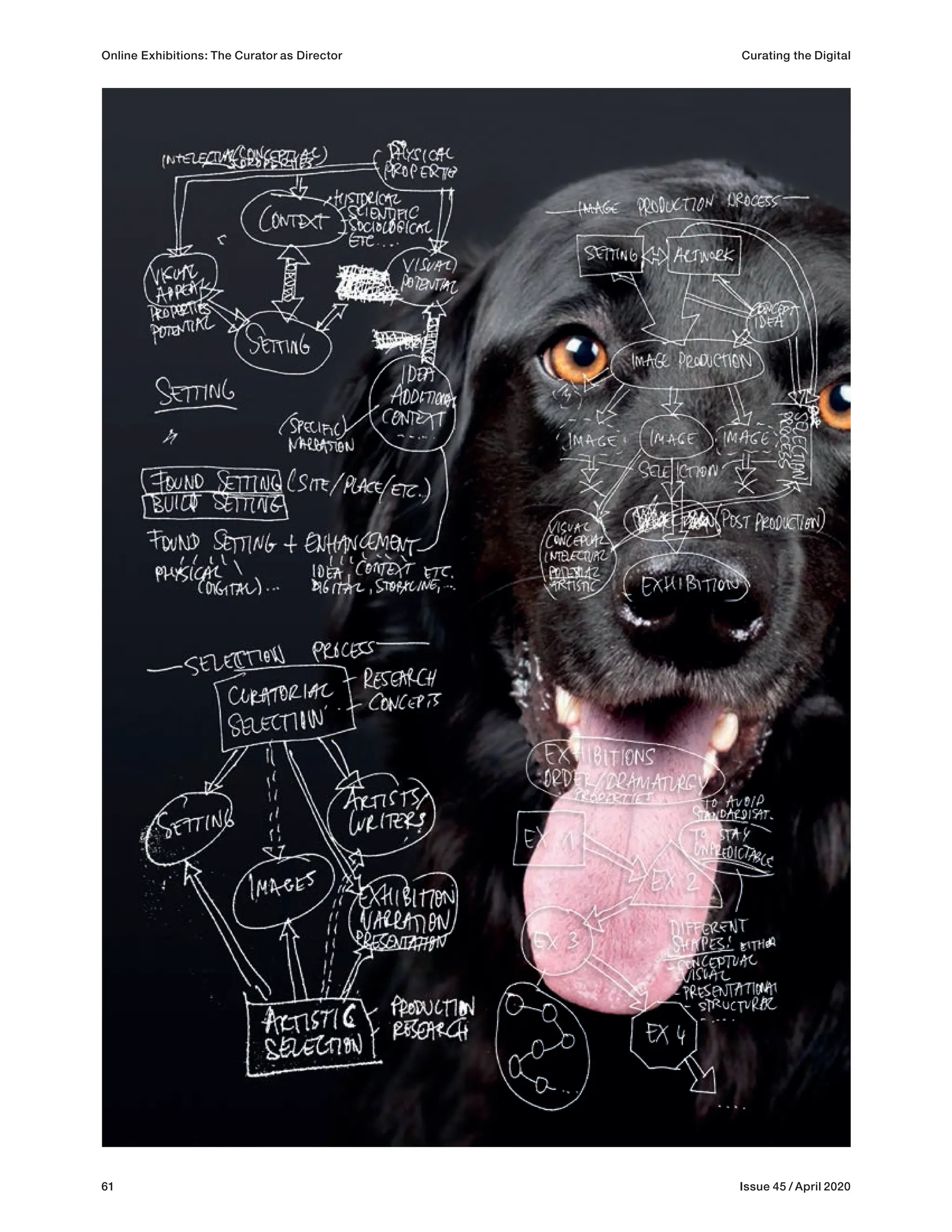
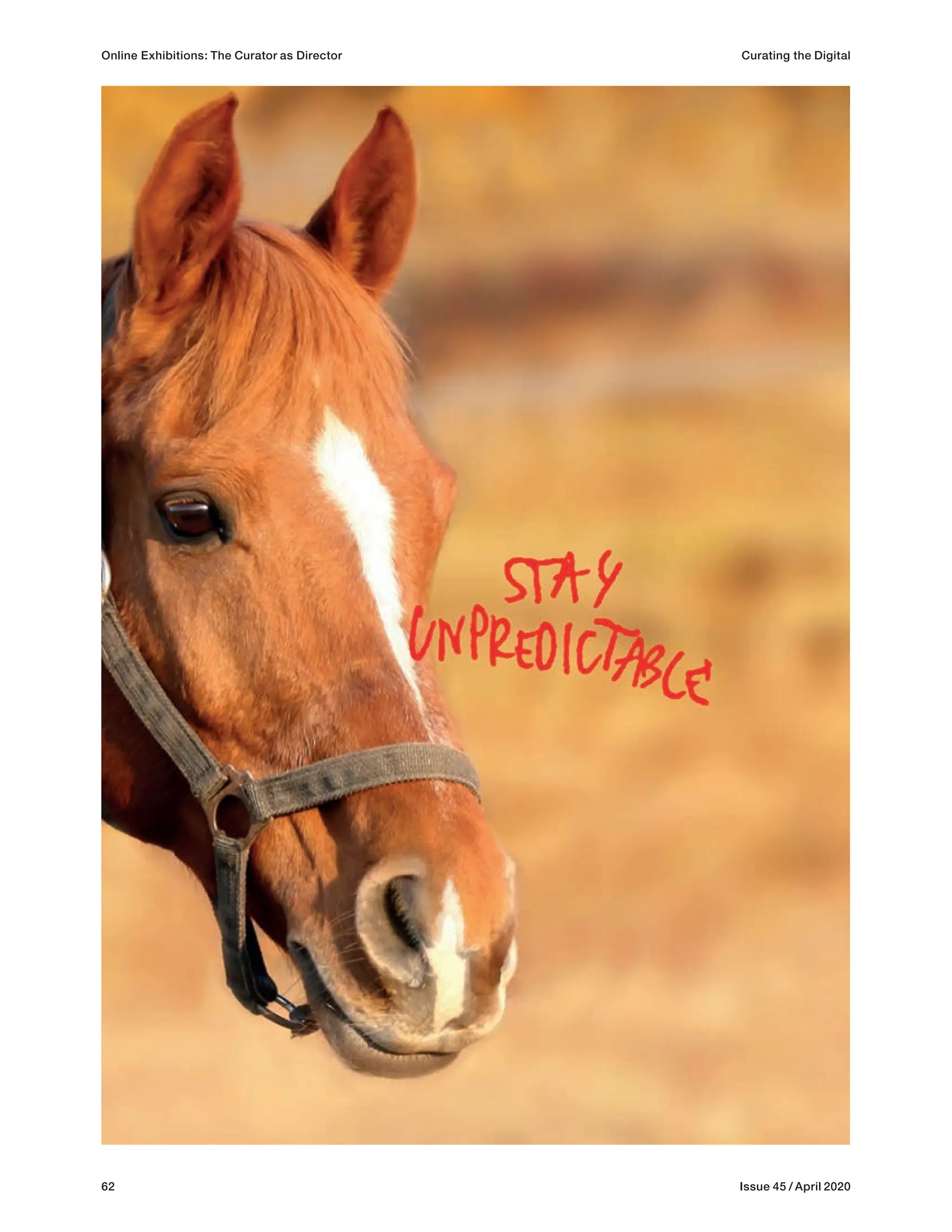
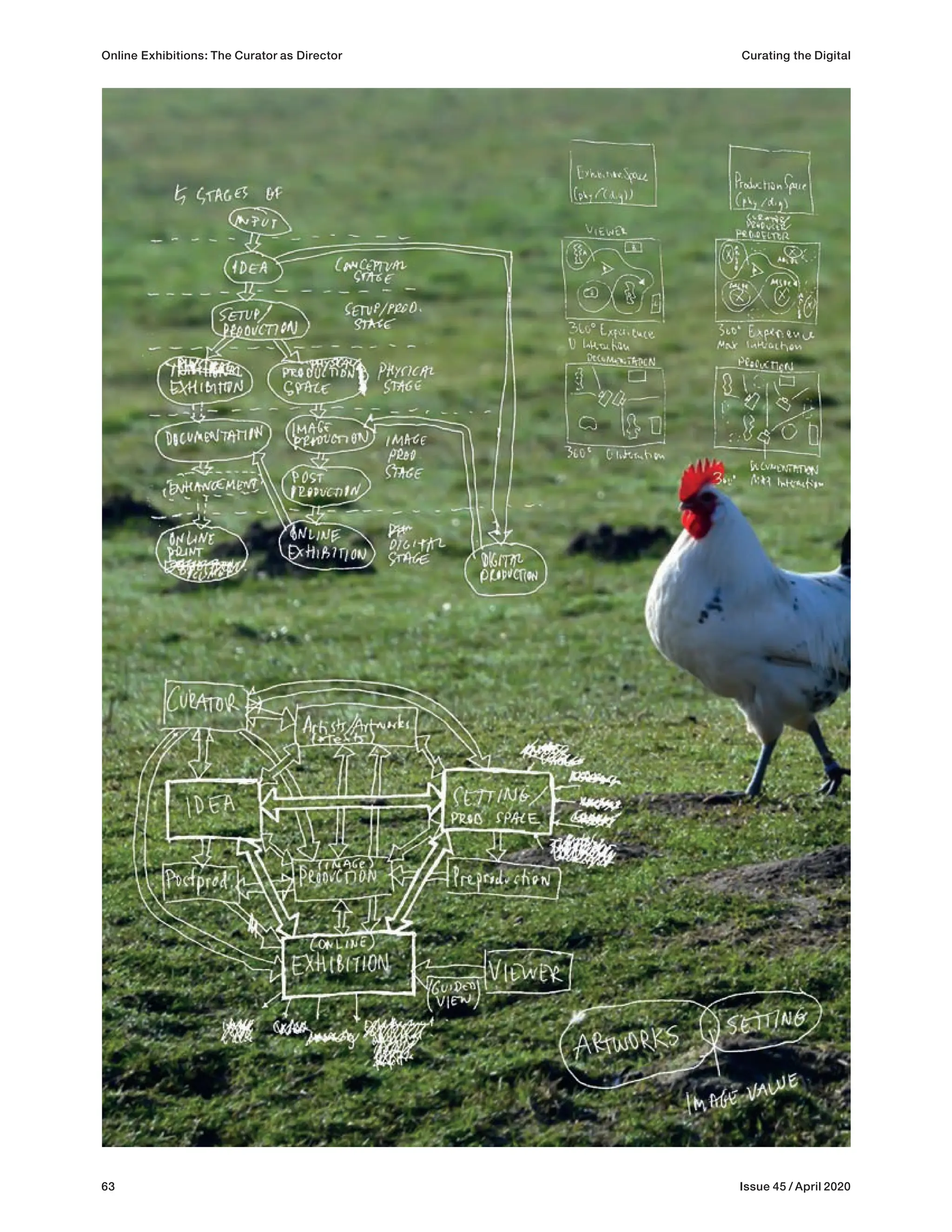
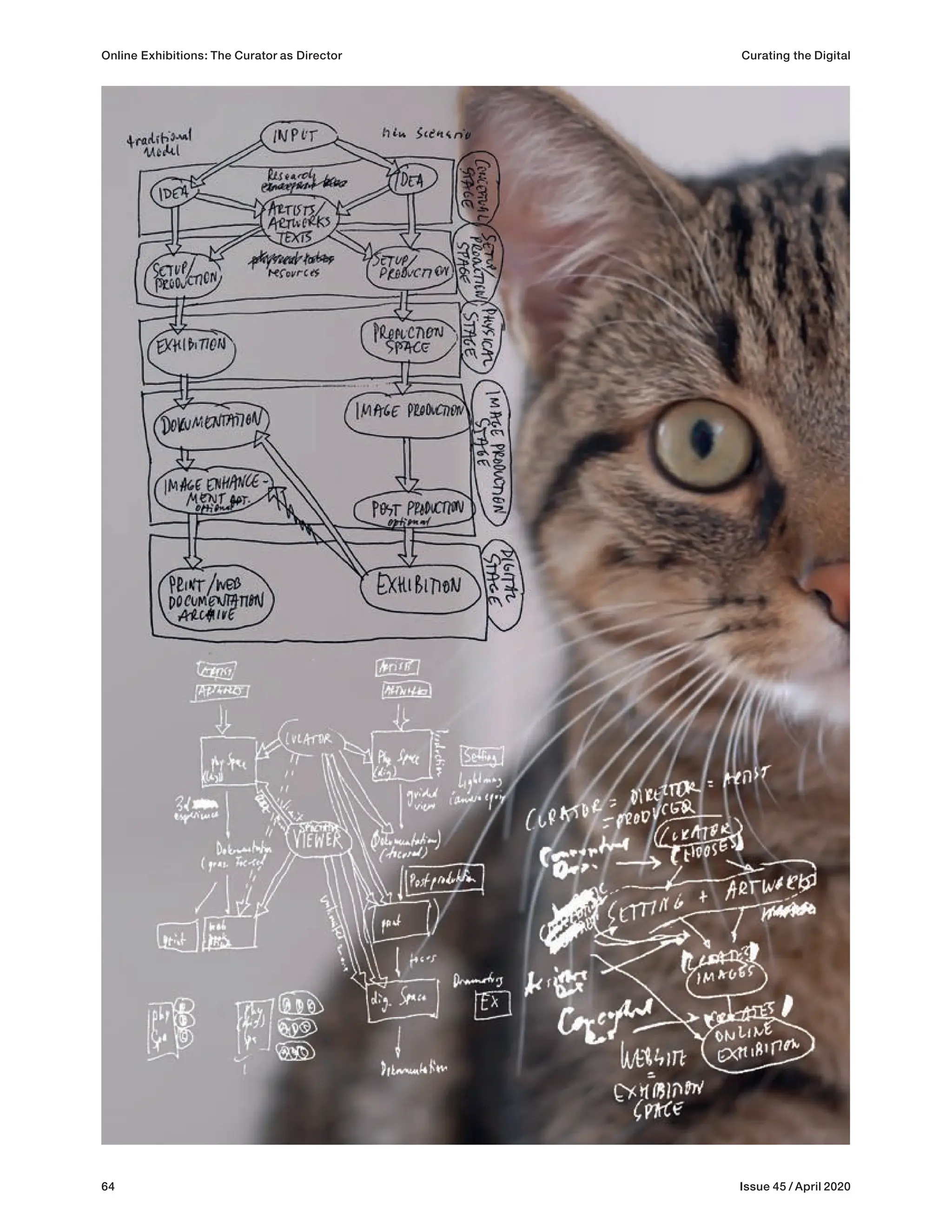
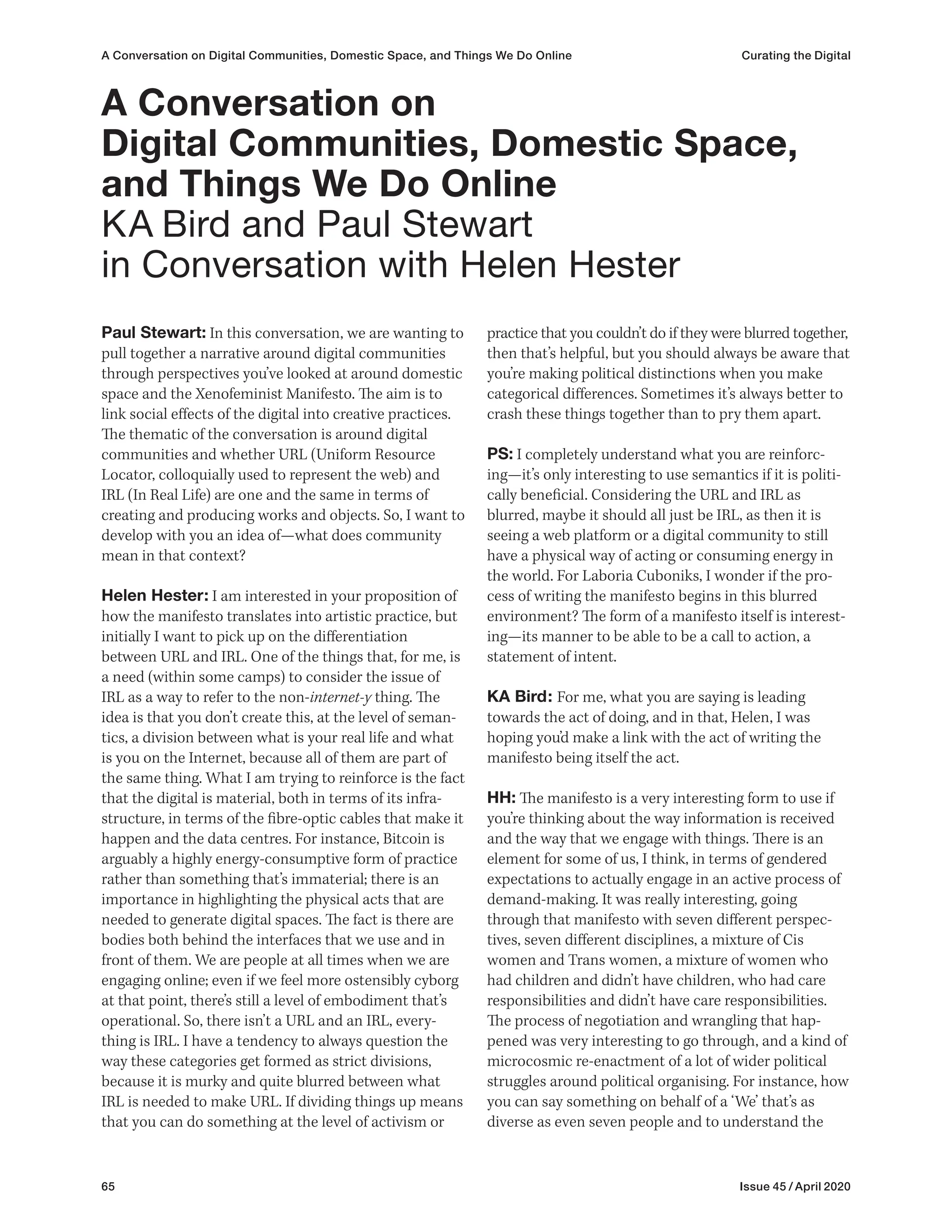
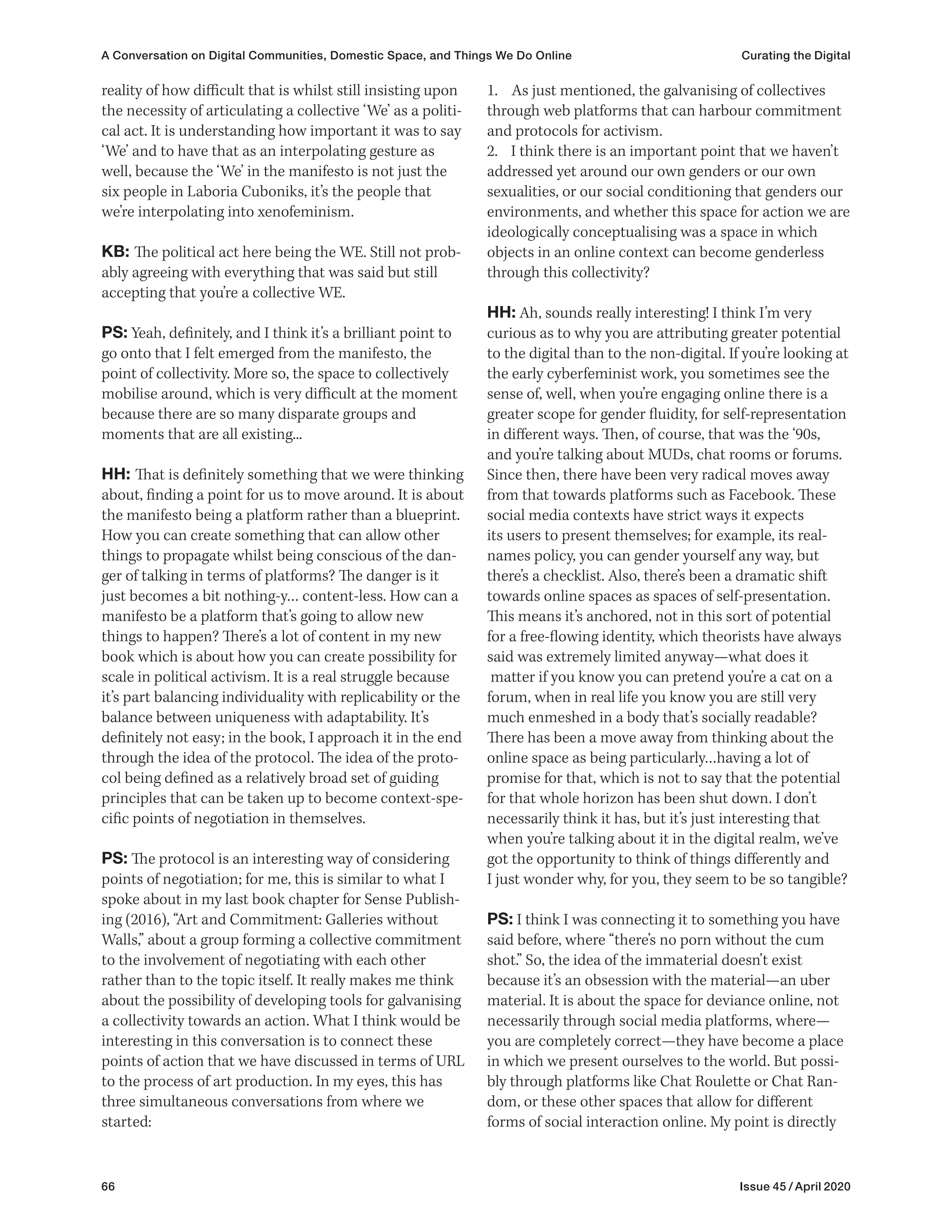

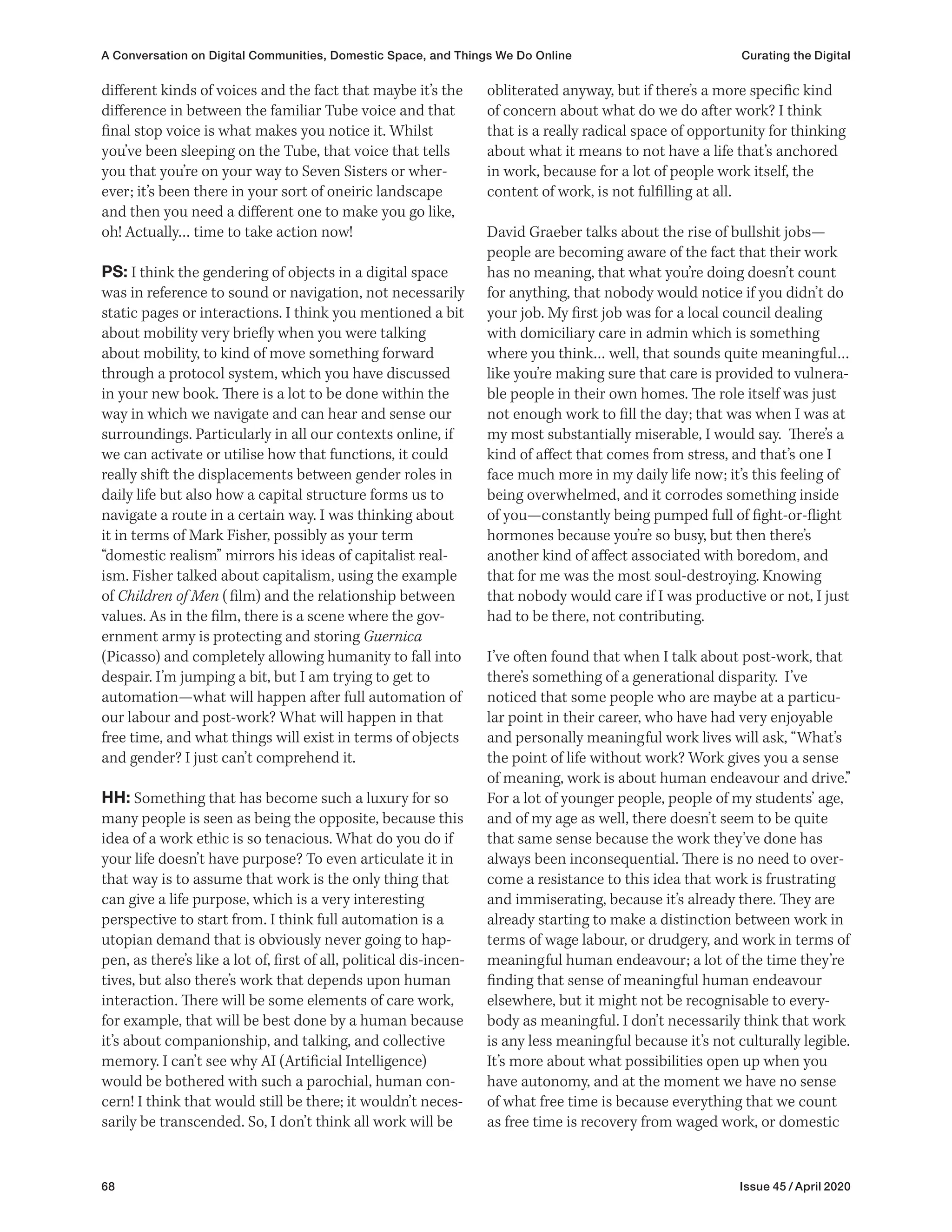
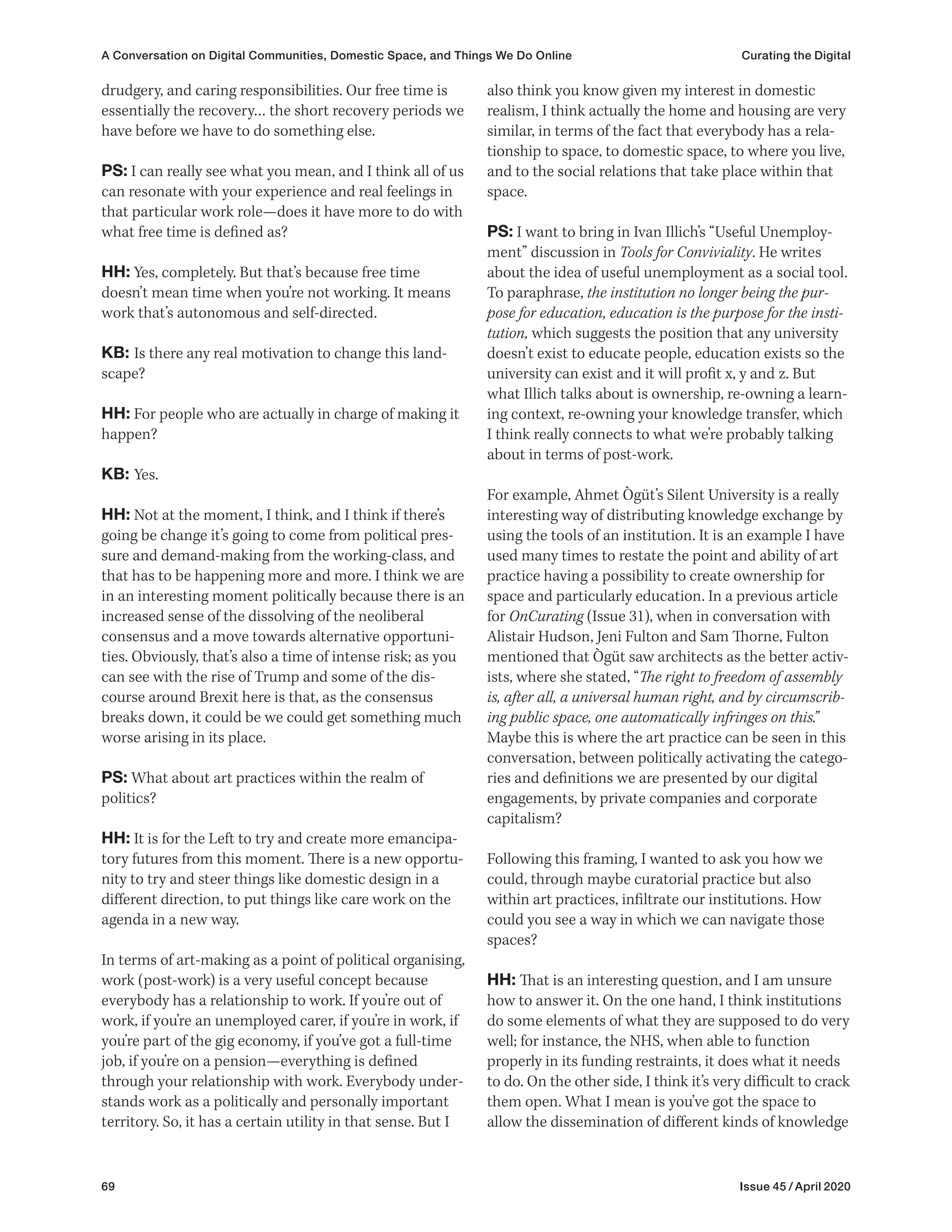
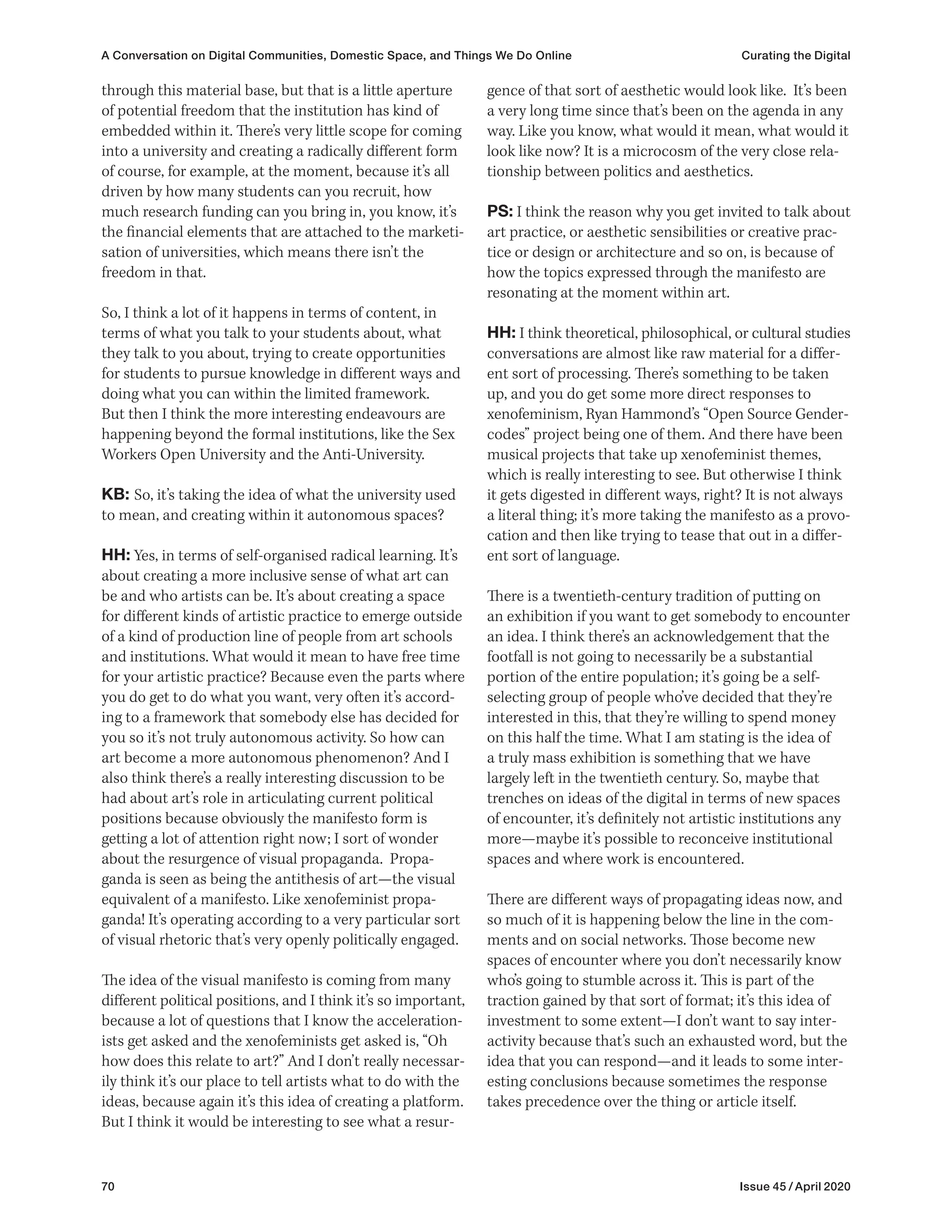
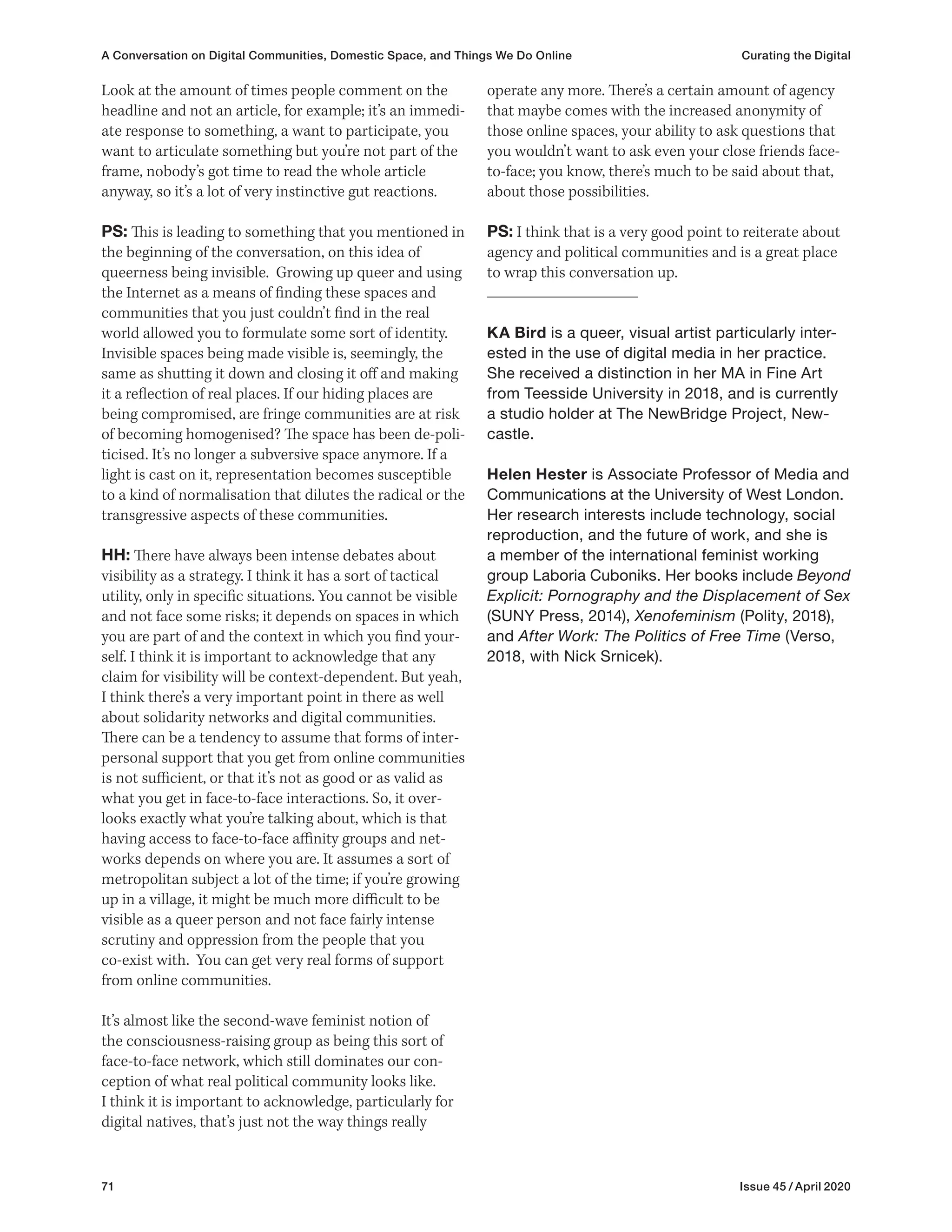
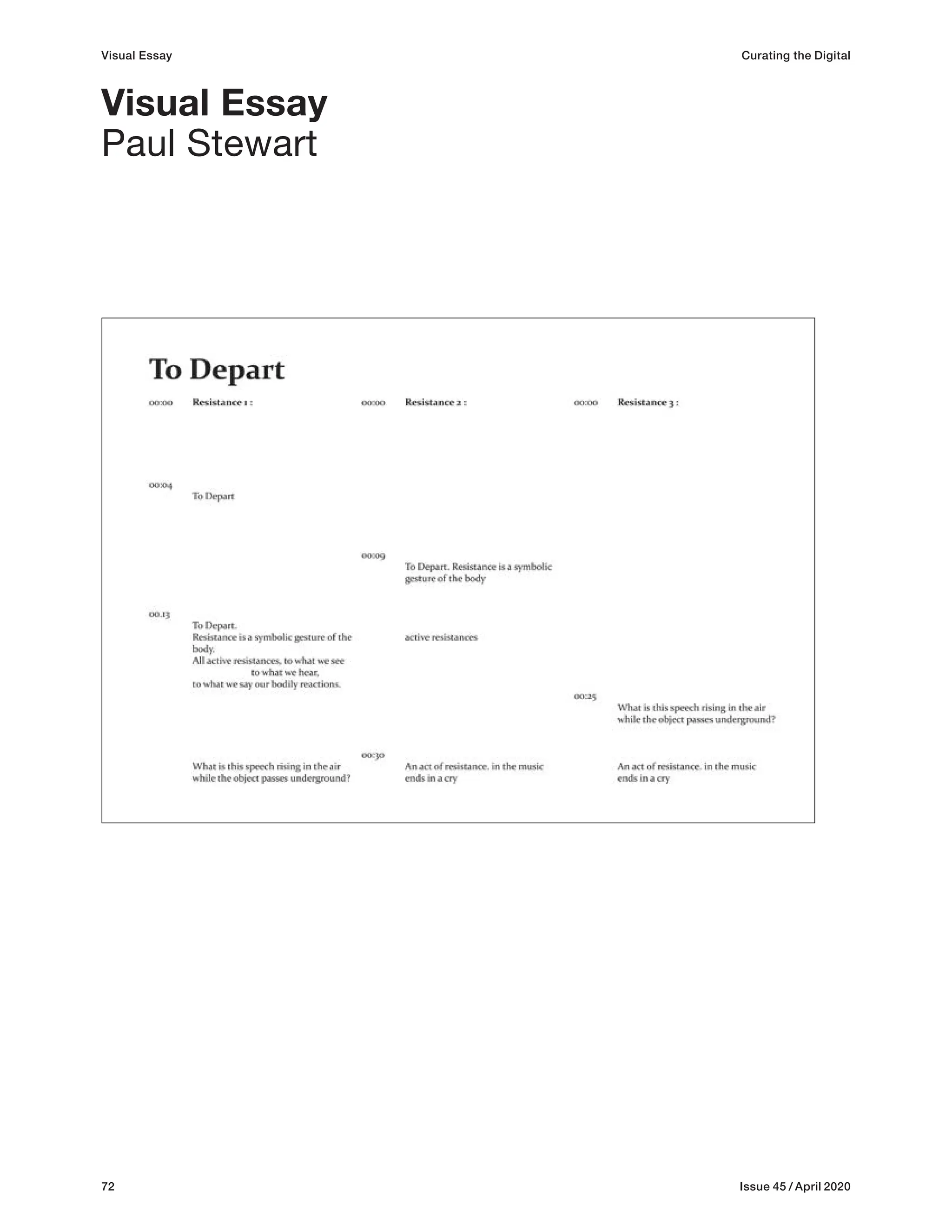
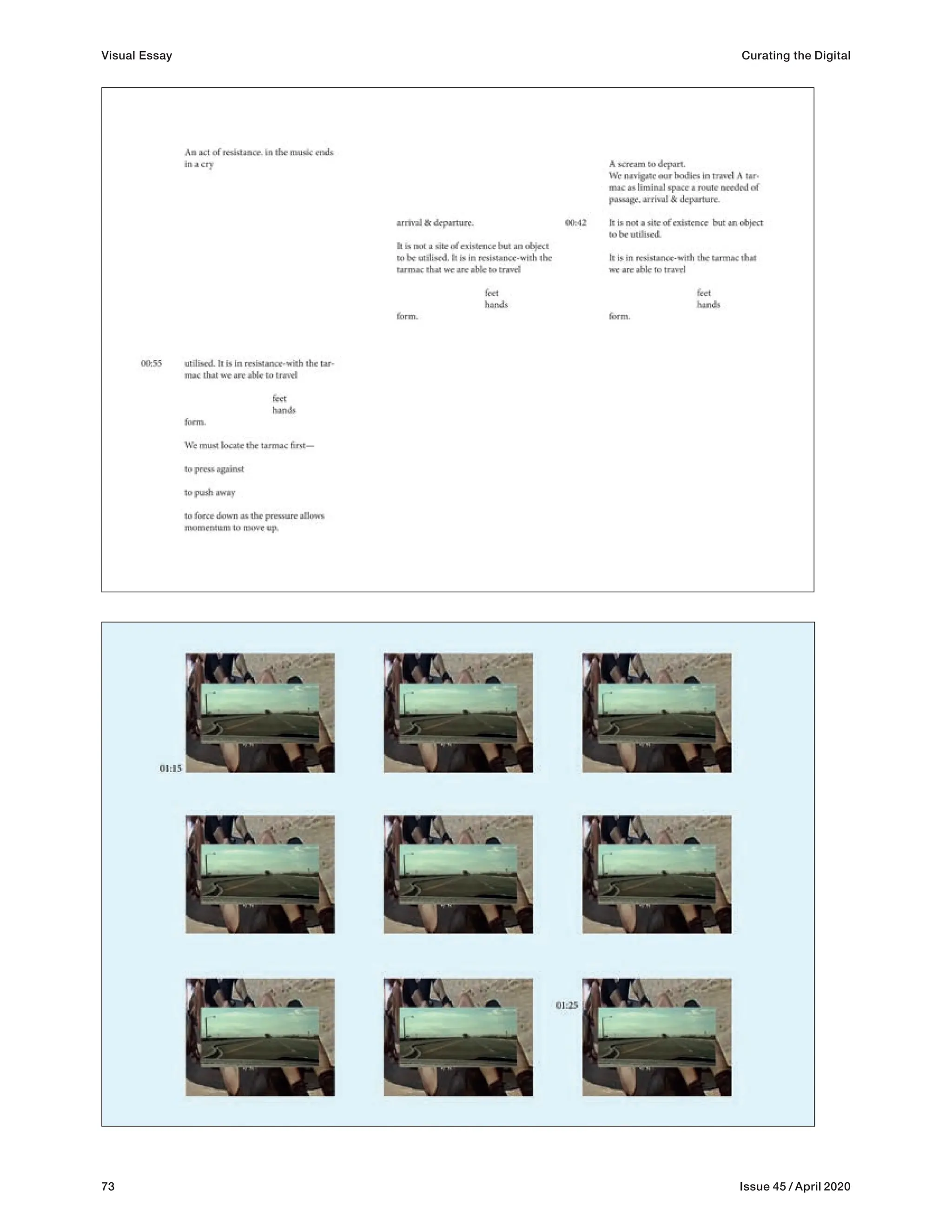
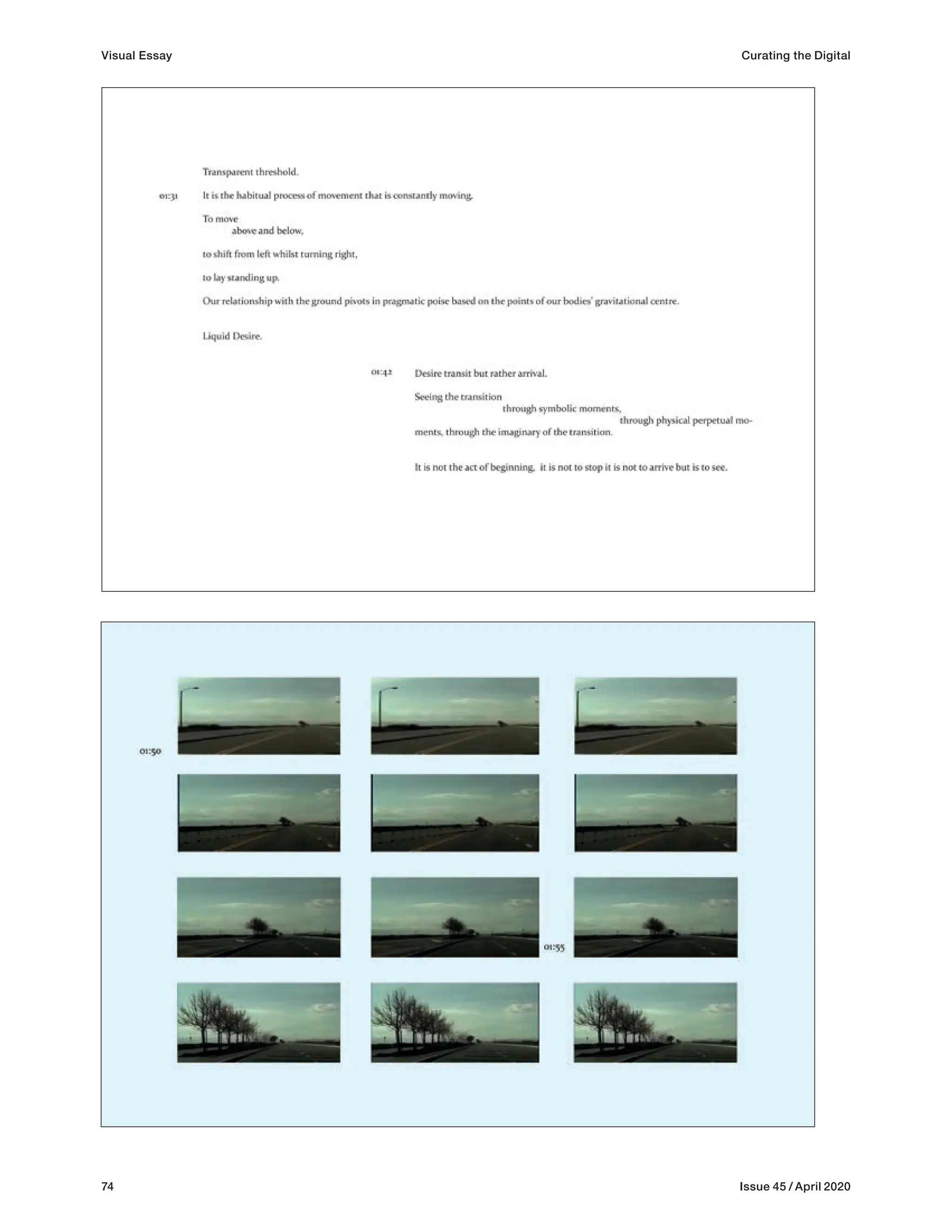
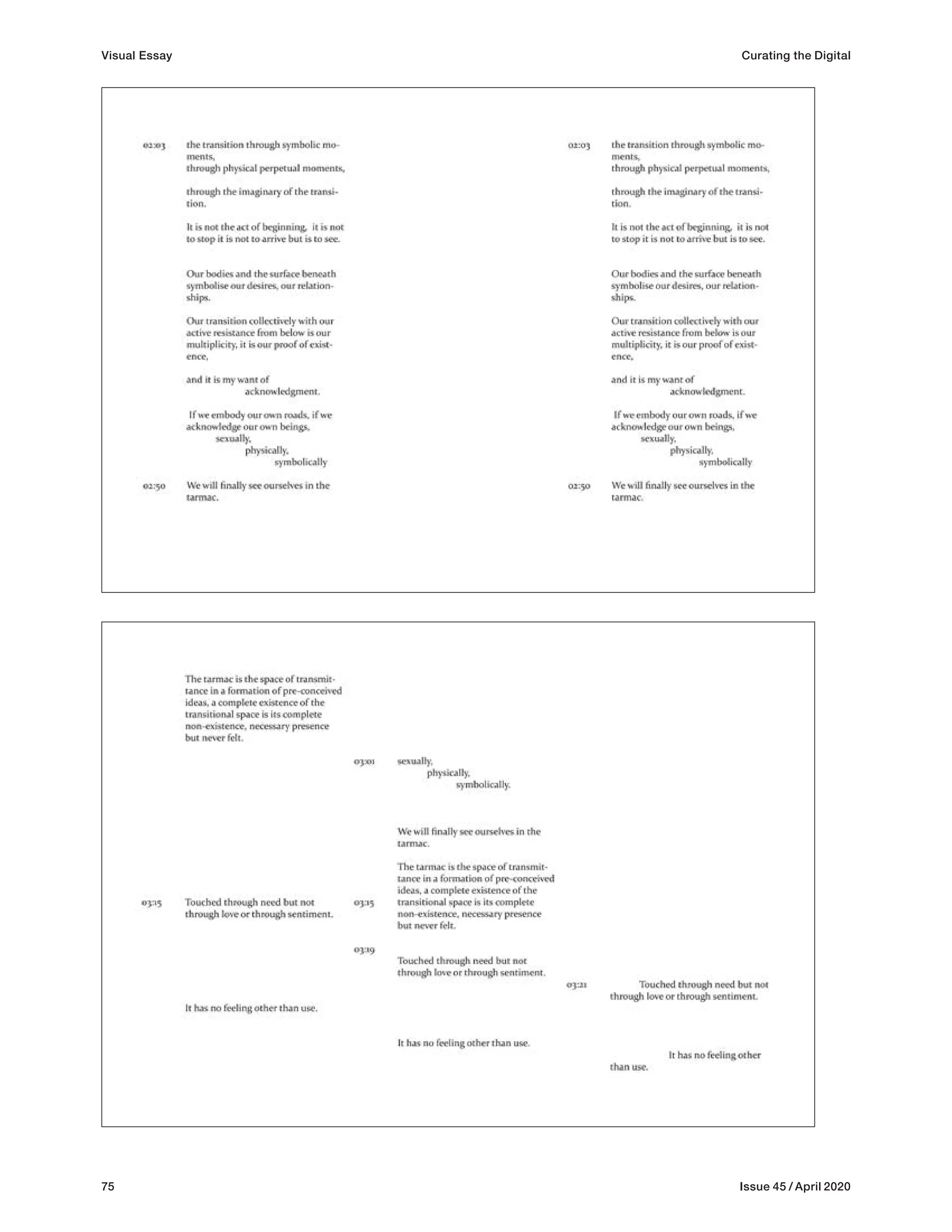


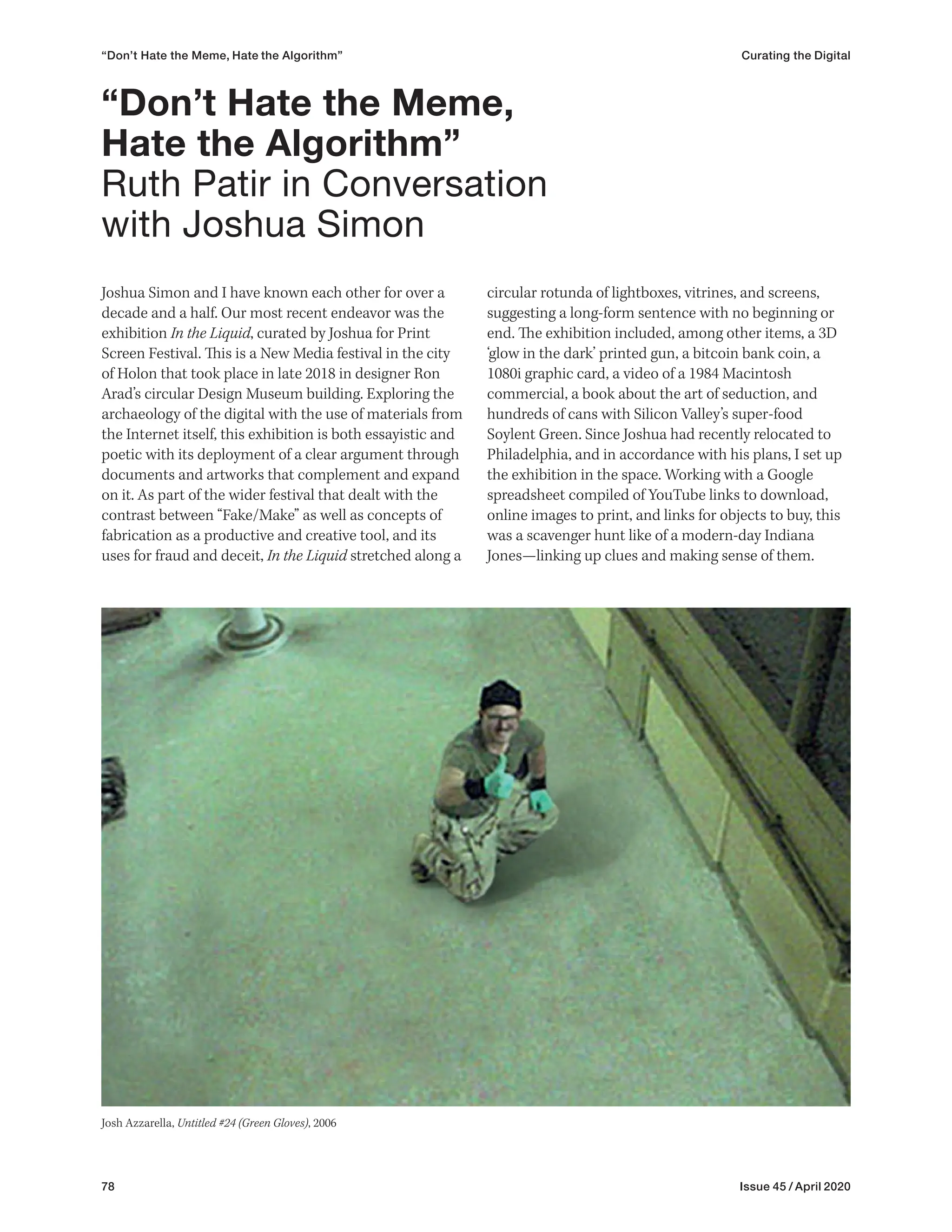

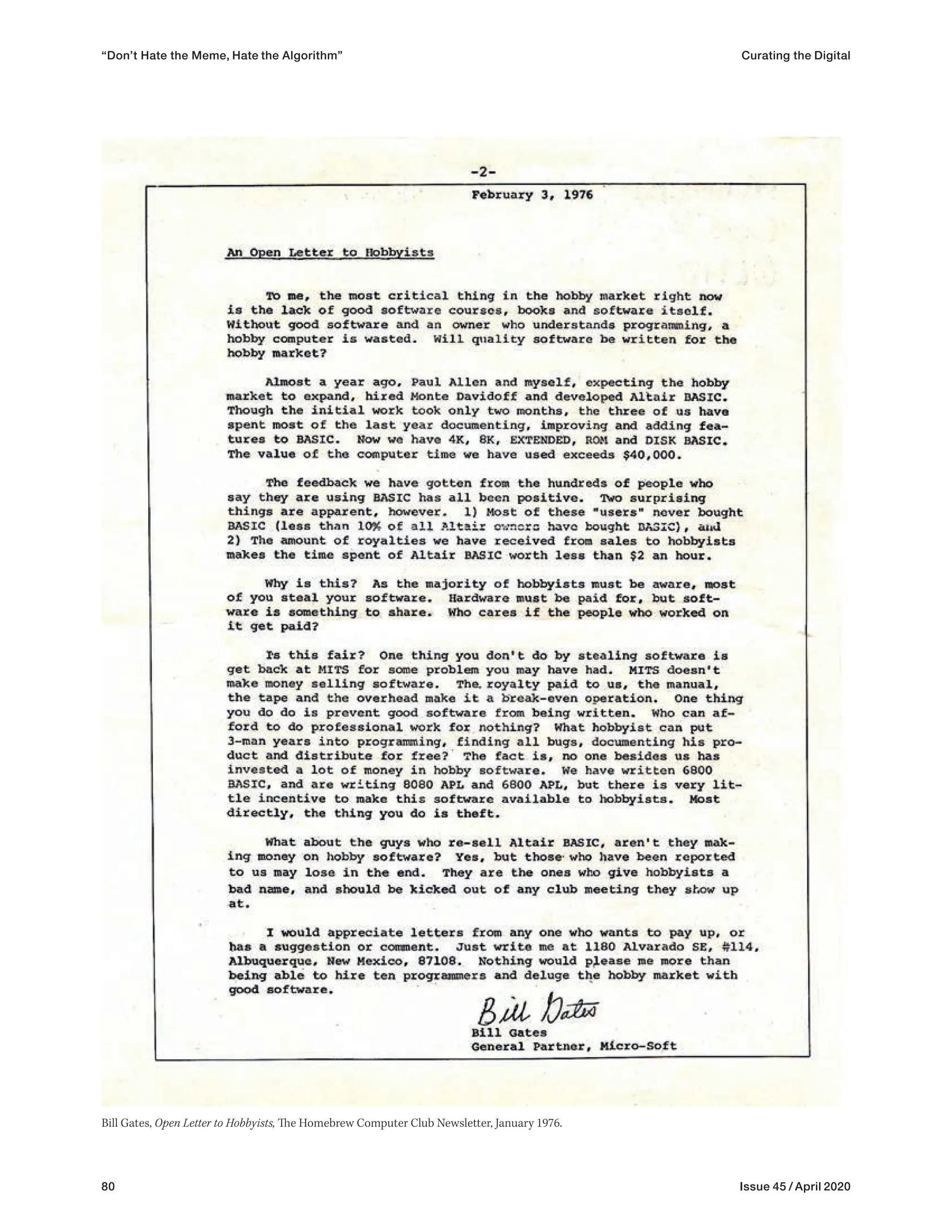
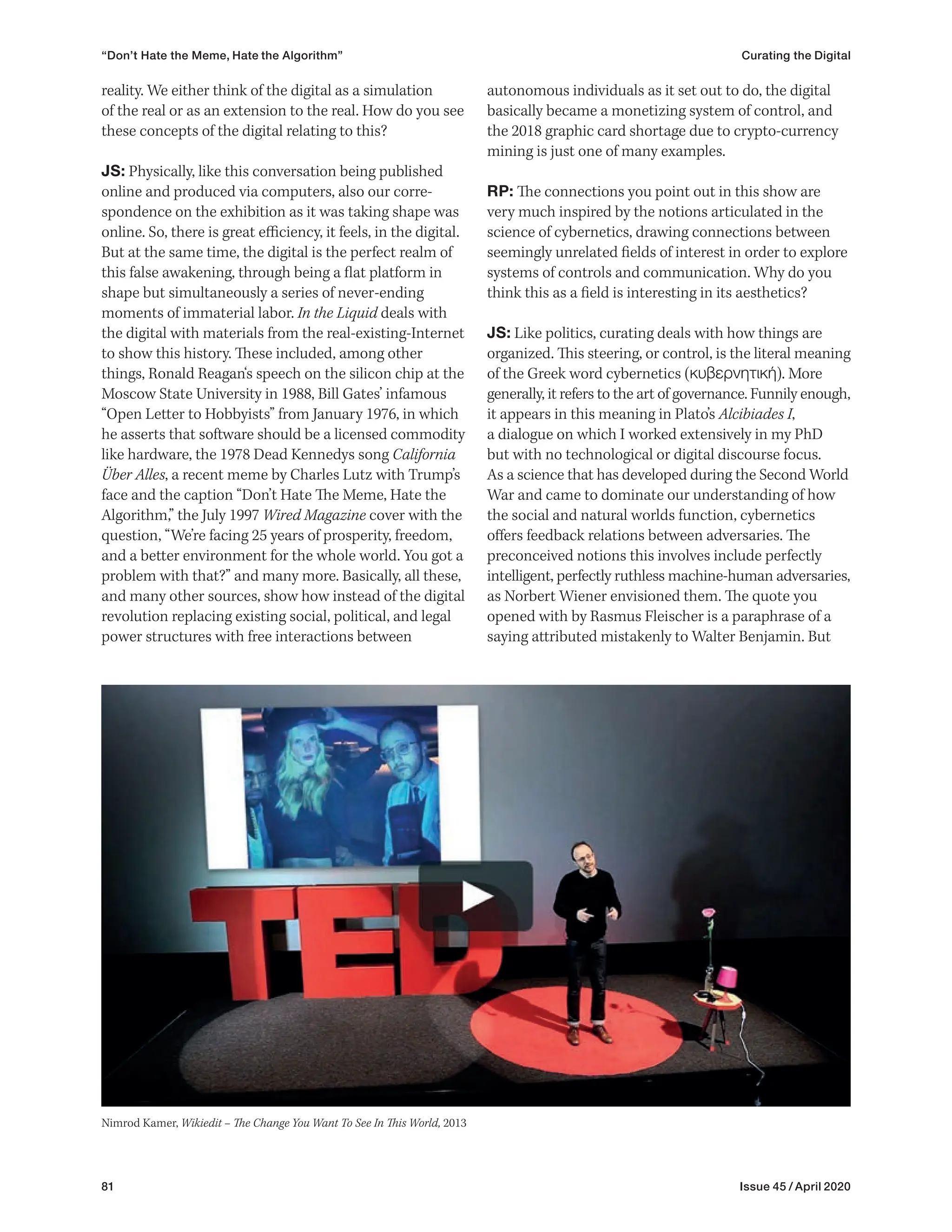

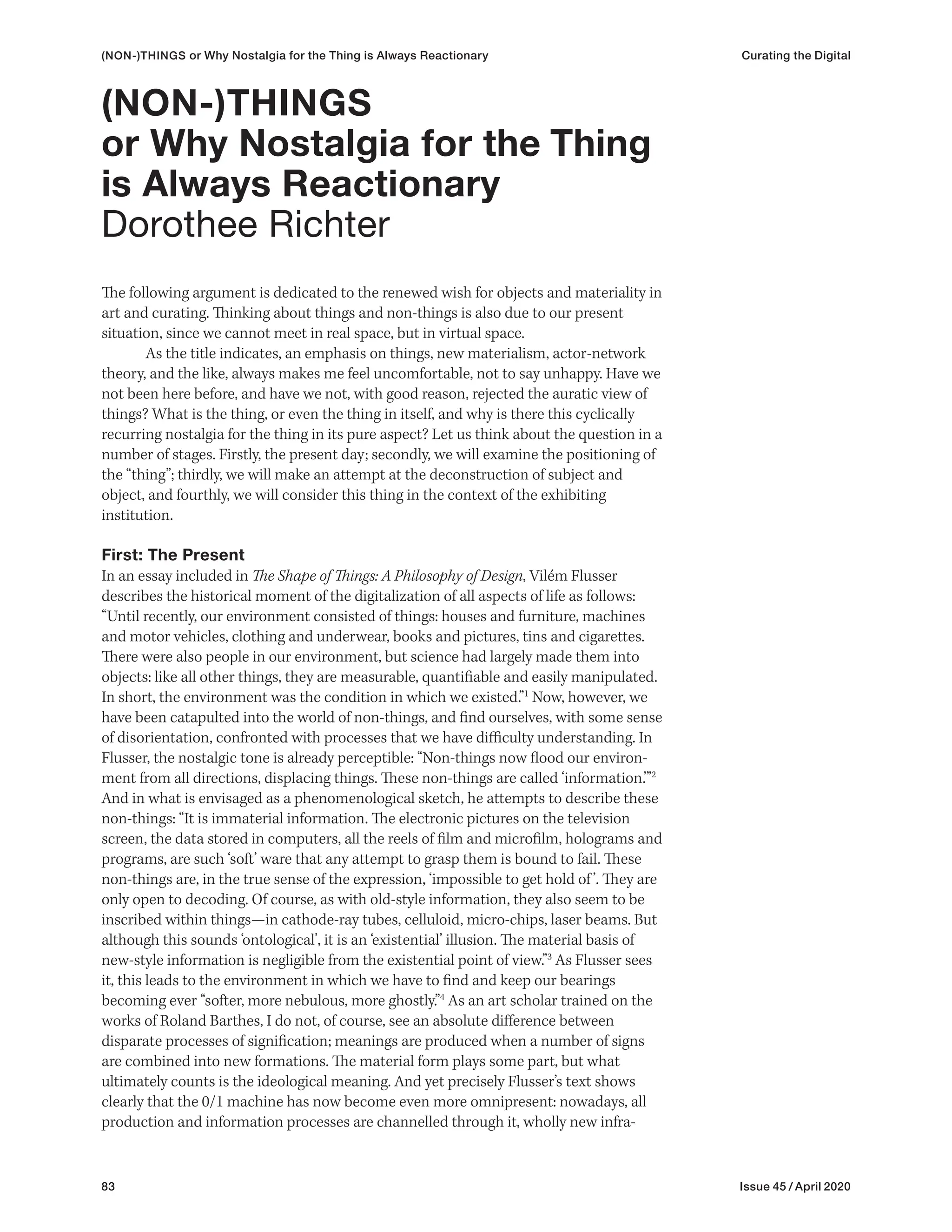

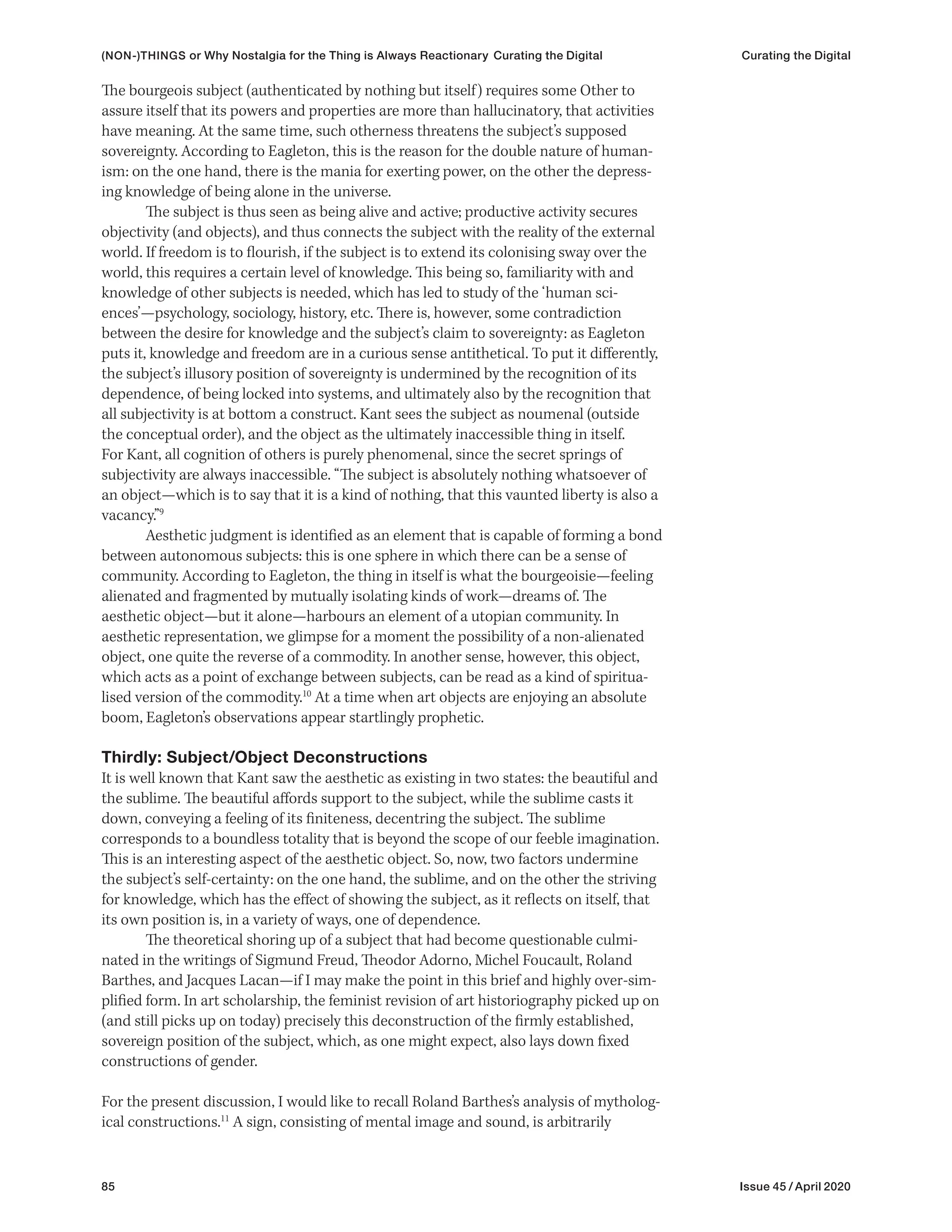

![87 Issue 45 / April 2020
in this light, the museum is a locus of the ‘thingization’ of objects—or, to follow Valéry’s
more cautious formulation, a place where ‘thingizations’ are offered.”13
In Jacques Lacan’s writings, the thing appears in two states. Firstly, it appears as
extant in the symbolic order. “Only what is integrated in the symbolic order ‘exists’ [...],
since ‘there is no such thing as a prediscursive reality.’”14
Unlike Saussure and Barthes,
however, he sees the relationship between the signified and the signifier not as fixed
but as varying: the connection between acoustic image and mental image is subject to
constant changes. (And the dissolution of this connection would be a psychotic state.)
The second state of an object is the objet petit a, the object of desire which we seek in
the other.15
The objet petit a is the object which can never be attained, which sets desire
in motion; Lacan later calls it the “object-cause” of desire. The drives do not seek to
attain it, but rather circle round it. The surplus represented by the objet petit a is
surplus meaning and surplus enjoyment. “This concept is inspired by Marx’s concept
of surplus value; a is the excess of jouissance which has no ‘use value’, but persists for
the mere sake of enjoyment.”16
Thus, for Lacan, the object is a wish, a longing, an idea
that can never actually be realised, but that keeps desire alive (in the relationship
between subjects, that is to say, the desire for the other).
Fourthly: Things in the Museum—Their Framing
by the Exhibiting Institution
So, let us turn to the thing, which exists only in a discourse, or only intersubjectively,
and which is moreover taken and set in the specific frame of the exhibition situation.
What is the significance of the “framing” of the thing by the museum, or, one might
say, by the institution that represents Art? As is well known, Tony Bennett drew
attention to the fact that one of the aims of the bourgeois museum was to initiate its
visitors, especially members of the working class, to middle-class modes of behaviour.
Visitors to museums were instructed not to spit, not to whistle, not to be noisy, and so
on. Thus, it is clear that class-specific messages are an intrinsic part of the museum.17
Modernist glass buildings, which place the visitor-subject in situations affording an
overview, also reinforce the subject’s illusion of occupying a self-confident (that is,
View into the picture room during the exhibition Silence, 1988
(NON-)THINGS or Why Nostalgia for the Thing is Always Reactionary Curating the Digital Curating the Digital](https://image.slidesharecdn.com/curatingthedigital-231012212646-a91382ef/75/Curating_the_Digital-pdf-88-2048.jpg)
![88 Issue 45 / April 2020
bourgeois-entrepreneurial) position. At the same time, the subject is visible from all
directions, and this in turn suggests that surveillance functions are being shifted to
within the subject, so that, as has often been argued, contemporary citizens monitor
themselves. The fact that a work of art is present in a museum or art institution means
that that object has passed through various acts of consecration. To adopt Foucault’s
argument, the discursive formation in a given instance—in this case the art academy,
art market, art criticism, juries, the curatorial selection process, etc., or, correspond-
ingly, anthropology and the authorities in that field—make use of complex mecha-
nisms to determine which objects belong in a museum and which do not. When these
objects then appear in the museum or art institution, they seem to be a “natural” part
of it. “Natural” in this case means that by being placed on a pedestal or in a lighted
glass cabinet, the objects are “ennobled.”
In contrast to this, a critical and democratic approach to museum work would aim to
acknowledge openly the constraints and structures within which it operates, and to
broaden and shift existing conditions implicit in museum work such as exclusions on
racist and sexist grounds. There are some very successful examples of such an
approach, some of which I would like to describe.
Michael Fehr vividly describes how, as the new director of the Osthaus Museum in
Hagen, he attempted to transpose to the museum John Cage’s Music Score (which
became famous as 4’33”) under the title SILENCE. At first, Fehr had hoped to work
directly with Cage, but after Cage left Germany, Fehr unexpectedly found himself
“without a supportive or protective artistic authority to back me up—unexpectedly in
a kind of artistic mode [myself] [...].”18
For Fehr, this was the start of a programme that
made reference to Hagen’s history and repeatedly took the town as its theme—not
always to the delight of visitors and the press, as Fehr notes. Visitors were forced out of
their comfort zone when they came to the museum, as the usual conventions were
subverted. Fehr gives a graphic description: “The exhibition [SILENCE] showed a
completely emptied museum: with the help of a workman I had, on the afternoon
before the exhibition opened, removed everything that was in any way pictorial from
the exhibition spaces, and we even dismantled the fountain and some lights that
picked out details of the architecture.”19
The three-day exhibition provoked a mixed
and sometimes vehement reaction, but the surprising thing was that the visitors now
started talking about artworks and types of architecture. “What emerged from it all
was not only that, even outside the sphere of music, John Cage’s 4’33’’ concept [...] is far
more than a formal idea, which is how I too had regarded the piece up to then, but
that SILENCE, viewed and deployed as an artistic strategy, can produce quite disparate
‘noises’ or ‘texts’, depending on the particular context—in this case the building’s
history, which during the exhibition was practically oozing out of the walls, or was
being projected on to the walls by the visitors.”20
Fehr goes on to analyse, above all, the role of memory as a narrative (and, I
imagine, divergent) event taking place at any given present moment, and also the
curatorial strategies he uses to reveal different layers of historical occurrences.
However, what I consider important here is a different aspect, which I believe can
trigger processes that lead to insight: the element of surprise, of disorientation, which
makes a person’s confidently held view begin to falter, as in the famous example of
anamorphosis in the painting The Ambassadors by Hans Holbein the Younger 1533,
which Lacan discusses. In the Lacanian example, the skull suddenly became visible
when visitors turned back for a last look as they moved on, an unsettling experience
that confronted them with the final, irrevocable splitting of the subject, namely their
own death. This is, in Lacanian terminology, the irruption of the Real.
(NON-)THINGS or Why Nostalgia for the Thing is Always Reactionary Curating the Digital Curating the Digital](https://image.slidesharecdn.com/curatingthedigital-231012212646-a91382ef/75/Curating_the_Digital-pdf-89-2048.jpg)
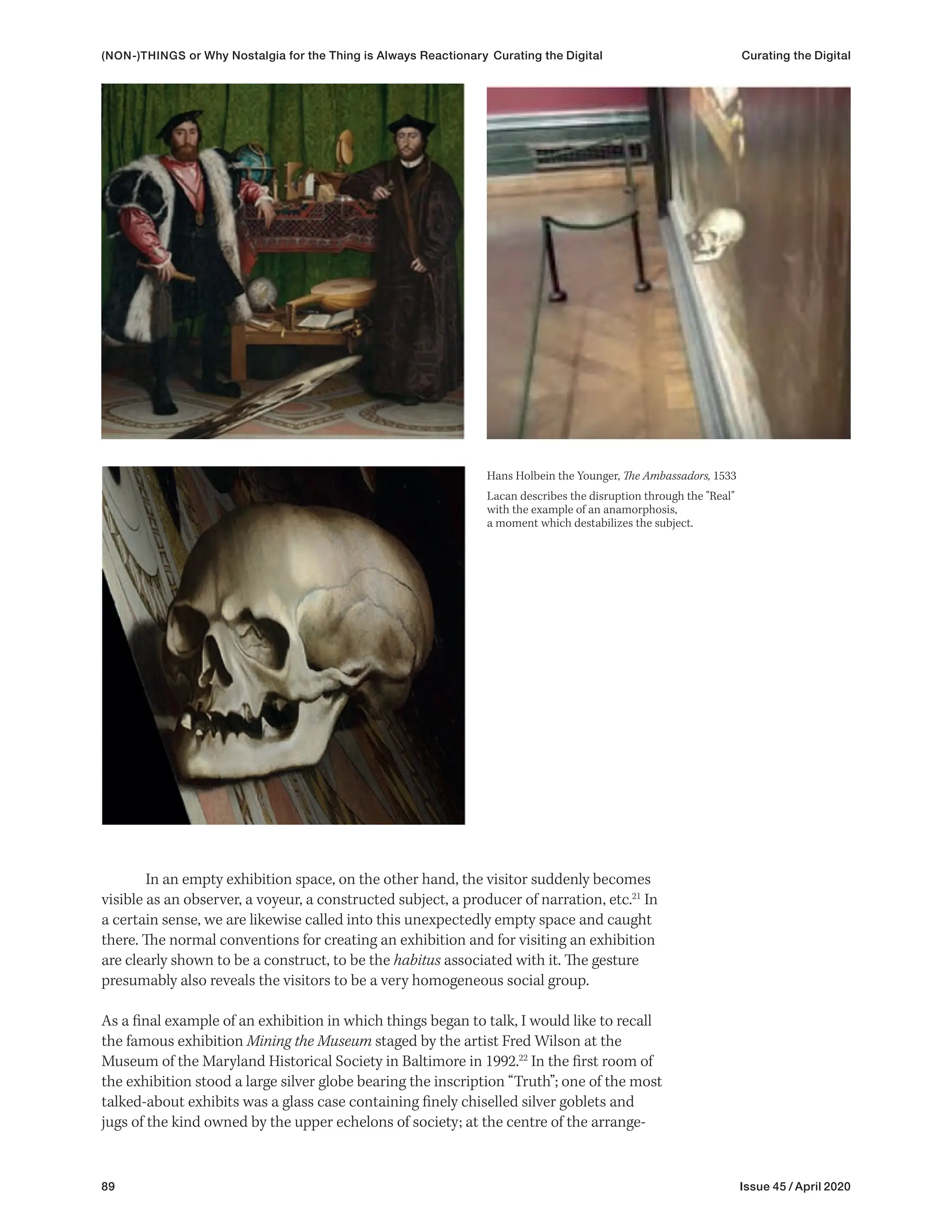
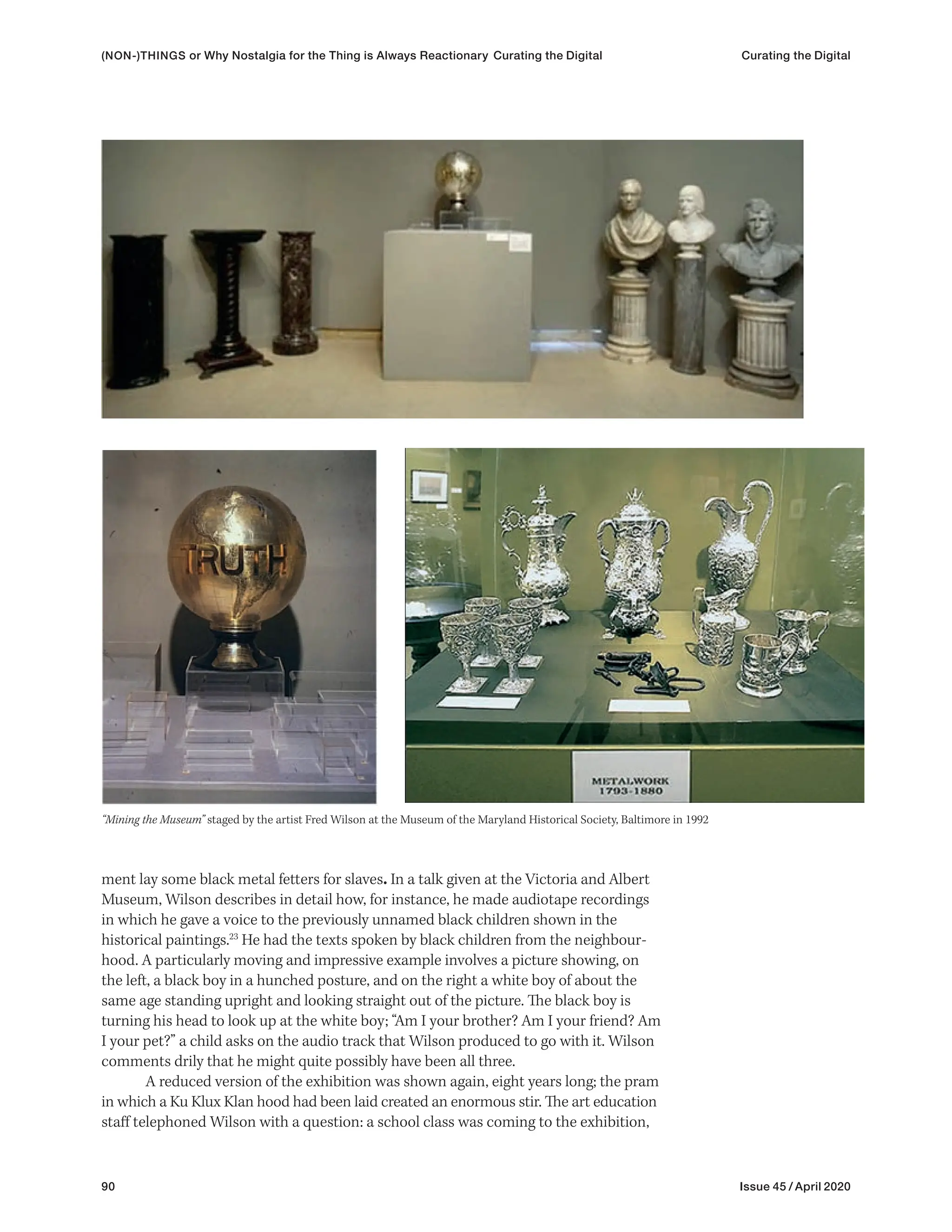

![92 Issue 45 / April 2020
“The hard facts are that Bell helicopters are manufactured by the Fort Worth corpora-
tion Textron, a major U.S. defense contractor, which supplies the Bell and Huey model
helicopters used against the civilian populations of El Salvador, Honduras, Nicaragua,
and Guatemala. But because the contemporary art of exhibition has taught us to
distinguish between the political and the aesthetic, a New York Times editorial entitled
‘Marvelous MOMA’ was able to say of MOMA’s proud new object: ‘A helicopter,
suspended from the ceiling, hovers over an escalator in the Museum of Modern Art [...].
The chopper is bright green, bug-eyed and beautiful. We know that it is beautiful
because MOMA showed us the way to look at the 20th century.”24
To come back to the beginning, the problem about a phantasmatic agency ascribed to
objects (be that as New Materialism or as actor-network theory) is the blurring of
structural violence. We as artists, curators, and theorists have to ask in which contexts
do objects produce which meaning. And who is the actor in this constellation. Who is
producing meaning, and who is the benefactor of a situation. The longing for material-
ity, for an object one could grasp, is due to the fact that through the overpowering
mass of digital images, and by the withdrawal of the unquestionable presence of
objects, and of other subjects, we all feel thrown into a shadowy co-habitation in time
and space. This will go on, with or without a virus, for quite some time. So, we must be
awake and discuss what images, artwork, exhibitions are putting forward. To do this
needs words, needs curating, needs art: therefore, I would like to recommend this
statement by Roland Barthes, as a starting point:
“Language is a skin: I rub my language against the other. It is as if I had words
instead of fingers, or fingers at the tip of my words. My language trembles
with desire.”
Bell-47D1 Helicopter hanging at MoMa, New York
(NON-)THINGS or Why Nostalgia for the Thing is Always Reactionary Curating the Digital Curating the Digital](https://image.slidesharecdn.com/curatingthedigital-231012212646-a91382ef/75/Curating_the_Digital-pdf-93-2048.jpg)
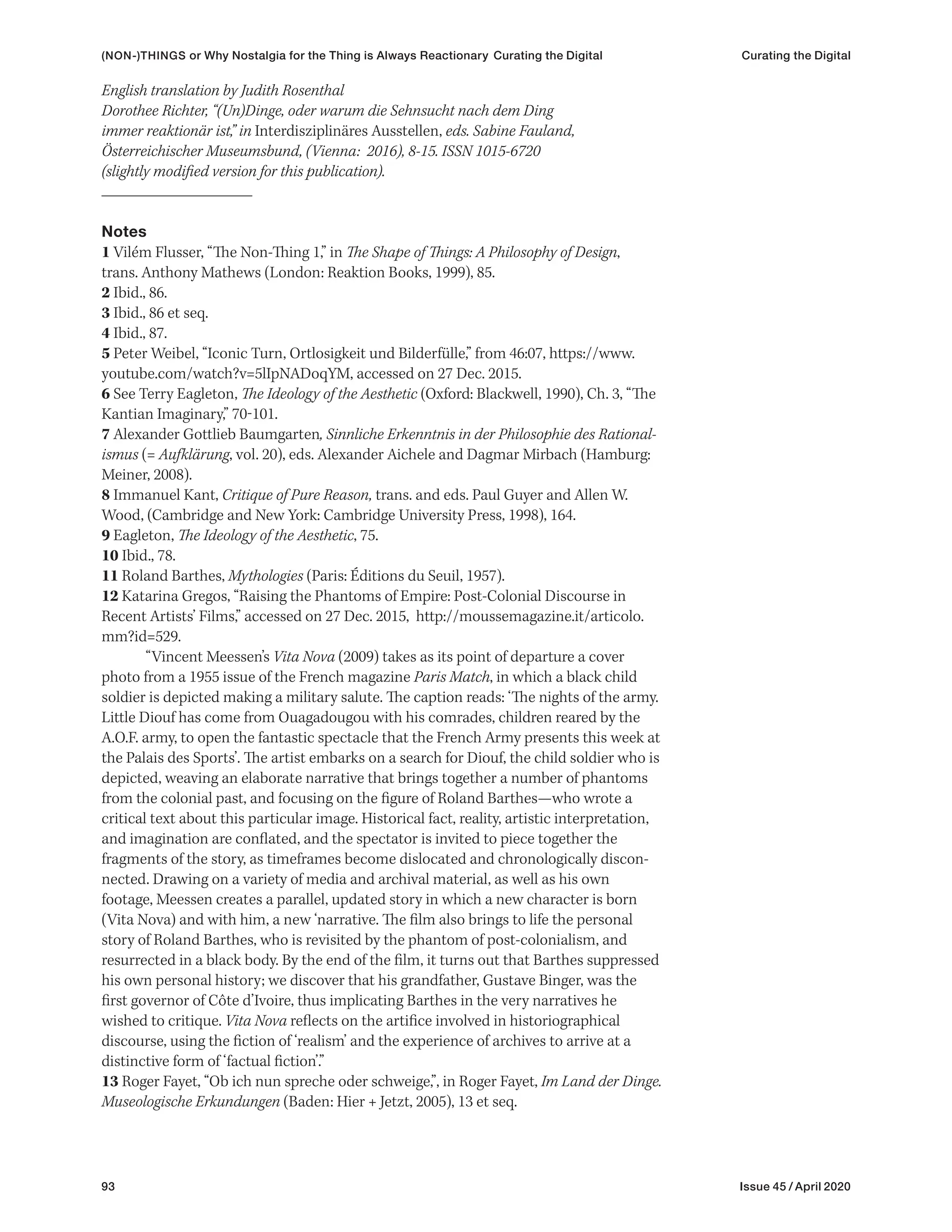
![94 Issue 45 / April 2020
14 Dylan Evans, An Introductory Dictionary of Lacanian Psychoanalysis (London and
New York: Routledge, 1996), 58.
15 Ibid., 124 et seq.
16 Ibid., 125.
17 Tony Bennett, The Birth of the Museum: History, Theory, Politics (London and New
York: Routledge, 1995).
18 Michael Fehr, “Text und Kontext. Die Entwicklung eines Museums aus dem Kontext
seiner Geschichte”, in Open Box: Künstlerische und wissenschaftliche Reflexionen des
Museumbegriffs (Cologne: Wienand, 1998), 19.
19 Ibid., 20.
20 Ibid., p. 21.
21 Lacan describes the effect of anamorphosis as follows: “It is, in short, an obvious
way, no doubt an exceptional one, [...] of showing us that, as subjects, we are literally
called into the picture, and represented here as caught.” Jacques Lacan, The Four
Fundamental Concepts of Psycho-Analysis, trans. Alan Sheridan (London: Penguin,
1979), 92.
22 Elisabeth Ginsberg on Fred Wilson’s exhibition project, Mining the Museum, April 3,
1992 – February 28, 1993: “For instance, in the first room of the exhibit, the audience
was confronted with a silver globe—an advertising industry award given at clubs in the
first half of the century—bearing the single word ‘Truth’. The trophy was flanked by, on
the one side, a trio of portrait busts of prominent white men and, on the other side,
three empty black pedestals. The busts were of Napoleon, Henry Clay, and Andrew
Jackson. None of these worthies had ever lived in Maryland; they exemplified those
deemed deserving of sculptural representation and subsequent museum acquisition.
The empty busts were labeled Harriet Tubman, Benjamin Banneker, and Frederick
Douglass, three important African-American Marylanders who were overlooked by the
ostensibly ‘local’ institution.” See http://beautifultrouble.org/case/mining-the-mu-
seum/, accessed on 11 Jan. 2016.
23 Fred Wilson speaking at the Victoria and Albert Museum, “A Change of Heart—Fred
Wilson’s Impact on Museums”, https://vimeo.com/11838838, accessed on 11 Jan. 2016.
The curator of The Contemporary referred to by Fred Wilson was Lisa Corrin;
the founding director of The Contemporary was George Ciscle.
24 Douglas Crimp, On the Museum’s Ruins (Cambridge et al.: MIT Press, 1993), chapter
entitled “The Art of Exhibition,” 275.
Dorothee Richter is Professor in Contemporary Curating at the University of
Reading, UK, and head of the Postgraduate Programme in Curating, CAS/MAS
Curating at the Zurich University of the Arts, Switzerland; She is director of the
PhD in Practice in Curating Programme, a cooperation of the Zurich University of
the Arts and the University of Reading. Richter has worked extensively as a
curator: she was initiator of Curating Degree Zero Archive, Curator of Kuenstler-
haus Bremen, at which she curated different symposia on feminist issues in
contemporary arts and an archive on feminist practices, Materialien/Materials;
recently she directed, together with Ronald Kolb, a film on Fluxus: Flux Us Now,
Fluxus Explored with a Camera.
(NON-)THINGS or Why Nostalgia for the Thing is Always Reactionary Curating the Digital Curating the Digital](https://image.slidesharecdn.com/curatingthedigital-231012212646-a91382ef/75/Curating_the_Digital-pdf-95-2048.jpg)
